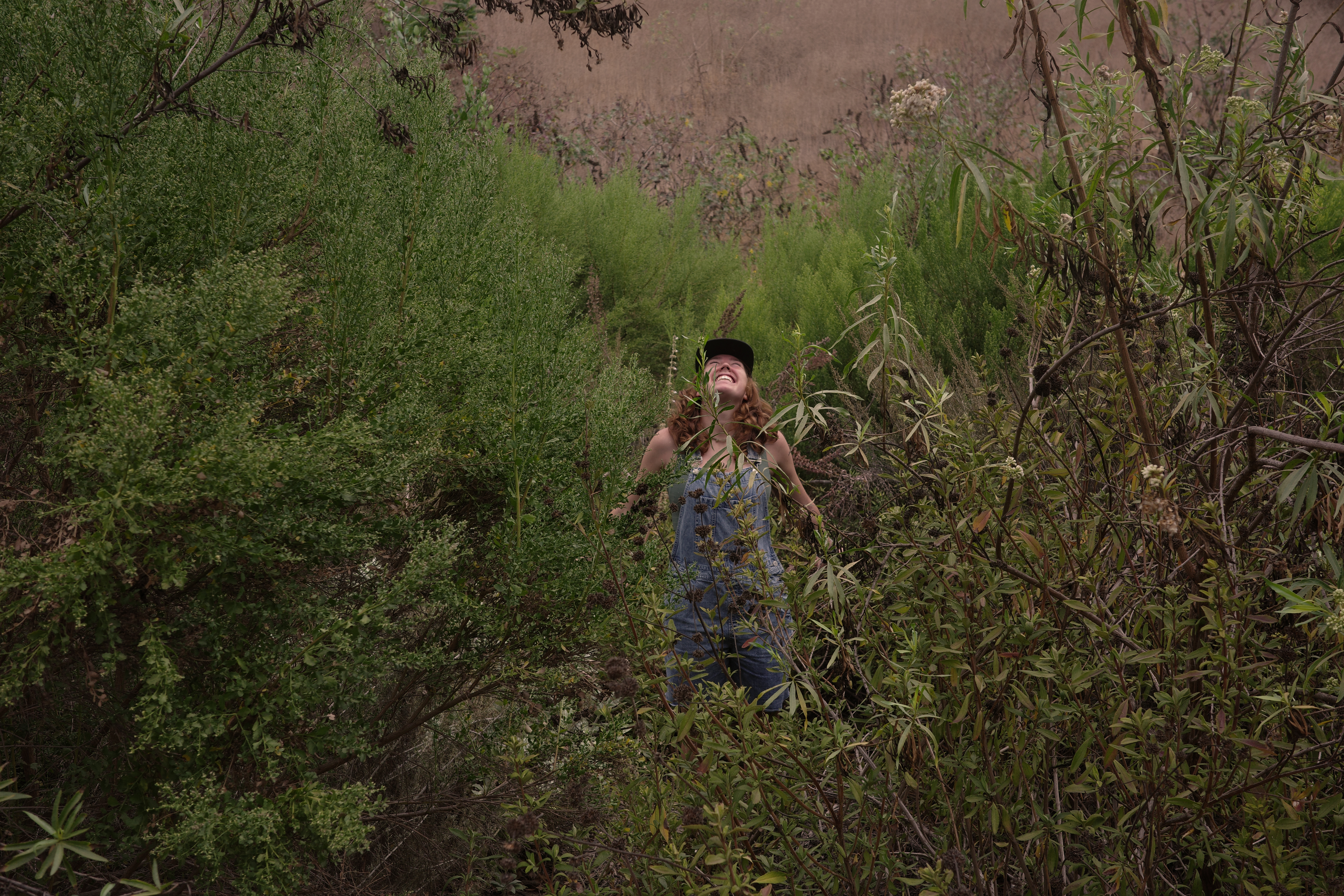
5 MONTHS WITH TEST PLOT
By Kaitlyn Ray
Cal Poly SLO landscape architecture intern
DATE: Dec 15 2025
ON ART + CARE....
There is art in stewardship, in smallness, in care, in recognizing how that art becomes inscribed on a place. In short, this is what I saw at Test Plot: art inscribed upon a landscape as a result of many hands who care about their common home and about each other. The soul in the land’s caretakers, the sweetness in their interactions, and the buzzing life that springs forth from it all. These, surely, are all metrics of an artful place.
Interventions need not be immediately impressive or very large to make a difference. Small, piecemeal interventions done with Great Care mean infinitely more in the scheme of social landscapes to be loved rather than simply admired. Such interventions reach success on account of their radical outpourings of care: investment in a place paired with a desire for it to be excellent. The land needs people who care about it, listen to it, and who can form a kinship with it. This idea of small kinship is actually very big and very meaningful; this, I have understood more than ever during these last five months at Test Plot.
ON A PRACTICAL NOTE....
I became intimately familiar with the plants on our plots, refining my understanding of their character beyond identification. I was involved in cataloging and mapping existing plants, setting up iNaturalist profiles, designing ethnobotanical plant tags, and creating a huge Test Plot plant list with useful attributes for stewards. These, among other tasks, allowed me to better understand the nuance and character of ecological interconnectedness, as well as where people + care fit into it all.
This interconnectedness, the relationality of plants with humans, with each other, and with the rest of the environment, became most evident during the plant list creation. Plant-human relationships revealed themselves through a study of naming, propagation, care, and ethnobotany. A study of plant communities, ecosystems, and reproduction became a lesson in plants’ relationships with each other. A late addition, what species the plant hosts, revealed how specific plants and animals interact with and rely upon each other. Each, in some way, informed the way I see how environmental relationships develop and sustain themselves. Plant-human, plant-plant, and plant-environment: each an ecotone, representative of immense richness and diversity that can only be found in their intersections.
Understanding this made the work of land restoration so much richer; rather than simply knowing and designing for the end result, I can know and design for the interconnectedness + relationality that precedes and produces that result. It is a necessary step back; in a way, it is a way to see the bigger picture. Though, paradoxically, this “bigger picture” exists in knowing the nuance of the smaller pieces that make up that picture. Maybe “smaller picture” is better vocabulary.
Naturally, this idea also plays out in the necessity of care and the respect for labor that goes into land restoration, a manifestation of the human-land (or terrapersonal as my dear friend Ruth puts it) relationality. This, too, is something that the good folks of Test Plot uniquely practice.
ON ANOTHER PRACTICAL NOTE....
I unexpectedly became familiar with web design, (a tiny bit of) coding, marketing, social media, volunteer management, spreadsheets, procreate animation, and laser cutting. Being in such a tiny company was incredible, as it afforded me a ton of unexpected problem-solving opportunities. Did I know how to do everything that Jen asked me to do? No! Did I eventually figure them out though? Most of the time, yes! This proved to be rather empowering; while I may not have known exactly how to accomplish some tasks, I felt increasingly confident in my ability to problem solve my way through them. I am certain that, even later in my career, I will never know how to do everything; for that reason, I am extremely grateful to have had the opportunity to leverage my inexperience as a way to learn and to grow in confidence.
ACADEMIC APPLICATIONS....
Working here was the first time I had really come to understand what a seed bank entails. The concept was fascinating enough to inspire a term research project comparing passive revegetation strategies using native seed banks and active revegetation strategies using calculated seed mixes.
The internship also sparked a newfound interest in ethnobotany (which is good, because I spent good, quality time with the La Esquinita tags) Our Fall studio project was located on Chumash land in Santa Ynez, and, after speaking with some tribal members at the local museum, I decided to explore ethnobotany as it relates to the Chumash culture. My proposal of an ethnobotanical “mother plant” garden responded to the joint tribal desires to revitalize pathways of TEK transmission and restore ecological integrity. That idea would not have been possible without having first learned how Tongva and Kizh peoples understood their community’s kinship with their environment.
As I embark on my senior thesis project, (eek, scary!) I am more influenced by the Test Plot framework than ever, particularly as it relates to the social dimensions of land care. My time at Test Plot made it clear to me that I want to work closely with local organizations + nonprofits + charities. I absolutely adored the social aspect of my work, and I found so much joy and purpose in attending events and workdays where people can come together for a purpose larger than the individual. Going forward, I want to continue practicing “human care through land care,” building upon it to include themes of interpersonal relationships and social + environmental justice.
TO CLOSE...
I want to express my gratitude for the entire Test Plot family. From graciously moving my first interview while I was in Nepal to not be at 2am, to letting me hold onto the internship for three months longer than agreed upon, and every micro-lesson in between, they have truly been a blessing. I am exceptionally thankful for the last five months, for every lesson and wise bit of knowledge that Jen has gifted to me, and for the groundedness + care which I look forward to taking into my career. Thank you Test Plot, I love ya!
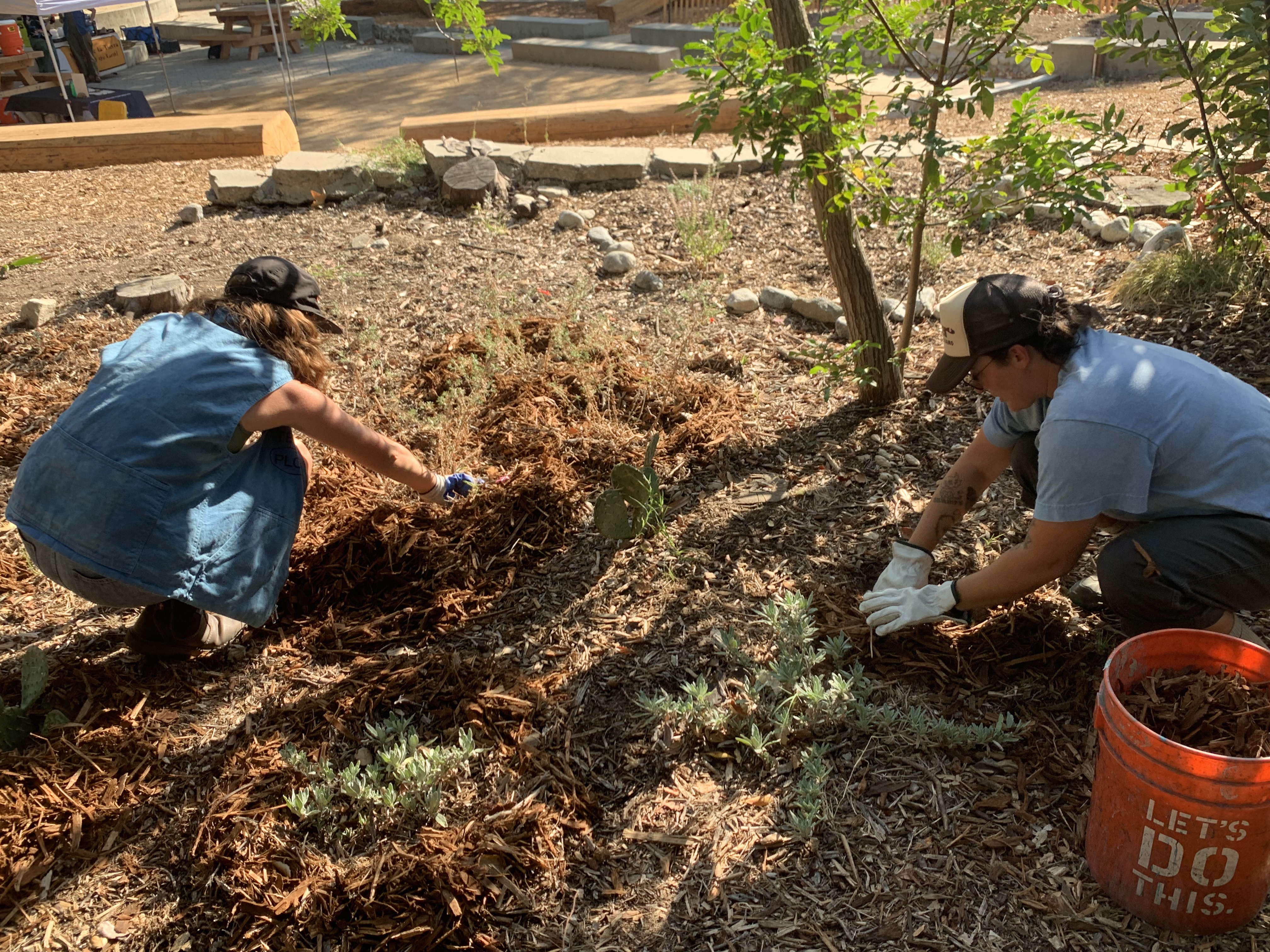



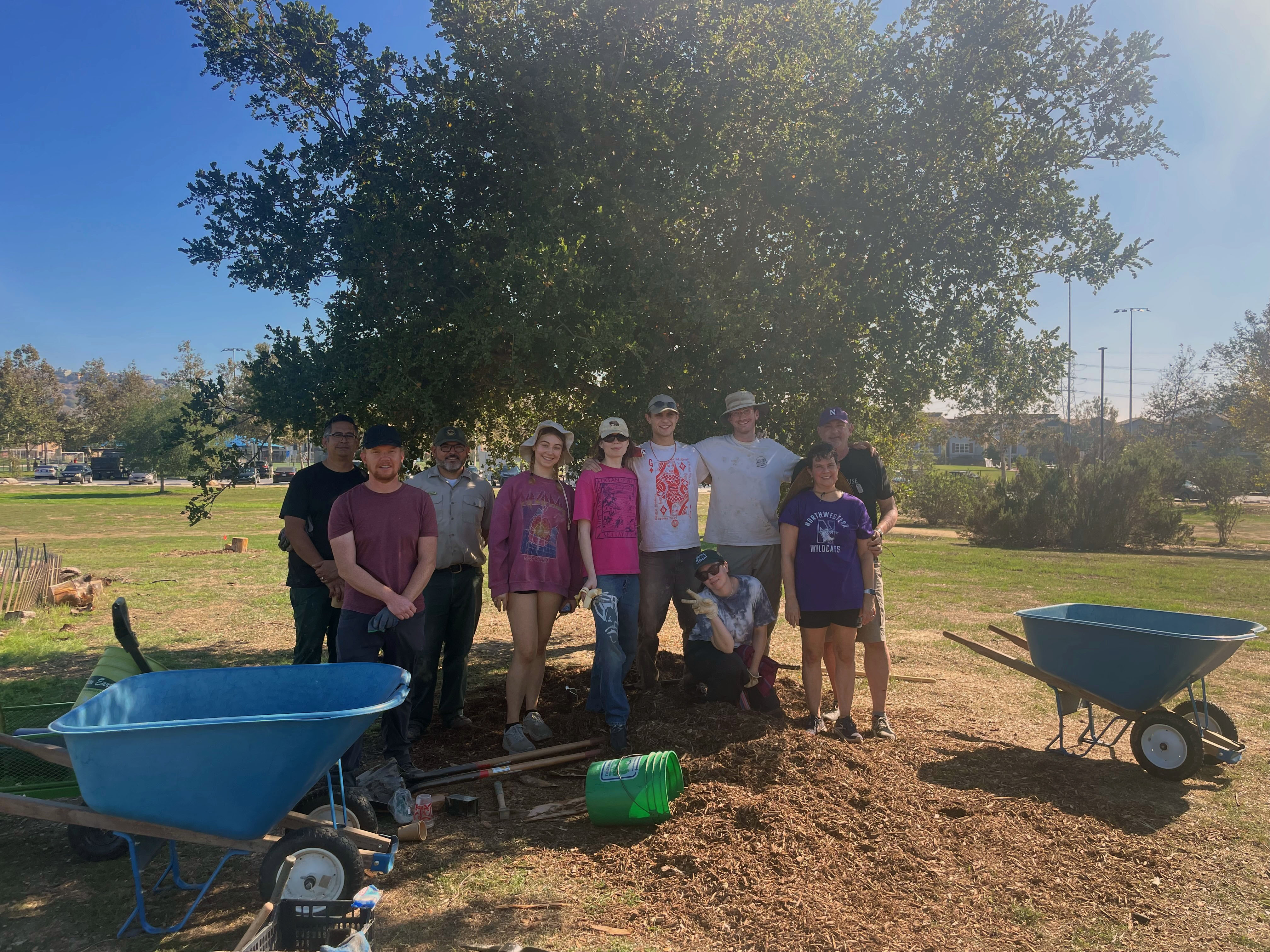
PLANTING AN OAK GROVE
Rio de Los Angeles Test Plot
By Tom Hurst
DATE: Nov 09 2025
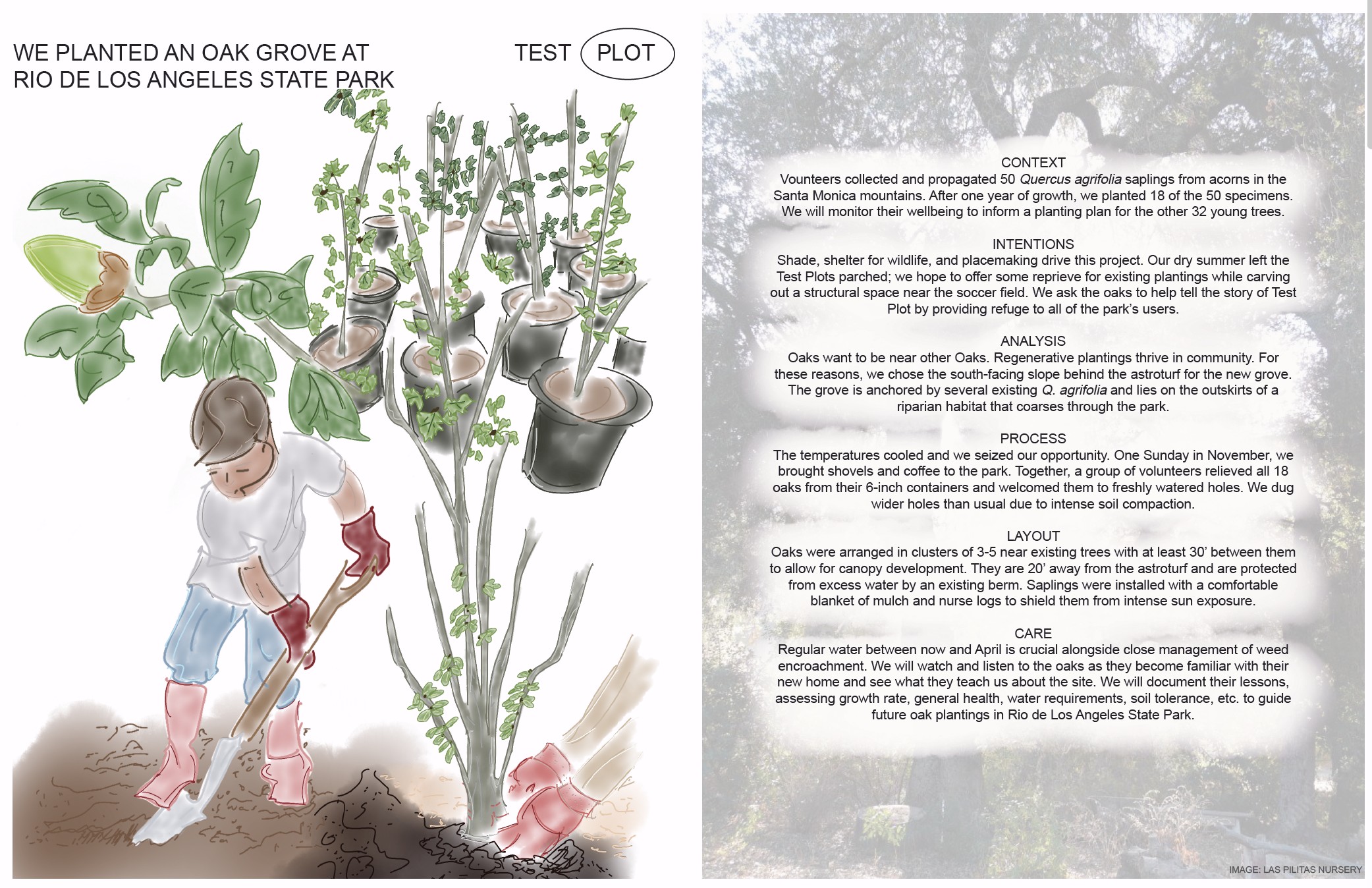
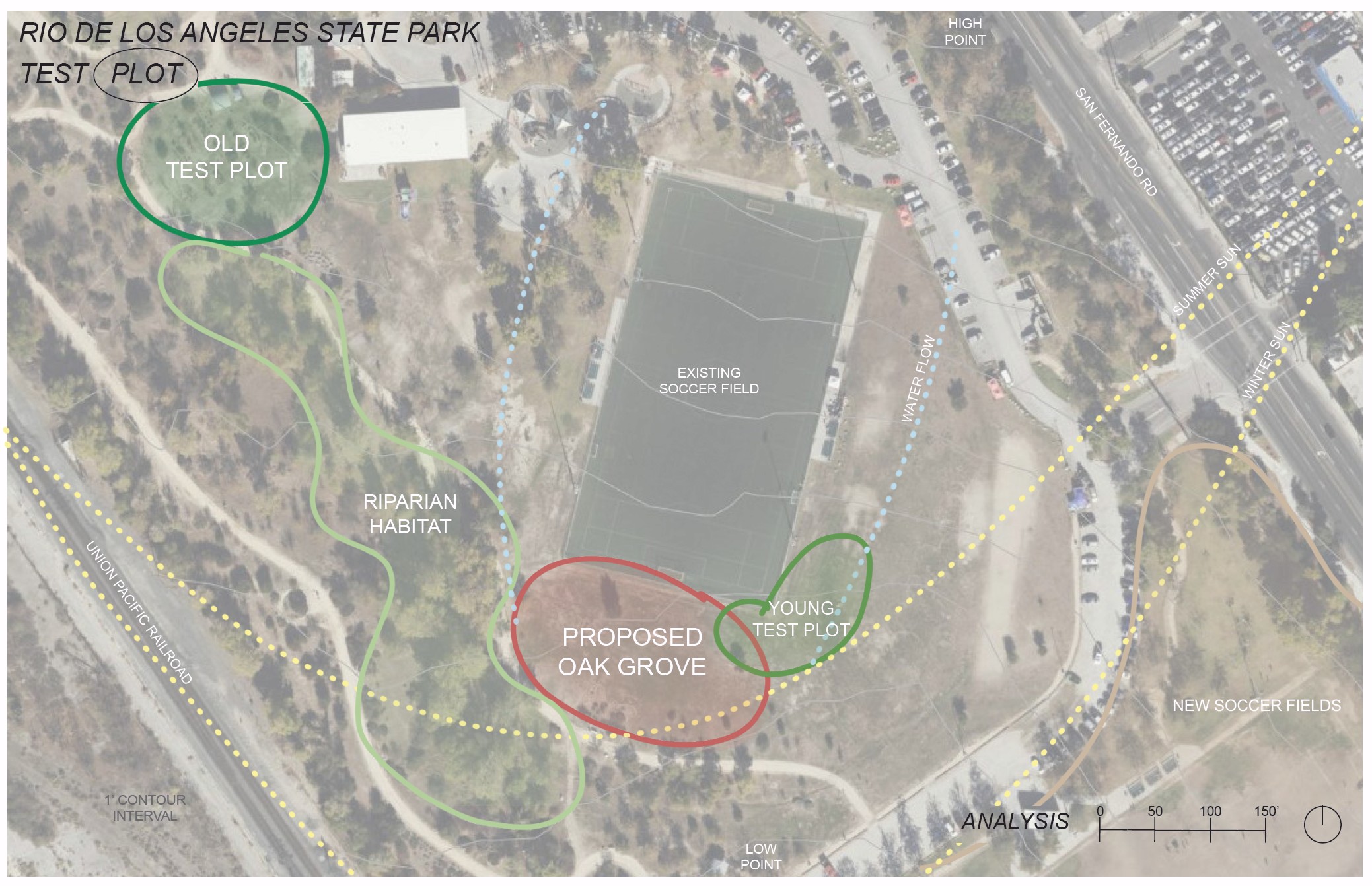
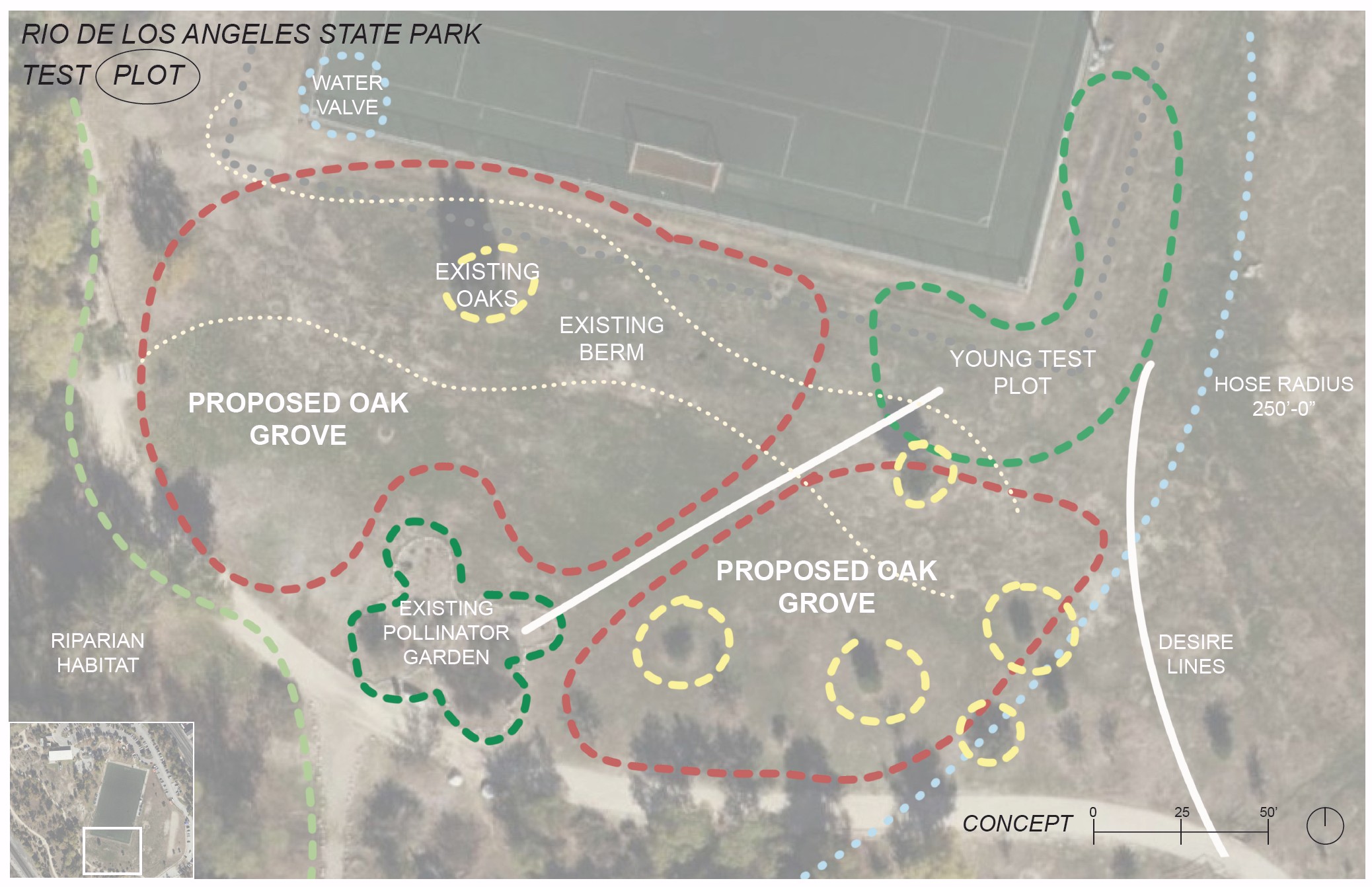
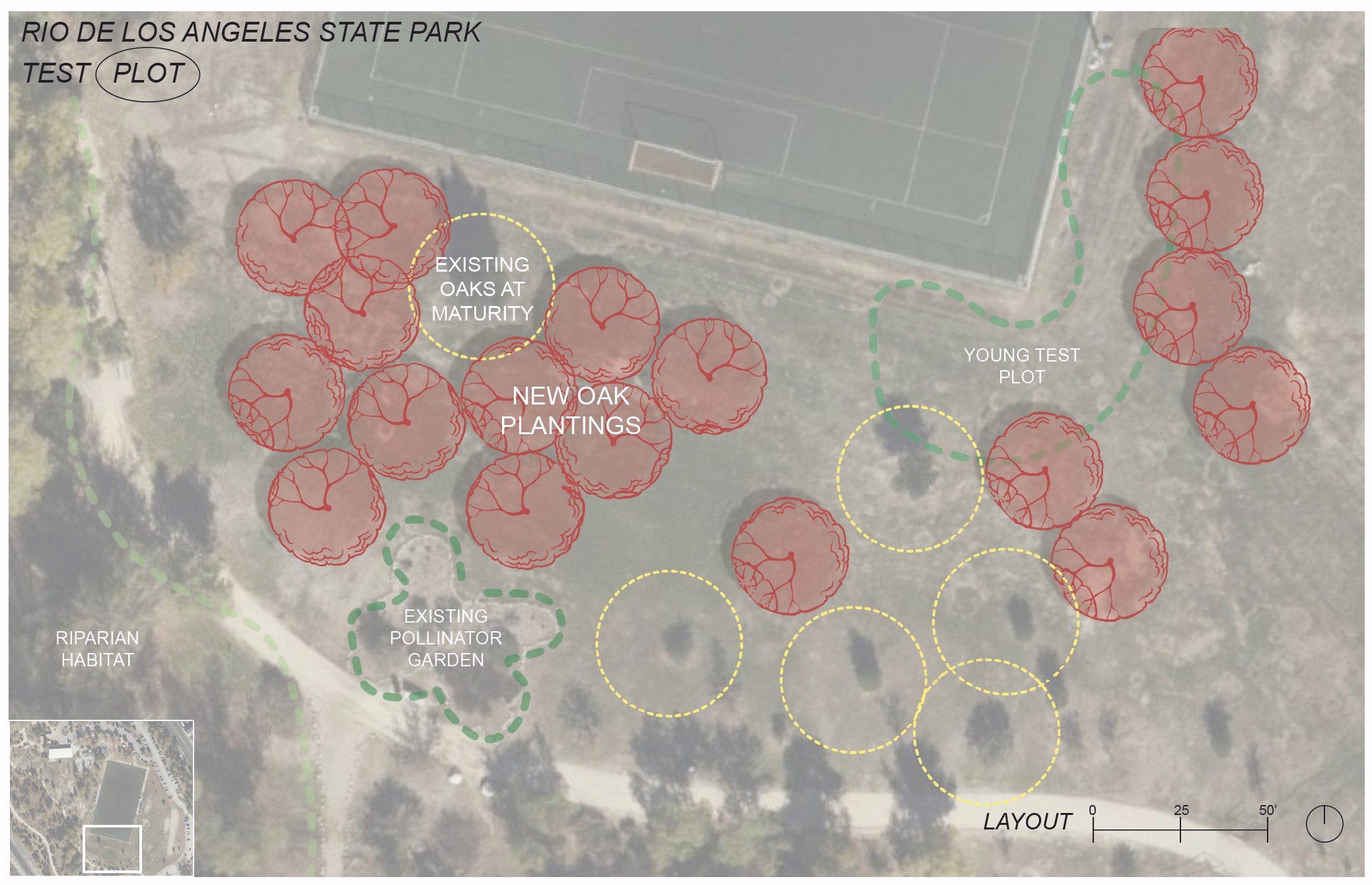
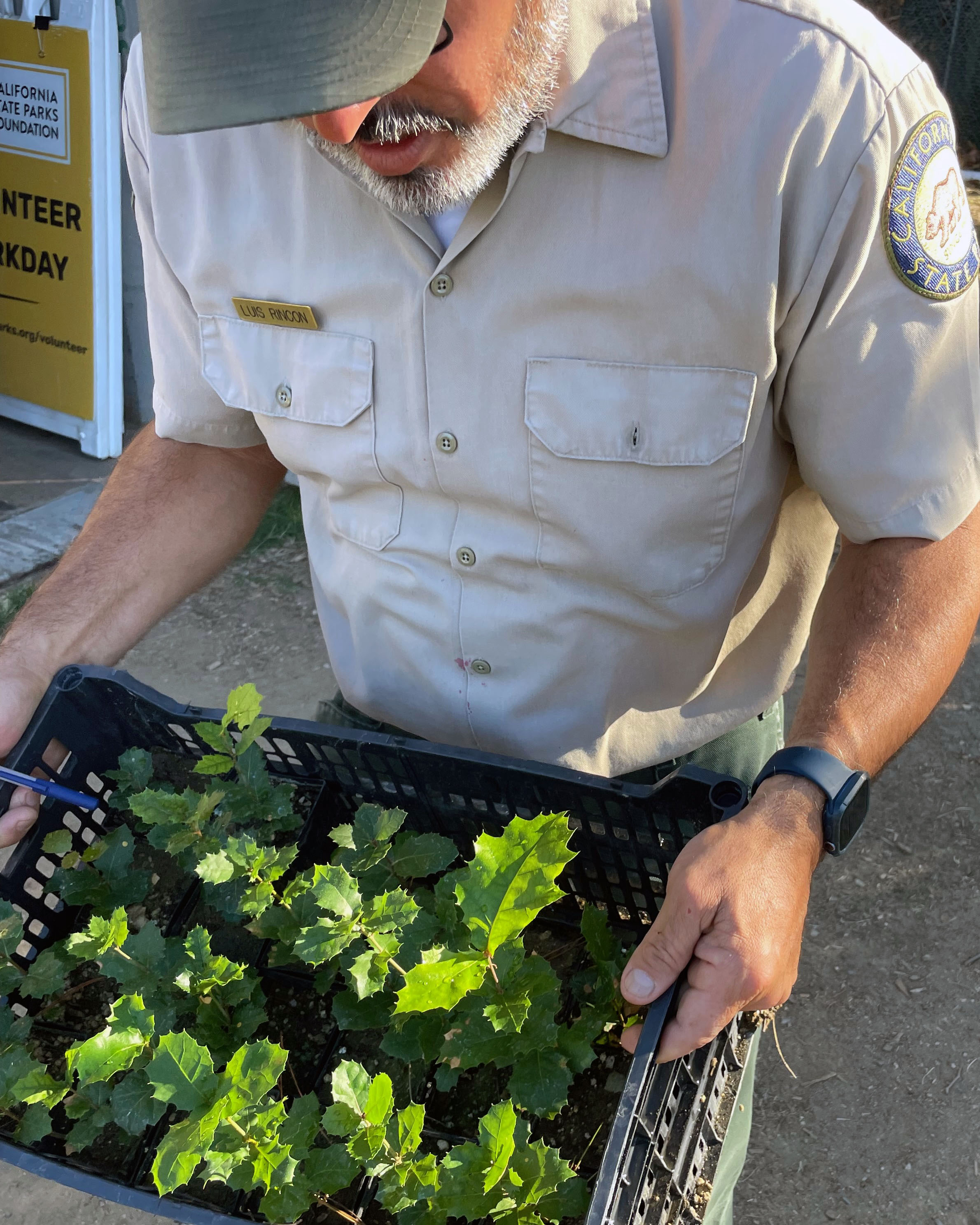
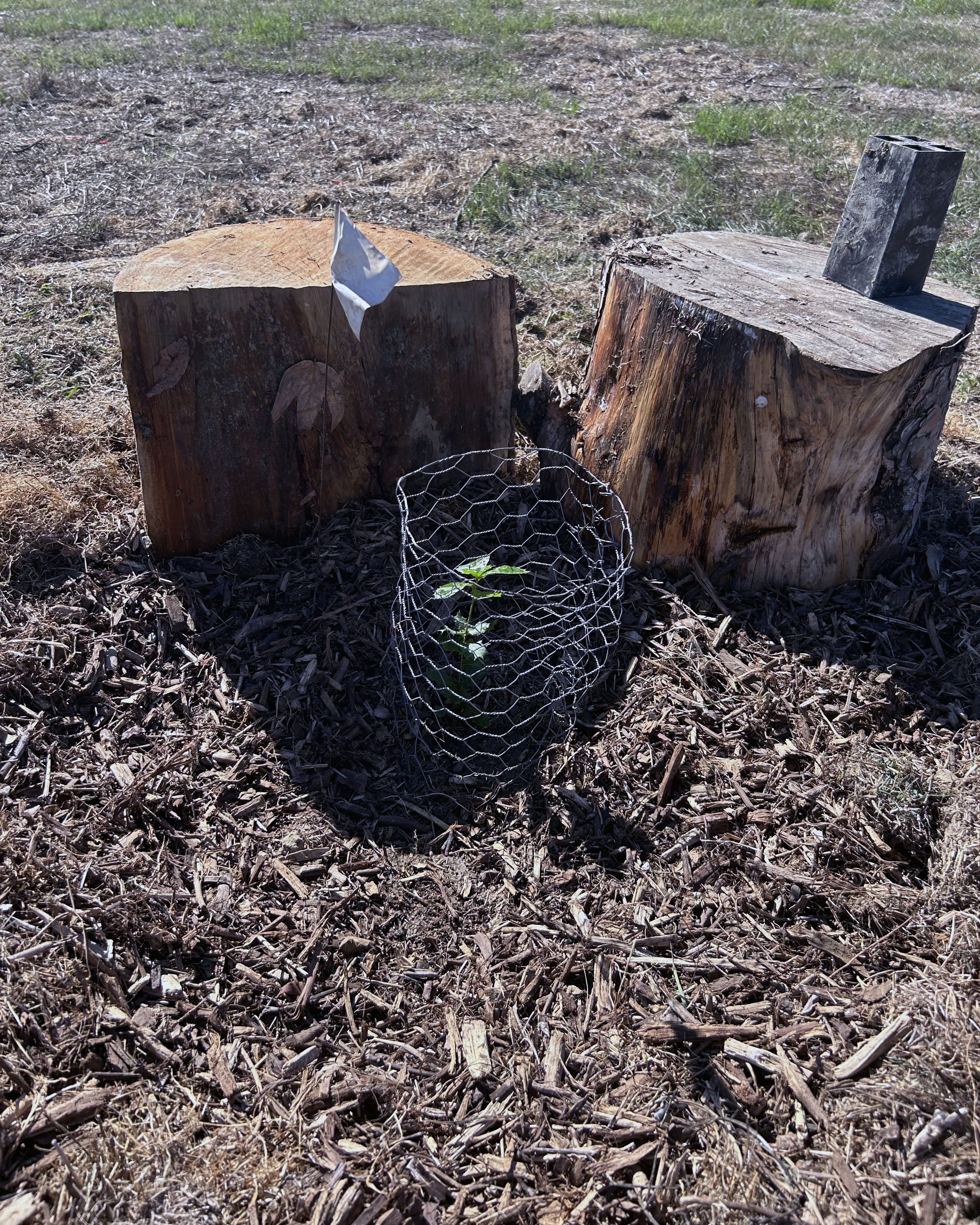
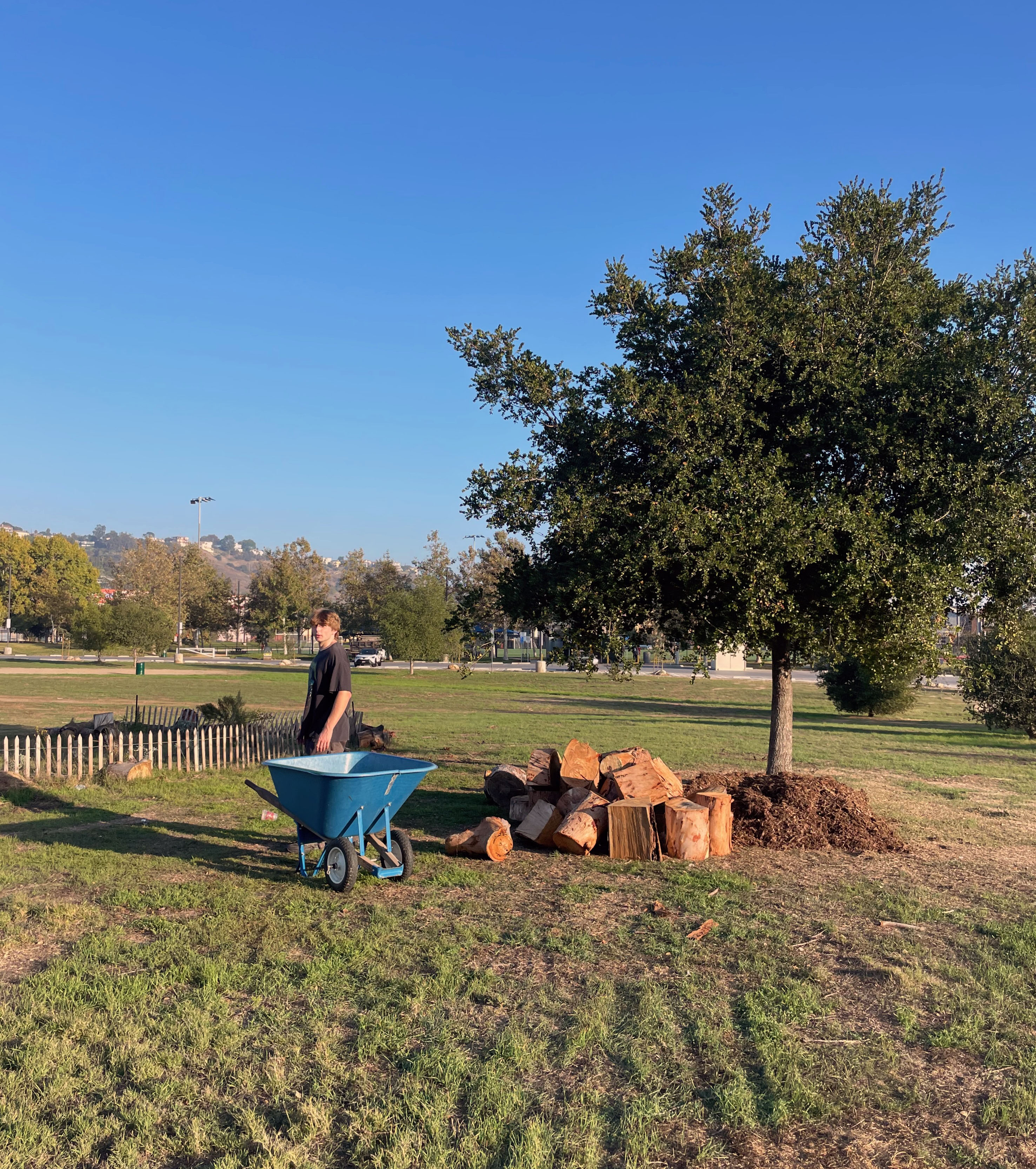


SITE SENSORY EVENT, AN ORAL HISTORY
Rainbow Canyon Test Plot
DATE: October 04 2025
During the process of introducing students to the canyon I led them on a few site sensory exercises. These ranged from basic meditation, that we call “Look and Listen”, to measuring exercises, like soil analysis. These were fun, relaxing, and enlightening, so we decided we should share these with the community. In the end, the students conceived of, and prepared, twelve site sensory exercises. These were enacted on Saturday morning on October 4th, 2025 with a great group of volunteers, including a contingent of high school students brought by Community Nature Connection. In the morning, before everything started, a local young birder from the neighborhood, Surya, led a well attended birdwatching walk. The day was sweet and beautiful. Everyone was a bit surprised how much they enjoyed it. After spending most days working in the canyon, it was a treat to spend time just tuning into the place.
— Alexander Robinson
I did a 2:30 hour bird walk through the canyon while practicing deep listening through birding. One thing I noticed was around the end people were more quiet and we found more birds. This shows how listening and focusing on the environment can help you notice more. I also showed the importance of citizen science by submitting a list of the birds seen to a database.
— Surya Jeevanjee
I helped people discover their cognitive preferences with sun versus shade measuring. I expected people to have a preference towards the heat, but it was largely voted for the shaded area as it gave a more calming sensation. I expected to not be able to form a general analysis of temperature preferences, but I noticed while repeating in other spots, there would be a general shift in how long people would want to stay in a shaded v. sunny spot, which was interesting. People seem to prefer a counter temperature to an environment they were raised in (So-Cal heat).
— Alejandro Vasquez
We practiced embracing imperfection and letting go by making art from dried plants, then intentionally destroying it afterward. I went in expecting most participants to make simple circles or grids with the dried plants they collected. Instead, they gravitated toward sculptural pieces shaped by intuition and background. The architects worked systematically: they started at the center, built a boundary, then stacked, and ended up with something like a primitive hut. The kids were bolder and more instinctive, hauling big logs and leaning them together to “build” what they pictured: a large house or a bridge. High school and college students were playful but liked to test the rules, mostly gathering leaves in different colors and arranging the patterns suggested by the reference images. It was also funny watching kids haul logs taller than they were. Lynden grabbed two huge logs and decided each one, on its own, was his artwork. Watching how personal experience steered each approach, and how many different outcomes emerged, was the best part.
— Anh Bui
The event we have is exactly what I was expecting, it was fun, engaging and it’s nice to see how much attention this site receives from its surrounding community. We met Lynden, an interesting 9th grader from a neighboring high school, he sure have a lot of opinions on things and often be the funniest one in our group.
— Jianjun Xu
The sensory activity was a guided blindfolded walk where participants used hearing, smell, touch, and sight to experience the site. I expected the plan was to have them walk through the site four times, each time focusing on one sense, but after the first group, I found it worked better when they stayed in front of the same object and used each sense on the same project. What interested me most was how different relationships changed the experience. Couples and parents with kids moved smoothly. Friends, on the other hand, kept bumping into things, but they were laughing the whole time and having fun. Everyone said they really enjoyed the activity also for me. At first, it felt strange to only rely on other senses, but once I got used to it, it became really fun. We all felt that everything around us seemed closer and more alive than usual.
— Jianye Wang
The Collaborative Atmosphere Collage slowly came to life as people walked through Rainbow Canyon, pausing to sketch places that felt meaningful to them. Each drawing was added to a line stretched between trees, turning into a quiet collection of impressions shared across the site. When sunlight came through the canyon and touched the papers, it felt like the drawings became part of the landscape. That moment — when everyone stood together, looking at what had been created, with the sketches moving gently in the wind — felt like a small exhibition, briefly held in the land itself.
— Jiya Yuan
I helped people create a contour and flow mapping of the test plot. During my activity, the participants were engaged to a surprising extent. They worked fairly hard to map out the creek's contours, too, which I didn't expect to happen and once I explained things to the participants, they were autonomous. I believe the activity thrives in its simplicity and the immediate tactile and visual feedback it produces. I could see participants holding discussion as they methodically worked sideways through the canyon.
— Josiah Hickman
Stream study was conducted where different participants helped measure depth and width at 3 different points in one area, proceeded by the following group conducting the same activity 10 ft away from the previous spot. Following the measurement participants also gave notes on anything they noticed. One observation that was interesting was the amount of litter that is imbedded into the stream, from bottles to shoe inserts. There was also evidence of asphalt which had some participants questioning if there used to be a road in that segment or if it was runoff from rainfall. Participants had fun and were very invested in the exercise. The exercise felt like it was more efficient and enjoyable when people worked in pairs rather than alone. The best part was seeing how people found out about the event through so many different channels and seeing people from different backgrounds come together for this activity.
— Navid Rodd
My main site sensory activity was tree hugging, while the secondary one was the feedback tree. I was a bit nervous going into the event because I wasn’t sure if people would be highly engaged. There were some kinks in the activity when Richard & I tested it the second time we visited Rainbow Canyon, and then we tested it again and had more edits. I was thankful we were able to work together. We had a high school freshman participate, and his personality and engagement were so fun! I considered Richard and I splitting off to run the exercise with different people separately, but we decided to stay together in groups of three. This enhanced the tree-hugging experience because three people hugged one tree at the same time; as they experienced the comfort (or discomfort) from hugging the tree, there was a greater community aspect in doing it together. I laughed a lot, and it was interesting seeing which tree each person chose at the end that they identified with the most comfort with a circle of red string.
— Sara Eyassu
I instructed people on how to complete 15-minute "look and listen" sessions lying down. Many told me that they felt relaxed and took notice of how quiet the canyon was. One thing that surprised me was how many people said that the contours of the canyon felt good for their back pain. A land stewardess shared that she spends so much time taking care of the land, she never stopped to consider how the land could take care of her.
— Zoelli Ortiz
I ran a soil analysis station at saturday’s workshop, in which i encouraged guests to conduct both pH and qualitative texture tests. most participants were surprised to learn that the soil pH was consistent across the site, despite variation in soil sample colors, textures, or locations!
— Haleluya Wondwosen
I worked with Hal. More people joined the soil activity because it was simple and fun to test the soil. The litter mapping started slowly, but after some time, people joined in. The kids were more interested in storytelling and discovery than in cleanup. They preferred to talk and act things out rather than write. I had to ask them again and again to try. One kid named Unni found an old tyre laying around and started making up stories about it. The children liked talking and telling stories more than writing or picking up trash. The adults, on the other hand, were more comfortable participating in both mapping and writing. They engaged once they understood the purpose of the activity. Overall, the litter mapping exercise worked, but it needs to be simpler and more fun — maybe more talking or drawing instead of writing.
— Sai Ravikumar
Walking through the canyon blindfolded meant I had to completely trust Sarah. She guided my hand up towards things to touch and handed me things to smell. I became aware of the gentle slope of the canyon floor, noting I had to pick up my feet more! I liked how the small groups of people chatting became anchors that helped me orient myself. Despite being blindfolded, it felt carefree, like a return to childhood.
— Jen Toy
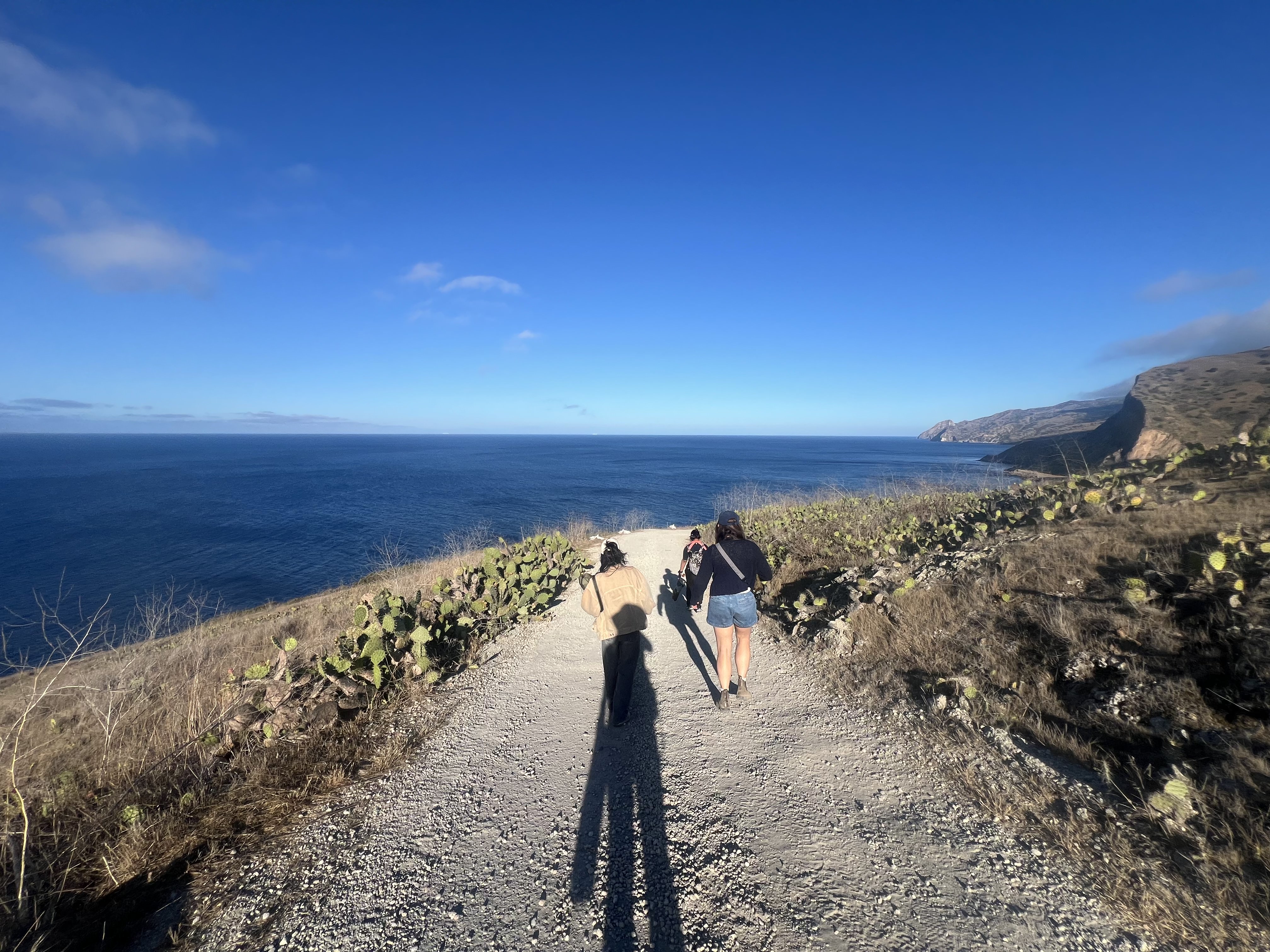
UNDER PRESSURE
Catalina Island Test Plot
By: Alex Robinson
DATE: September 10 2025
Traveling to Catalina Island, or nearly any of the islands off the coast of Southern California, can be an exercise in time travel. For a resident of the mainland bight, it is a multi-threaded journey. Yes, time goes back, rhythms slow, but time also jumps ahead and sideways. The day I visited the Test Plot at the Wrigley Marine Science Center, had a touch of foreshadowing. After our indeterminably long and late hot summer, I enjoyed what everyone agreed, was the first day of Fall, weeks ahead of the mainland.
Talks of cutting back and layoffs were in the air. In the wake of our president’s agenda, research money was drying up and USC was looking to cut research-related staff on the island, many of whom rely on their job to maintain residence on an island mostly owned by either the Catalina Company or Conservancy.
Due to a mild but persistent drought, the plants in this Test Plot have subsisted only by rain and water harvested in rain barrels around the campus. While the channel concentrates moisture, it also bakes, sheltered from coastal breezes by the surrounding dorms. The drought has reduced forage on the island, inducing (introduced) deer and the native squirrels especially to munch the plants. The delicious ones are “topiared” into the shape of their protective steel cages, if they are so lucky to have one.
After this year’s devastating fires, the fire department reassessed all building adjacent plantings. Now nearly all the plants we had planted were “trespassing.” If they had their way they would clear all vegetation within a 100 feet of all structures.


As I conducted my inventory, I could see and feel the pressures on the plot that its steward had skillfully been deflecting. As many islands are, Catalina is small, isolated, and exposed; it is simultaneously a place apart and precariously sensitive to ecological and political turbulence. Yet, thanks to her determined care, the plants are hanging in there and even thriving. The native milkweed has spread out triumphantly, shimmering in the sunlight, and seeding itself. The Catalina Ironwood, my favorite, was both being munched and had flowered, even though its planting pit had required an electric spade to excavate. Mugwort and Tule, two water loving species, were happy behind the check dams, we assembled two years ago. Many small plants, ones you would expect to be the first to go, were hanging on: yarrows, buckwheats, and Yerba Buena. The Catalina Manzanita was making a surprising sprint to its tree form.
All in all, perhaps more than 85% of the plants had survived. Casualties included the ever lovely St Catherine’s Lace buckwheat and the dudleyas, that while alive, had been nibbled to nubs. (All the plants were donated by the Catalina Conservancy over the last two years.)
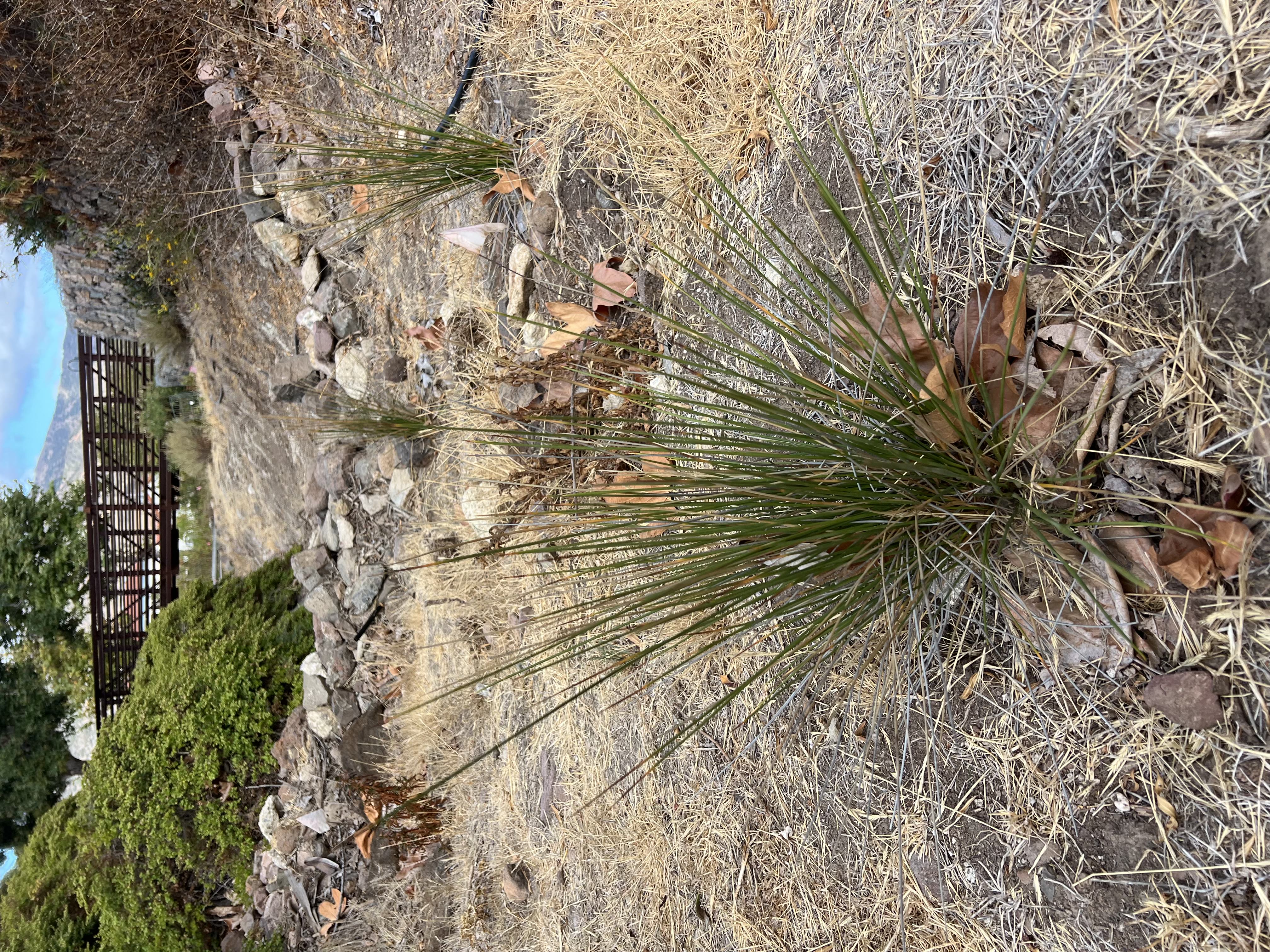
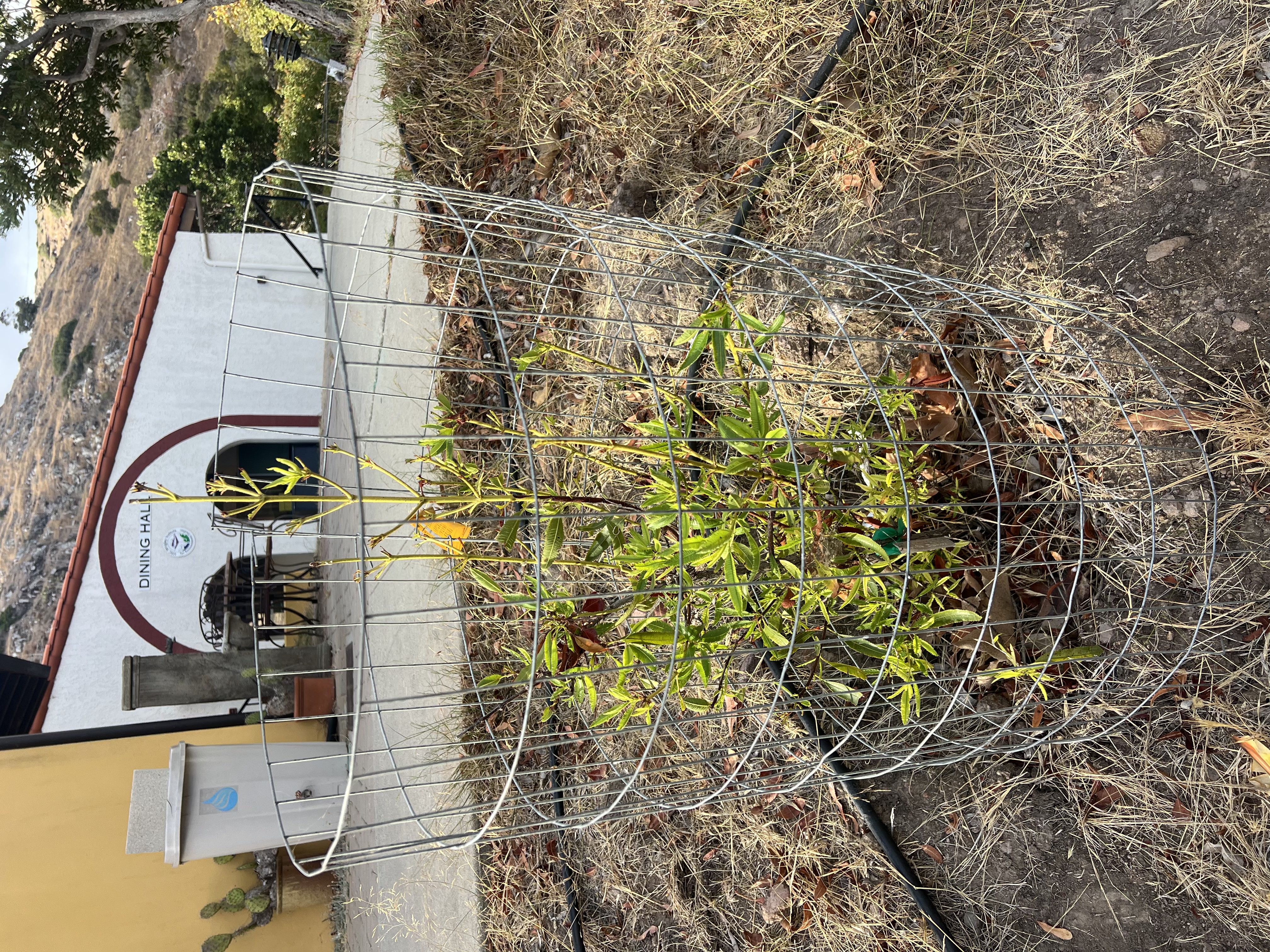
What is the future of this plot and its plants? Of this island and research station? More than most years, it is in flux.
Some of the pressures may subside. There is a plan to remove the deer from the island, that may actually be implemented; it would come with divisions and trauma, but would bring back biodiversity and radically improve all future restoration efforts.
Meanwhile, I wonder whether our island steward will survive the cuts. I worry for her and I worry for this plot. The whole situation speaks to how much persists by the constant care of steward(s). They are needed to manage the pressures, but here we can see limits, however complex. The fate of the plants and the people are precariously entangled, and particularly on this outpost. In ways they tell us how to care: when to care for each and when we must tackle the pressures themselves.
I finished my plant inventory and went down to jump in the water. Later I headed back to the mainland on the Miss Christi USC boat. A few weeks later I heard our local steward would be laid off.
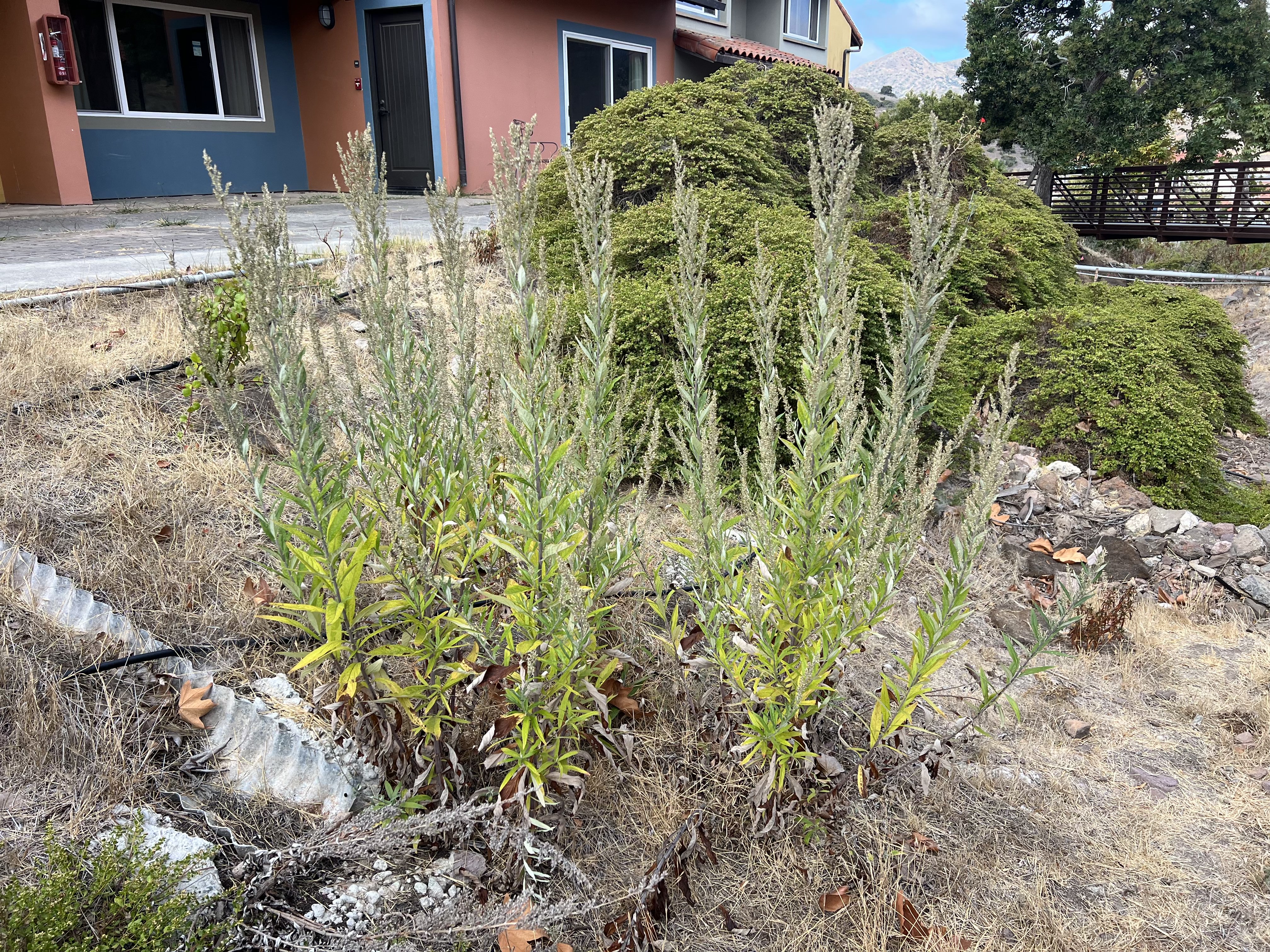
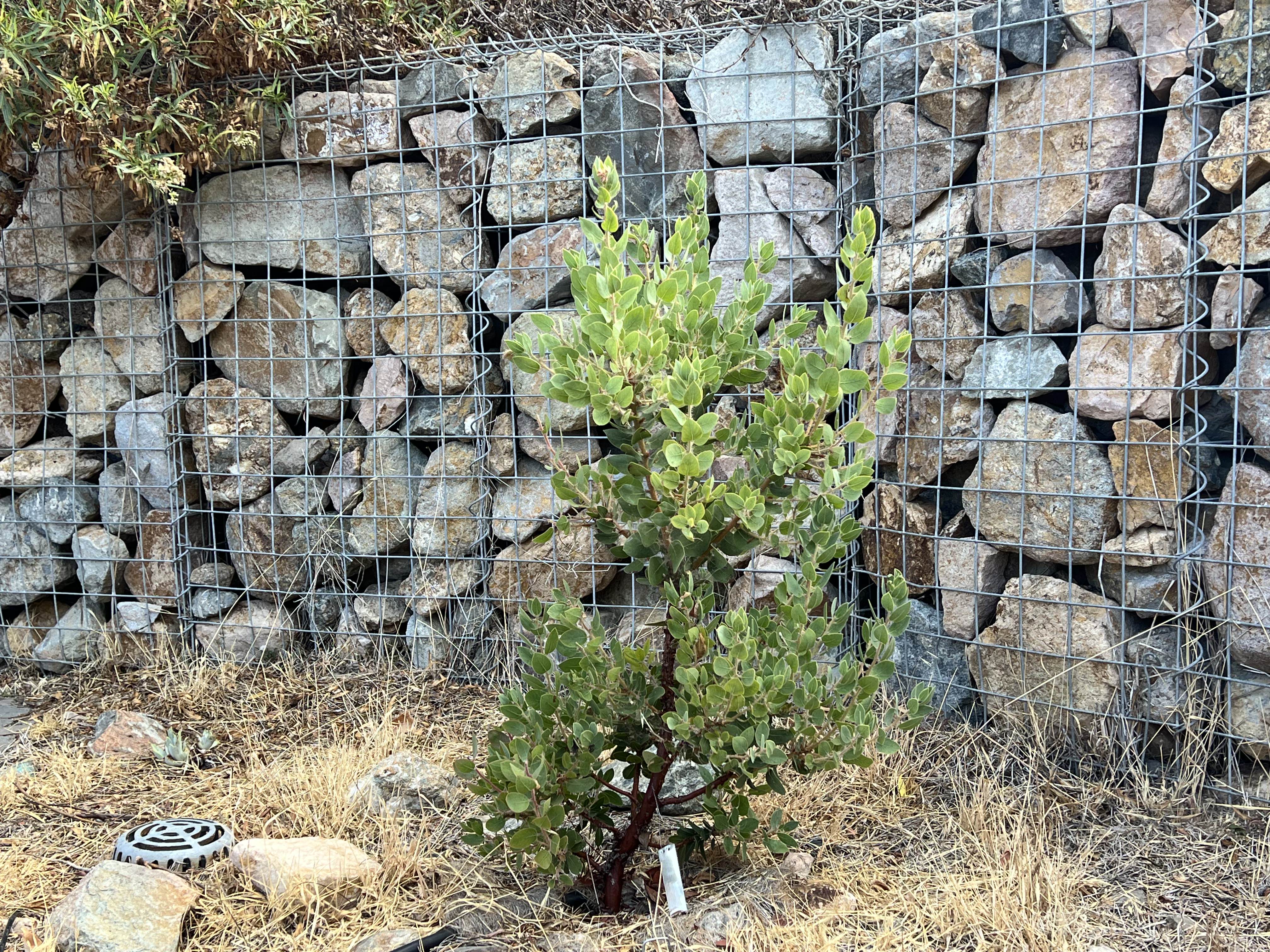
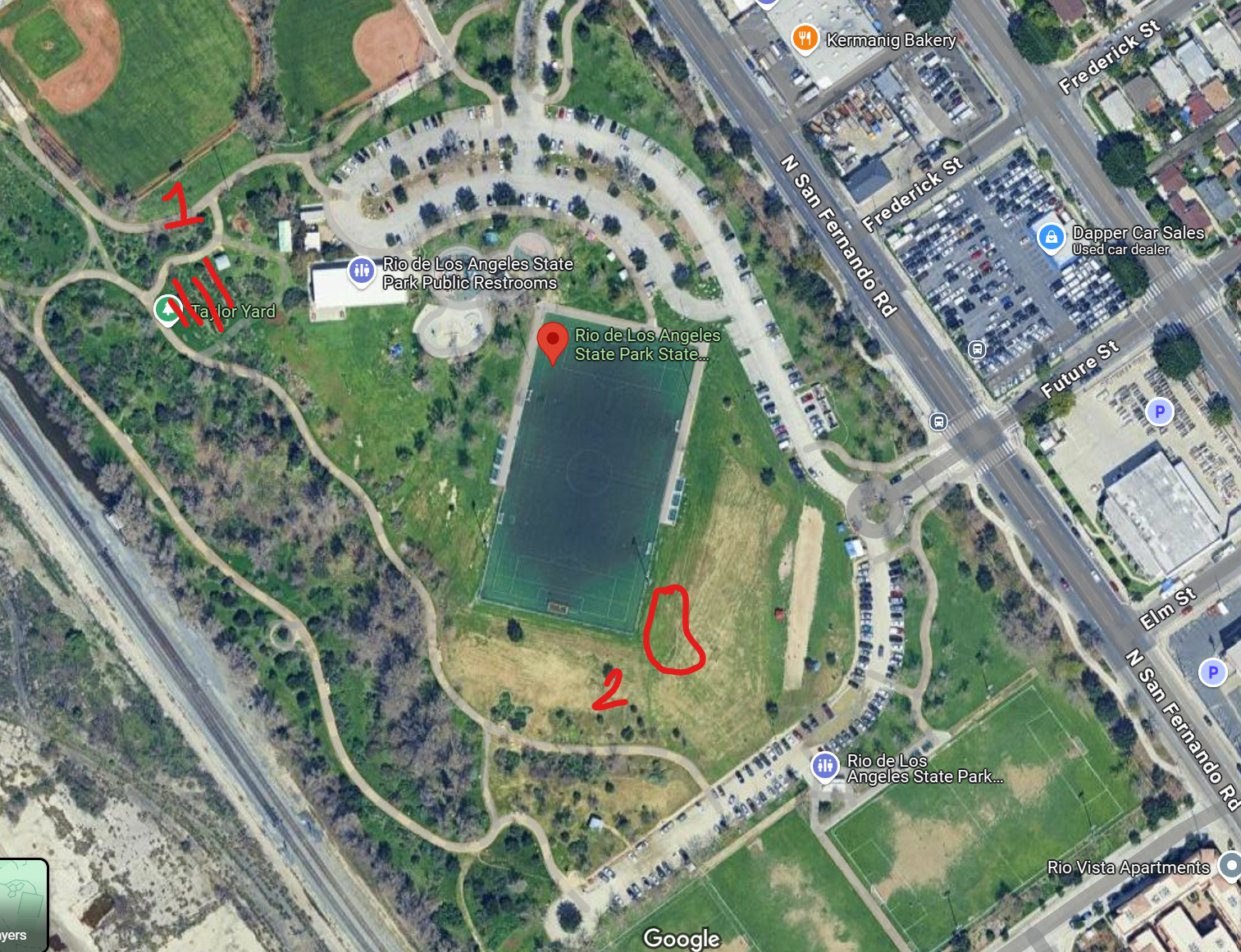
HEAVY HITTERS
Rio de Los Angeles Test Plot
By Tom Hurst
DATE: July 27 2025
Overview
On an overcast Sunday, I started an informal itinerary of successful species at the Rio de Los Angeles Test Plots. This living document is dubbed Heavy Hitters. We will maintain this evolving record of change at the site, focusing first on individuals before considering future categorization. I hope this document helps inform the ongoing restoration efforts at Rio de Los Angeles State Park. It is also fun to record the wellbeing of plants we care about.
Observations
Test Plot 1: The dense shrubs at Rio de Los Angeles thrive in the early summer sun. Hardy plants produce expectant buds, including Baccharis pilularis (Coyote Bush) and Isocoma menziesii (Coastal Goldenbush). Rabbits shuffle between them. The proud structure of Malosma laurina (Laurel Sumac) and Heteromeles arbutifola (Toyon) sets them apart from the crowd. Their branches shelter smaller species. The Plot is densely planted and there is a sense of communion. Change is also visible through death; many of the staggered plantings of Encelia californica (California Brittlebrush) failed while Monardella villosa (Coyote Mint) is dry and defeated.
Test Plot 2: At the younger Plot, Ceanothus thrysiflorus and Elymus condensatus (Giant Wildrye) break free of their gopher cages, their wire pants. Spent Salvia apiana (White Sage) stalks are relics of a warm Spring. In the throes of immaturity, Epilobium canum (California Fuschia) competes with Solidago californica (California Goldenrod). Their exchanges spill over the picket fence to a pile of harvested weeds. These weeds were cut low after the rain before they went to seed; their roots remain in place to minimize soil disturbance. This pile, we hope, provides habitat for insects. The ground feels cooler here than in Test Plot 1.
Landcare
- Water immature plants strategically through the summer without watering mature species unnecessarily.
- Cut back lone weeds (though few remain after successful volunteer outings).
- Evaluate the relative success of species to inform planting decisions for the fall.
- Prune struggling species in late summer to encourage regrowth.
- Keep mulch to an absolute minimum.
Brief Bio
Tom studies Landscape Architecture and works as a gardener. As a design student, he believes in the role of ecological regeneration to help rehabilitate public and private spaces. He is interested in design that makes the process of change visible, and the landscape legible. His voluntary work at Test Plot: Rio de Los Angeles is a manifestation of use, time, and connection. His favorite plant this month is Baccharis pilularis.

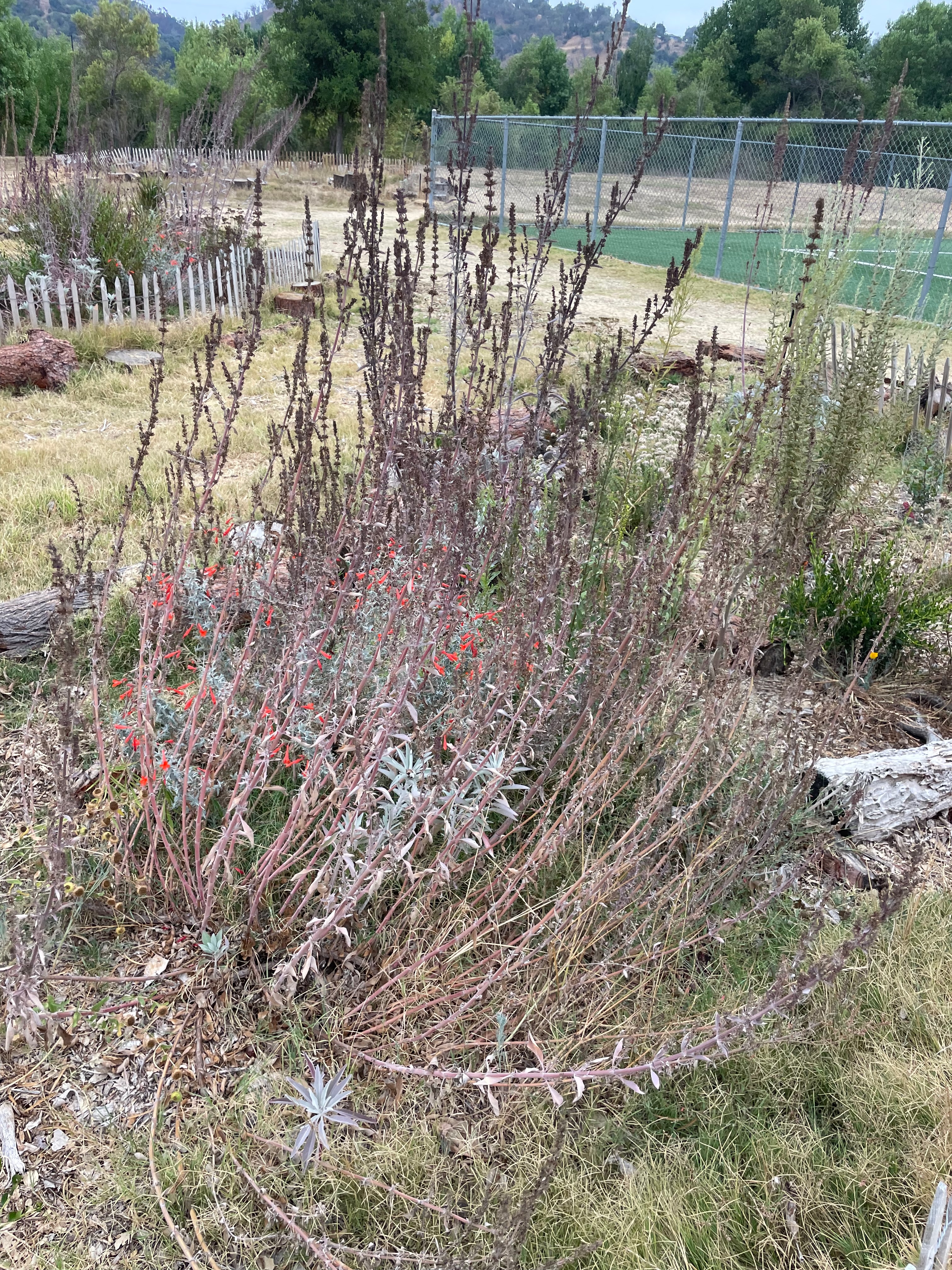
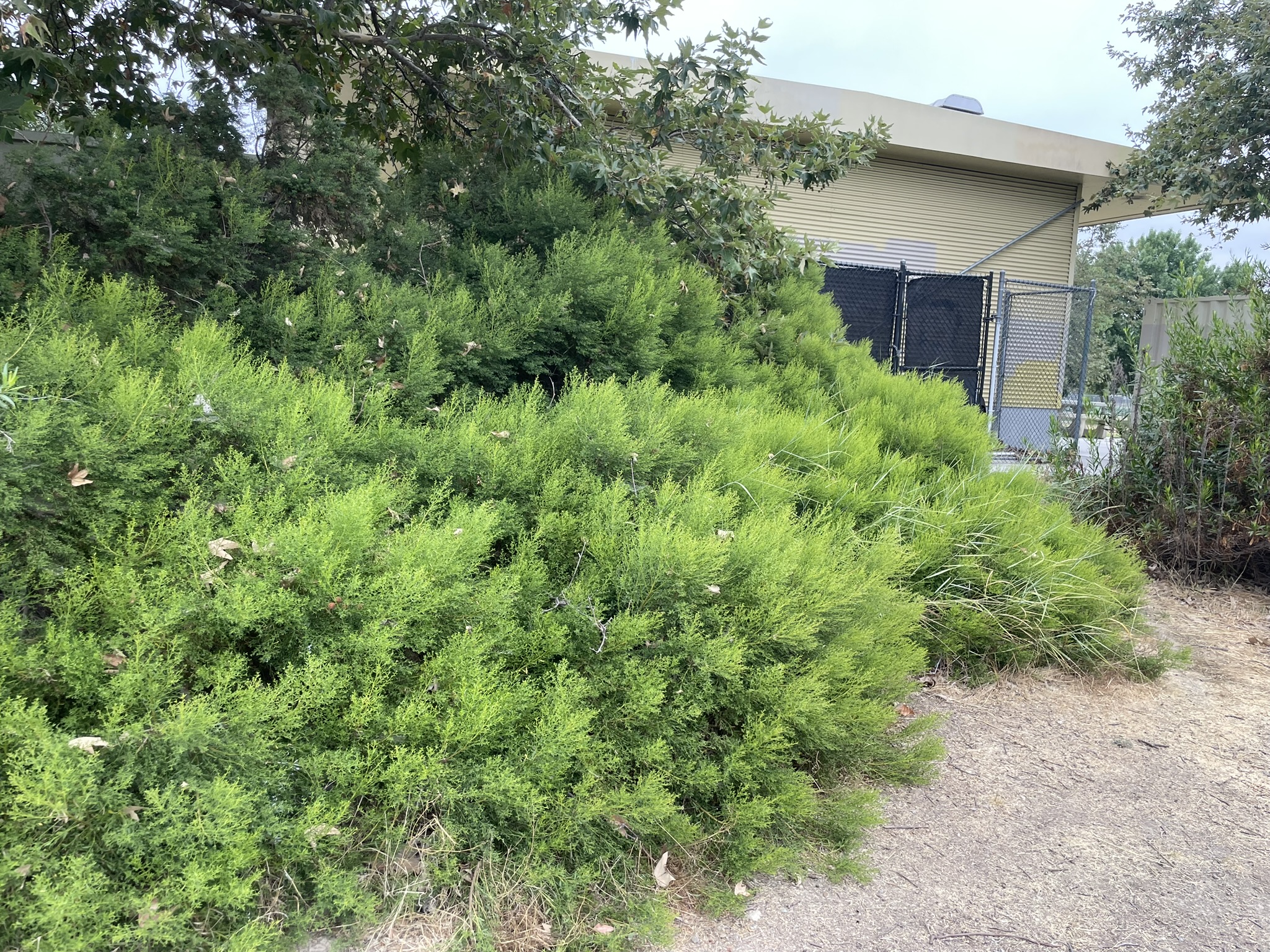

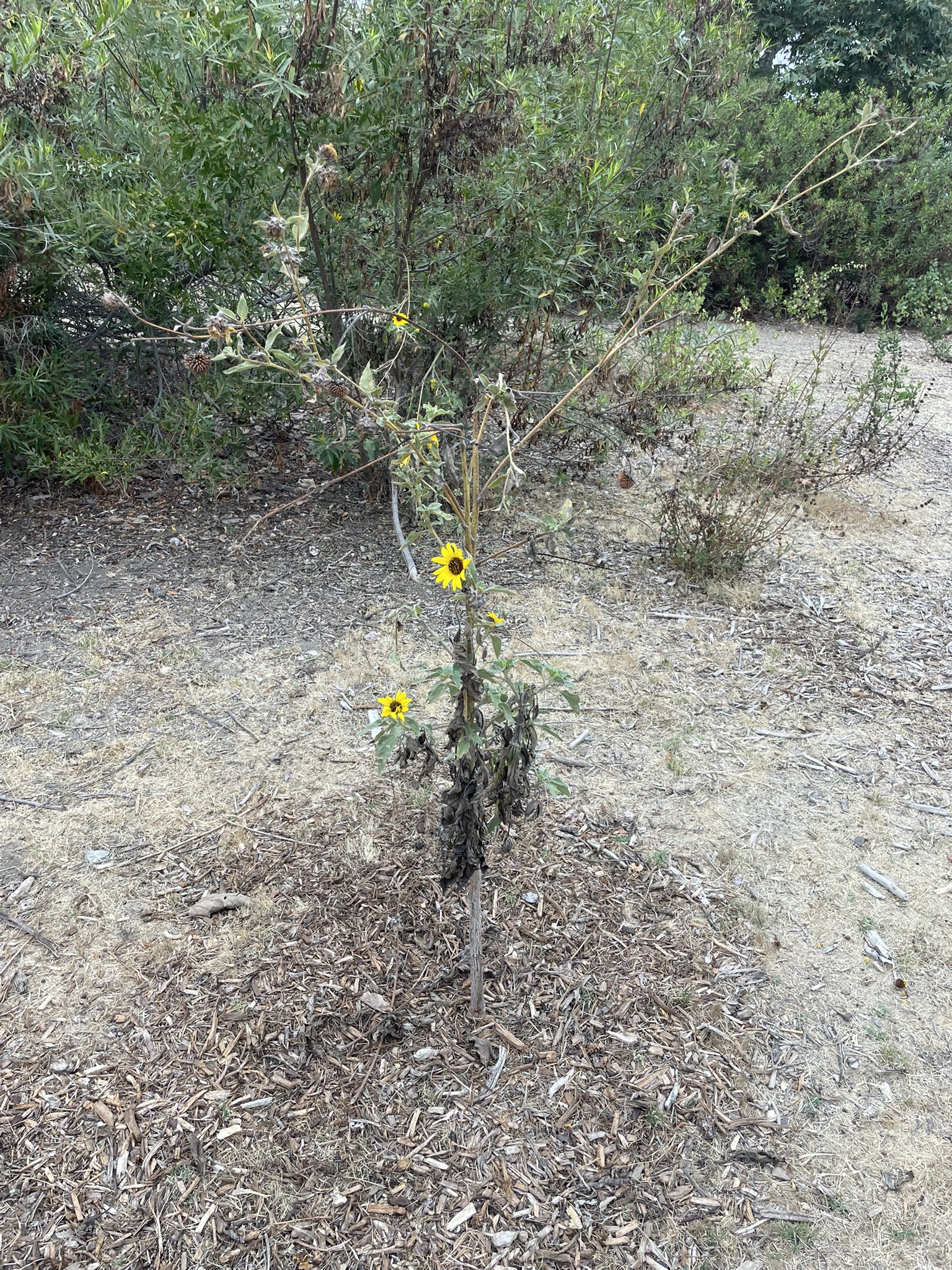
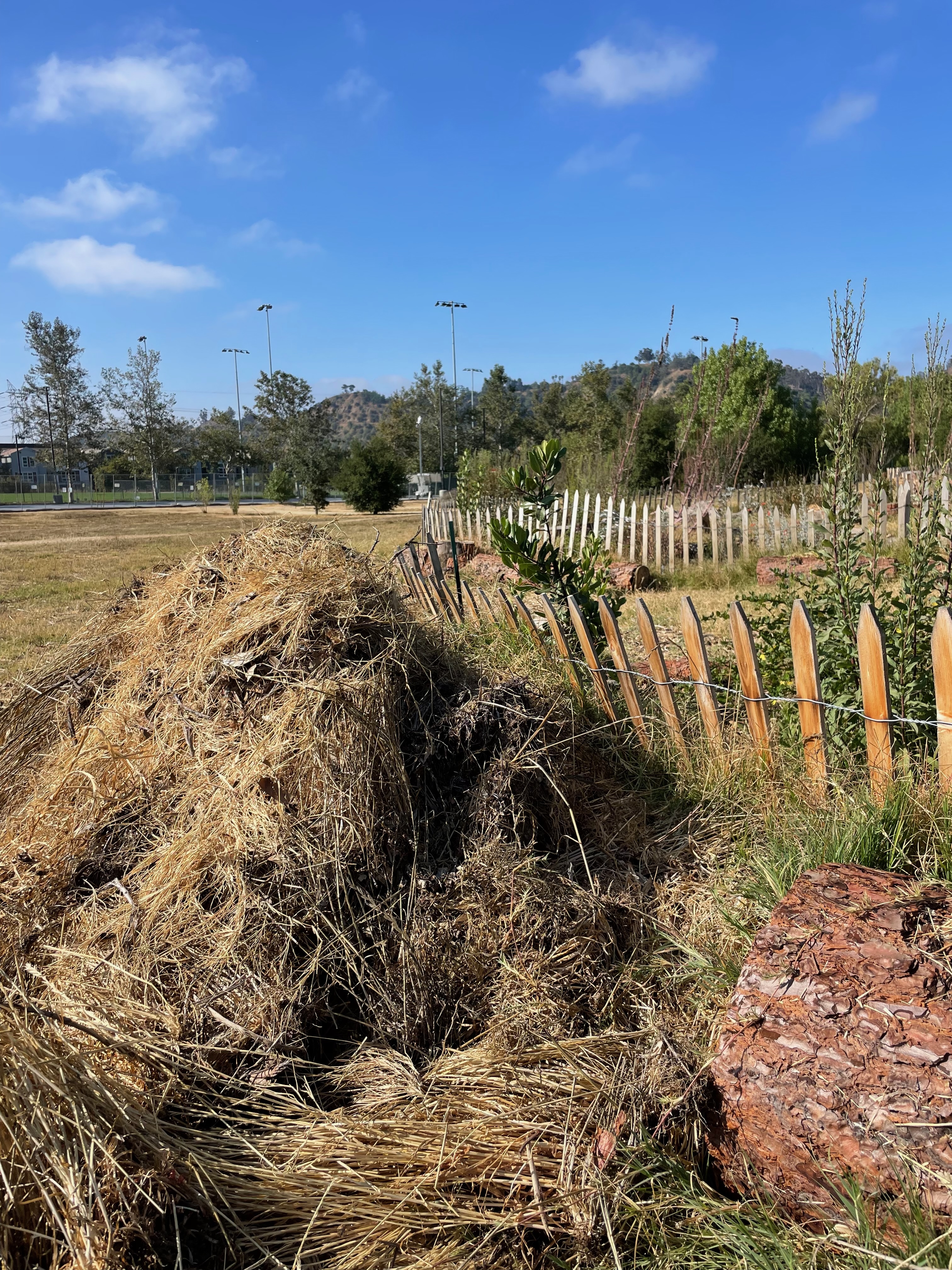
STARR KING TEST PLOT PHASE 2 BEGINS
Starr King Test Plot, San Francisco
By Elena Fox
Terremoto
DATE: Nov 21 2024
Starr King Test Plot, San Francisco
By Elena Fox
Terremoto
DATE: Nov 21 2024
After a brief break from our first year of observation at Starr King Test Plot, we are back on site to begin Phase 2 as the wet season comes upon us. We have developed a restoration plan that will move us from observation to operation with limited resources. Our high level plan is to start a regular weeding + maintenance schedule internally as a company before engaging the community in volunteering.
Our maintenance approach is based on the Bradley Method, where we will chose two work zones (the plots) based on where native plants are currently observed. We will concentrate our efforts in these two zones and organize our work in concentric bands of intensity. In the center of each zone, we will continue with hand weeding around natives. In an outer band we will do a non-targeted a cutback of all plant material a few times over the course of the wet season. The logic is that through cutbacks we prevent annuals from going to seed- after 3 years the seed bank of annual weeds is exhausted.
During Phase 1 (Observation), we collected native seeds to contract grow. These plugs will be planted now and into this winter, with the goal to only plant what originally came from the site.
The goals and methods of Phase 2 are as such:
1. We only (re)introduce/use materials and plants from the site, or from the adjacent open space on serpentine outcrops.
2. We test variable weeding strategies using the Bradley Method:
3. We pay attention to time and use it as a tool - by continuing to observe + weed regularly, we can start to understand how much time is required of us, and how the site is evolving based on our new inputs and labor. We focus on maintaining our slow and measured approach
4. We involve the greater community in volunteer days + observation sessions (once we get grounded in the space ourselves)
Our maintenance approach is based on the Bradley Method, where we will chose two work zones (the plots) based on where native plants are currently observed. We will concentrate our efforts in these two zones and organize our work in concentric bands of intensity. In the center of each zone, we will continue with hand weeding around natives. In an outer band we will do a non-targeted a cutback of all plant material a few times over the course of the wet season. The logic is that through cutbacks we prevent annuals from going to seed- after 3 years the seed bank of annual weeds is exhausted.
During Phase 1 (Observation), we collected native seeds to contract grow. These plugs will be planted now and into this winter, with the goal to only plant what originally came from the site.
The goals and methods of Phase 2 are as such:
1. We only (re)introduce/use materials and plants from the site, or from the adjacent open space on serpentine outcrops.
2. We test variable weeding strategies using the Bradley Method:
3. We pay attention to time and use it as a tool - by continuing to observe + weed regularly, we can start to understand how much time is required of us, and how the site is evolving based on our new inputs and labor. We focus on maintaining our slow and measured approach
4. We involve the greater community in volunteer days + observation sessions (once we get grounded in the space ourselves)

RAINBOW CANYON KICK-OFF
Rainbow Canyon Test Plot (Mt. Washington neighborhood)
By Tatianna Velicer
USC Student
DATE: Oct 24 2024
Rainbow Canyon Test Plot (Mt. Washington neighborhood)
By Tatianna Velicer
USC Student
DATE: Oct 24 2024
Rainbow Canyon has a homey community feel with beautiful sheltering trees, a riparian area, a scenic viewpoint of the city, and switchback trails. It is a peaceful oasis surrounded by the sounds of lawn work, neighbors out and about, barking dogs, birds chirping, and coyote howls. There is a characteristic rotting pumpkin, a chair with a tire perched on top of it, and lots of forgotten tidbits of plastic and metal.
On our site preparation day on October 26th, we divided and conquered tasks to prepare the area for planting. Volunteers conducted weeding, invasive species removal, trash removal, site maintenance, and debated design options for the new Test Plot. The switchback area was altered to have a longer entrance, a less steep gradient, and logs were added for trail identification. Castor bean and tree-of-heaven were removed. The trash cleanup group found all sorts of treasurers from lego figurines to seemingly ancient cans and bottles. A majority of the cleanup work focused on picking out tiny bits of plastic, glass, and styrofoam scattered in the soils.
We asked each volunteer to place a flag at their favorite place in the Canyon. I retrieved these flags from every corner of the Canyon but many were placed along the riparian area and central gathering spaces. We received feedback with exciting ideas for transforming the space, such as the addition of benches, a bridge, an art installation, a space for classes and events, and educational signage. Volunteers gathered to review potential designs and then had the opportunity to show us with rope where they would add a plot to the space. We received sketches with a Yin and Yang plot formation and a few designs with large central ovular plots.
The most heartwarming aspect of the day was the Mount Washington Community members and all the volunteers who showed up with a smile to help us with these preparation activities. With our volunteers, we were able to not only envision the future of Rainbow Canyon, but hear stories from its past. Rainbow Canyon has a rich history of community advocacy that led to its preservation. It has proven to be a space worth protecting and loving. We even learned that Rainbow Canyon was the venue of a wedding for a local resident. We hope to honor the combined natural and human history of the Canyon with our Test Plot, coming on December 8th, 2024.
On our site preparation day on October 26th, we divided and conquered tasks to prepare the area for planting. Volunteers conducted weeding, invasive species removal, trash removal, site maintenance, and debated design options for the new Test Plot. The switchback area was altered to have a longer entrance, a less steep gradient, and logs were added for trail identification. Castor bean and tree-of-heaven were removed. The trash cleanup group found all sorts of treasurers from lego figurines to seemingly ancient cans and bottles. A majority of the cleanup work focused on picking out tiny bits of plastic, glass, and styrofoam scattered in the soils.
We asked each volunteer to place a flag at their favorite place in the Canyon. I retrieved these flags from every corner of the Canyon but many were placed along the riparian area and central gathering spaces. We received feedback with exciting ideas for transforming the space, such as the addition of benches, a bridge, an art installation, a space for classes and events, and educational signage. Volunteers gathered to review potential designs and then had the opportunity to show us with rope where they would add a plot to the space. We received sketches with a Yin and Yang plot formation and a few designs with large central ovular plots.
The most heartwarming aspect of the day was the Mount Washington Community members and all the volunteers who showed up with a smile to help us with these preparation activities. With our volunteers, we were able to not only envision the future of Rainbow Canyon, but hear stories from its past. Rainbow Canyon has a rich history of community advocacy that led to its preservation. It has proven to be a space worth protecting and loving. We even learned that Rainbow Canyon was the venue of a wedding for a local resident. We hope to honor the combined natural and human history of the Canyon with our Test Plot, coming on December 8th, 2024.

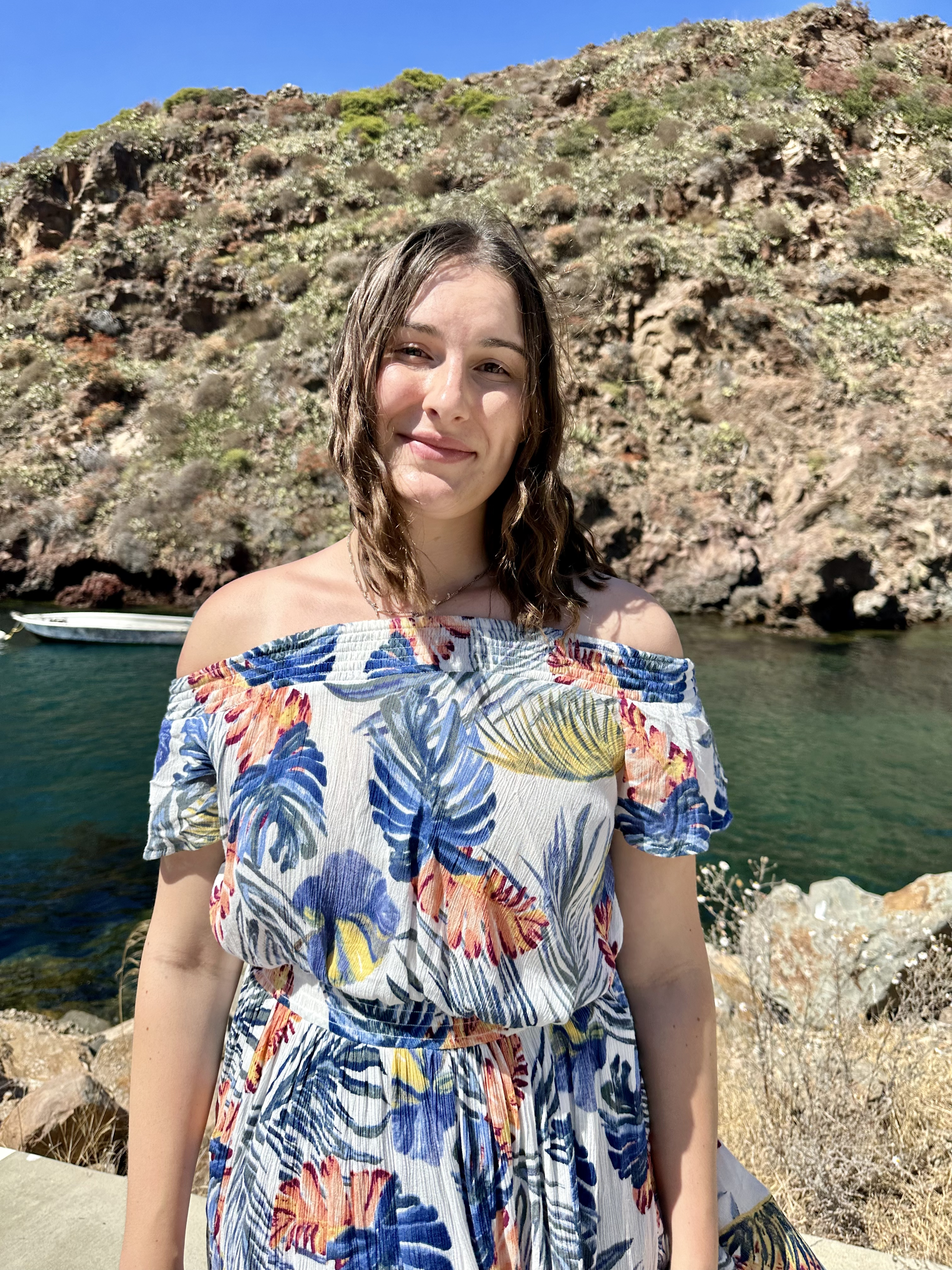

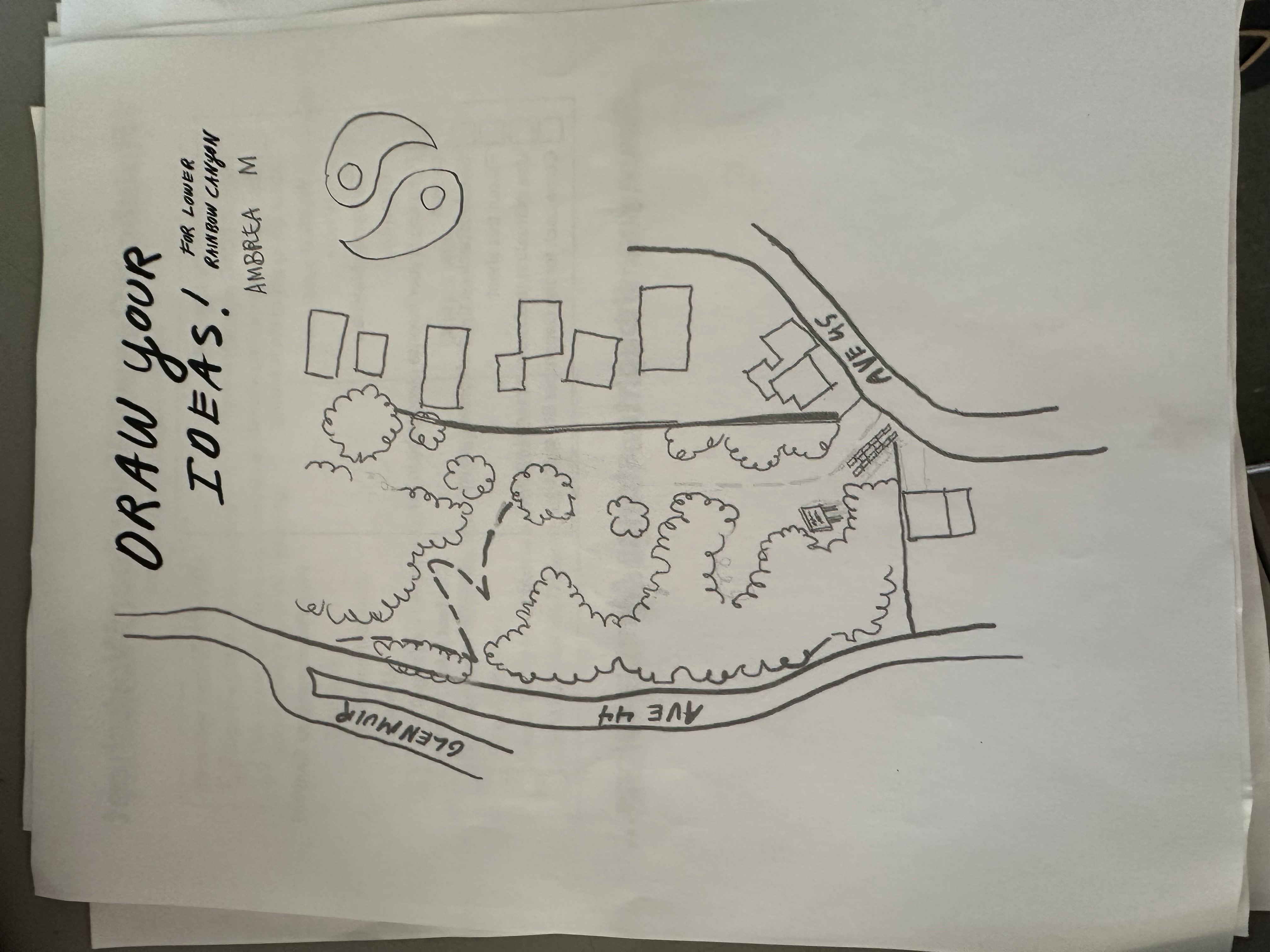
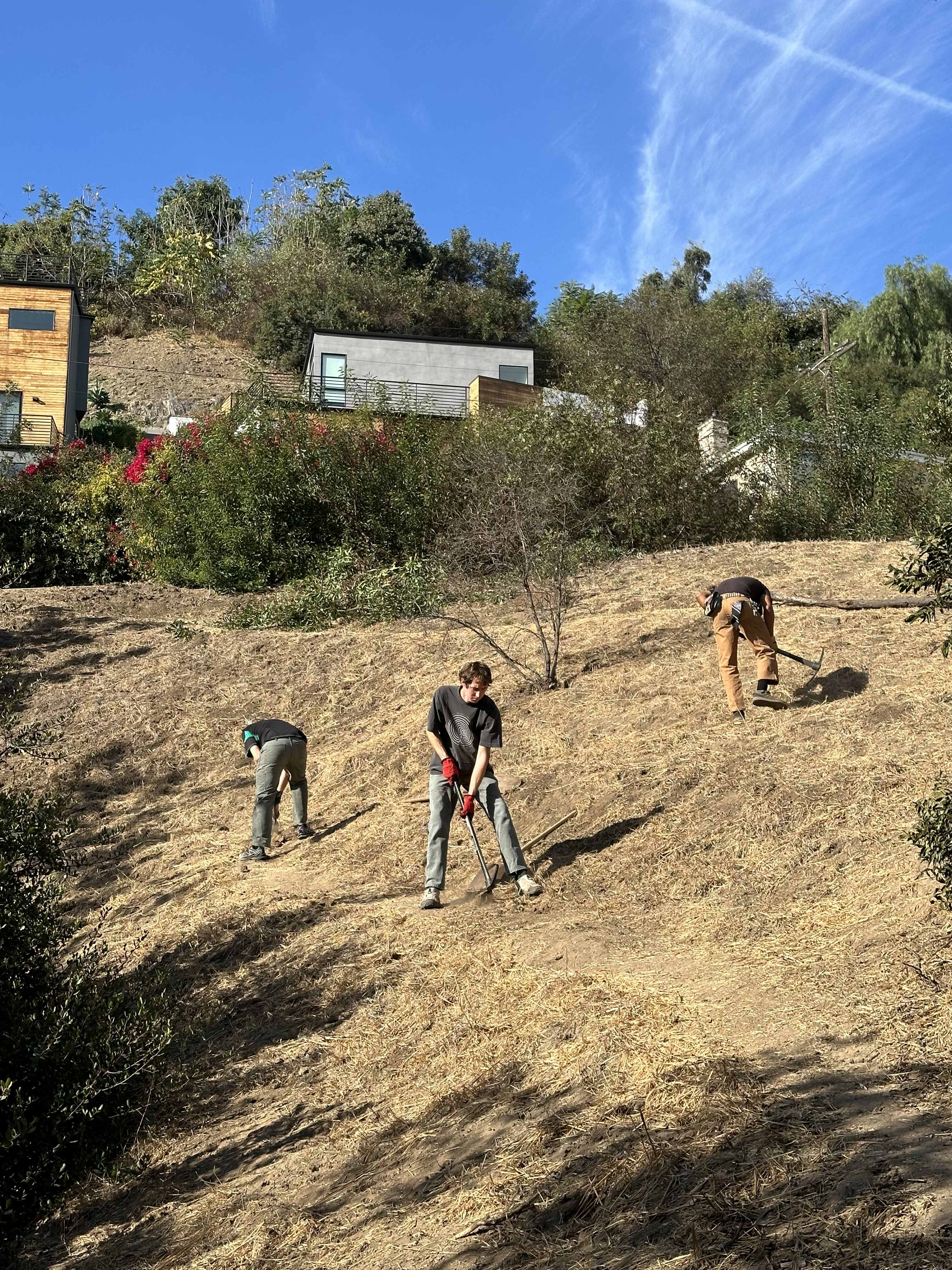
GREEN RAVINE @ CATALINA TURNS 1!
Catalina Island Test Plot
By Alex Robinson
USC Department of Landscape Architecture & Urbanism
DATE: Oct 22 2024
SOIL MOISTURE: Dry
︎ PLANT SIGHTINGS:
Out of the 174 plants planted one year ago (Nov 2023), about 30 have perished according to Lauren Czarnecki, the Test Plot lead steward of Catalina. Reasons include lack of water (see notes on irrigation system below), browsing by ground squirrels (esp loved wooly sunflower and don’t like golden yarrow) and transplant shock. Endemic species include Wallace’s nightshade, Catalina ironwood (not Santa Cruz which is more popular on the mainland), Mountain mahogany, Island Ceanothus, and the Catalina Island Manzanita. They are all surviving!
WEED SIGHTINGS:
We were lucky to be joined by a team from the Catalina Conservancy Invasive Plant Management team joined our group. Aaron Kreisberg, Plant Conservation Manager, walked the ravine and identified the major weeds, which were all located on the western edge of the plot.
They included:
He also suggested this amazing resource WEEDRIC (Research & Information Center) by UC Davis which lists invasive species A-Z and offers management strategies. He says he uses it every day!
︎WILDLIFE SIGHTINGS: None in the immediate plot area except a wicked spider web.
HUMAN ACTIVITY: Our team consisted of USC students from Alex’s class, Tawny de Guzman from Community Nature Connection plus 2 colleagues, Julio Soria from LA Nature for All, and Scott Applebaum from the ENST program. We weeded the ravine, planted 30 new plants, and gave the existing and new plants a deep water.
“ My favorite part of the day was when we got to dig holes for some replacement plants in the ravine. Some areas were very easy to dig down into whereas others were quite rocky and dry, so it was great to see our group really begin to cooperate more and work together on the harder spots. I also enjoyed locating a Dudleya that was hiding underneath some Encelia californica, and pruned back the shrub to provide more sunlight. “ - Mark Reid, USC Student
GENERAL NOTES: It was a beautiful day, with multiple dolphin and gray whale sightings on the boat ride there and back. Lauren has been an amazing steward over the last year, but watering is challenging and time consuming. She has been underwatering the plants (twice in the fall and spring and 3-4 times over the summer). The IBC tote (250 gallons of collected rainwater) was placed upstream and gravity feeds into 4 drip irrigation lines, with 1 emitter covering each plant (at least most plants). However it turns out the head pressure is only great enough to run one line (the top one) so the plants towards the bottom of the swale did not receive as much water. It takes several hours to drain one tote, and requires machinery to replace the totes. It is also tricky to find time to water during the cooler times of day. She learned a trick to spray the water to create more humidity, which helps against the dry Santa Annas.
SOIL: Scott Applebaum’s class spent time over the summer, and conducted more soil tests to compare with those taken in September 2023 (see LOG POST HERE). They found that the soil cores are shifting away from clay to include more silt.
COIR MATS: This is the first time we tried coir mats, and they are all still holding their form and intact. Lauren’s thoughts are that they have helped with water retention in the dry months. She noticed that if they were not staked down very well, they would rip and pull the plants away during winter when the ravine had active water flow.
TIMELAPSE: The Chronolog has been up and running since July. It’s a community science app that takes photos that people can upload and creates a timelapse video.
SUMMARY: Lauren reminded us the goal is 3 S’s : slow the water, spread it, and sink it. The rock check dams are working, and she observed standing water in July, which allows for species like the Baja Choir Frog to visit through June.
Catalina Island Test Plot
By Alex Robinson
USC Department of Landscape Architecture & Urbanism
DATE: Oct 22 2024
TIME: 10AM-2PM
TEMP: 73 F
︎
WEATHER: Sunny, Blue Skies, Warm
WIND (SPEED/DIRECTION): Not noticeableSOIL MOISTURE: Dry
︎ PLANT SIGHTINGS:
Out of the 174 plants planted one year ago (Nov 2023), about 30 have perished according to Lauren Czarnecki, the Test Plot lead steward of Catalina. Reasons include lack of water (see notes on irrigation system below), browsing by ground squirrels (esp loved wooly sunflower and don’t like golden yarrow) and transplant shock. Endemic species include Wallace’s nightshade, Catalina ironwood (not Santa Cruz which is more popular on the mainland), Mountain mahogany, Island Ceanothus, and the Catalina Island Manzanita. They are all surviving!
WEED SIGHTINGS:
We were lucky to be joined by a team from the Catalina Conservancy Invasive Plant Management team joined our group. Aaron Kreisberg, Plant Conservation Manager, walked the ravine and identified the major weeds, which were all located on the western edge of the plot.
They included:
| Atriplex semibaccata | Australian saltbush |
| Brachypodium sylvaticum | False brome |
| Brassica nigra | Black mustard |
| Bromus diandrus | Ripgut brome |
| Bromus hordeaceus | Soft brome |
| Centaurea melitensis | Maltese star thistle |
| Cynodon dactylon | Bermuda grass |
| Erigeron canadensis | Horseweed |
| Foeniculum vulgare | Fennel |
| Rumex crispus | Curly Dock |
| Salsola australis | Russian thistle |
| Salsola tragus | Russian tumbleweed |
| Stipa miliacea | Smilograss |
He also suggested this amazing resource WEEDRIC (Research & Information Center) by UC Davis which lists invasive species A-Z and offers management strategies. He says he uses it every day!
︎WILDLIFE SIGHTINGS: None in the immediate plot area except a wicked spider web.
HUMAN ACTIVITY: Our team consisted of USC students from Alex’s class, Tawny de Guzman from Community Nature Connection plus 2 colleagues, Julio Soria from LA Nature for All, and Scott Applebaum from the ENST program. We weeded the ravine, planted 30 new plants, and gave the existing and new plants a deep water.
“ My favorite part of the day was when we got to dig holes for some replacement plants in the ravine. Some areas were very easy to dig down into whereas others were quite rocky and dry, so it was great to see our group really begin to cooperate more and work together on the harder spots. I also enjoyed locating a Dudleya that was hiding underneath some Encelia californica, and pruned back the shrub to provide more sunlight. “ - Mark Reid, USC Student
GENERAL NOTES: It was a beautiful day, with multiple dolphin and gray whale sightings on the boat ride there and back. Lauren has been an amazing steward over the last year, but watering is challenging and time consuming. She has been underwatering the plants (twice in the fall and spring and 3-4 times over the summer). The IBC tote (250 gallons of collected rainwater) was placed upstream and gravity feeds into 4 drip irrigation lines, with 1 emitter covering each plant (at least most plants). However it turns out the head pressure is only great enough to run one line (the top one) so the plants towards the bottom of the swale did not receive as much water. It takes several hours to drain one tote, and requires machinery to replace the totes. It is also tricky to find time to water during the cooler times of day. She learned a trick to spray the water to create more humidity, which helps against the dry Santa Annas.
SOIL: Scott Applebaum’s class spent time over the summer, and conducted more soil tests to compare with those taken in September 2023 (see LOG POST HERE). They found that the soil cores are shifting away from clay to include more silt.
COIR MATS: This is the first time we tried coir mats, and they are all still holding their form and intact. Lauren’s thoughts are that they have helped with water retention in the dry months. She noticed that if they were not staked down very well, they would rip and pull the plants away during winter when the ravine had active water flow.
TIMELAPSE: The Chronolog has been up and running since July. It’s a community science app that takes photos that people can upload and creates a timelapse video.
SUMMARY: Lauren reminded us the goal is 3 S’s : slow the water, spread it, and sink it. The rock check dams are working, and she observed standing water in July, which allows for species like the Baja Choir Frog to visit through June.
JULY AT THE BURN SCAR
Burn Scar Test Plot
By Hannah Pae
Terremoto
TIME: 8:00-11:30am
DATE: July 14, 2024
TEMP: 70-76 deg
WEATHER: partly cloudy
WIND (SPEED/DIRECTION): 3 mph / north
SOIL MOISTURE: dry
PLANTS SIGHTINGS:
-Some CA poppy
-A few late blooming clarkia!
-American Bird’s Foot Trefoil (Acmispon americanus) + Clustered Tarweed (Deinandra fasciculata) are blooming through the dried out clarkia stalks
WEED SIGHTINGS: Pokeweed and a few small black mustard
Burn Scar Test Plot
By Hannah Pae
Terremoto
TIME: 8:00-11:30am
DATE: July 14, 2024
TEMP: 70-76 deg
WEATHER: partly cloudy
WIND (SPEED/DIRECTION): 3 mph / north
SOIL MOISTURE: dry
PLANTS SIGHTINGS:
-Some CA poppy
-A few late blooming clarkia!
-American Bird’s Foot Trefoil (Acmispon americanus) + Clustered Tarweed (Deinandra fasciculata) are blooming through the dried out clarkia stalks
WEED SIGHTINGS: Pokeweed and a few small black mustard
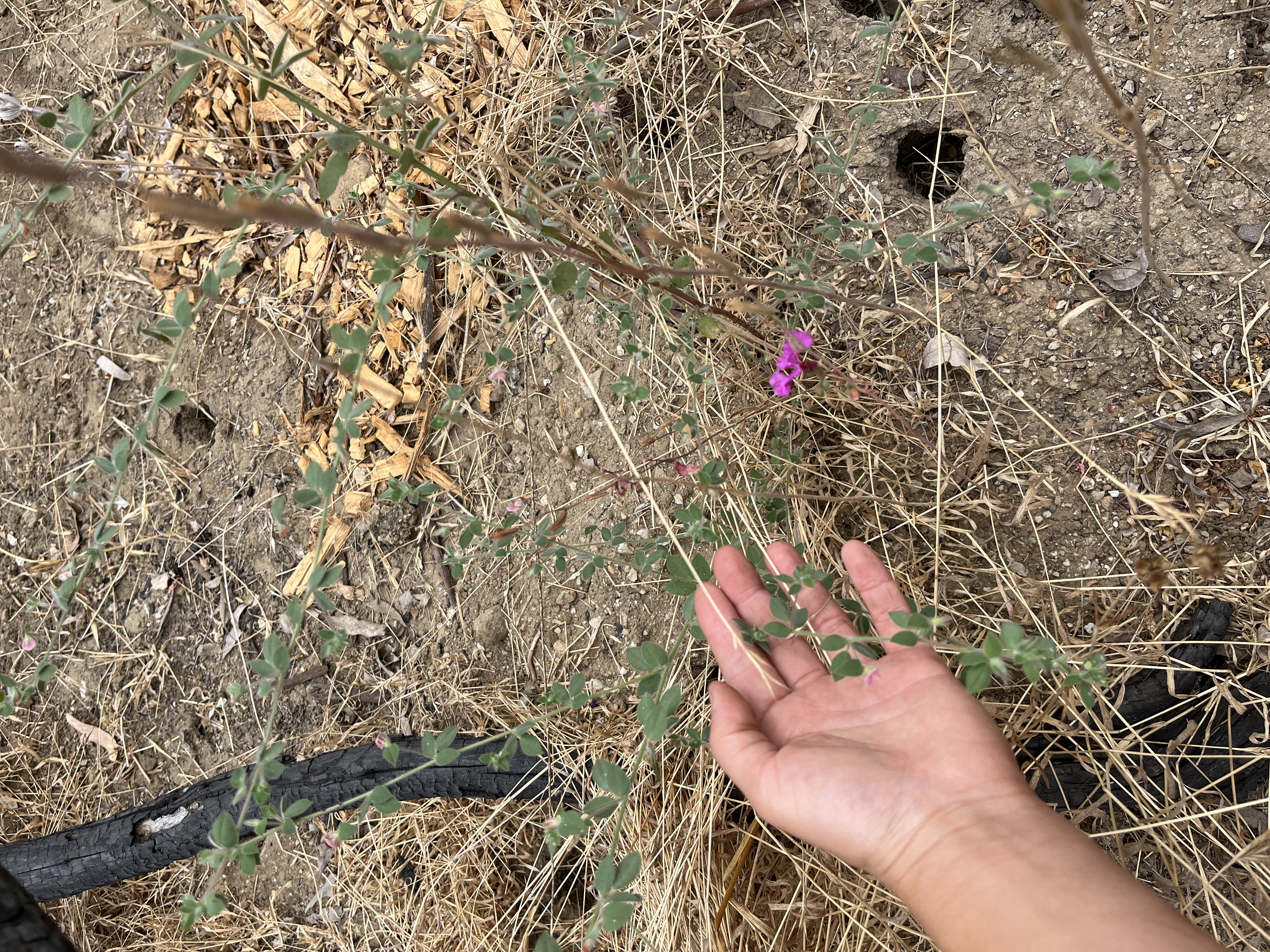
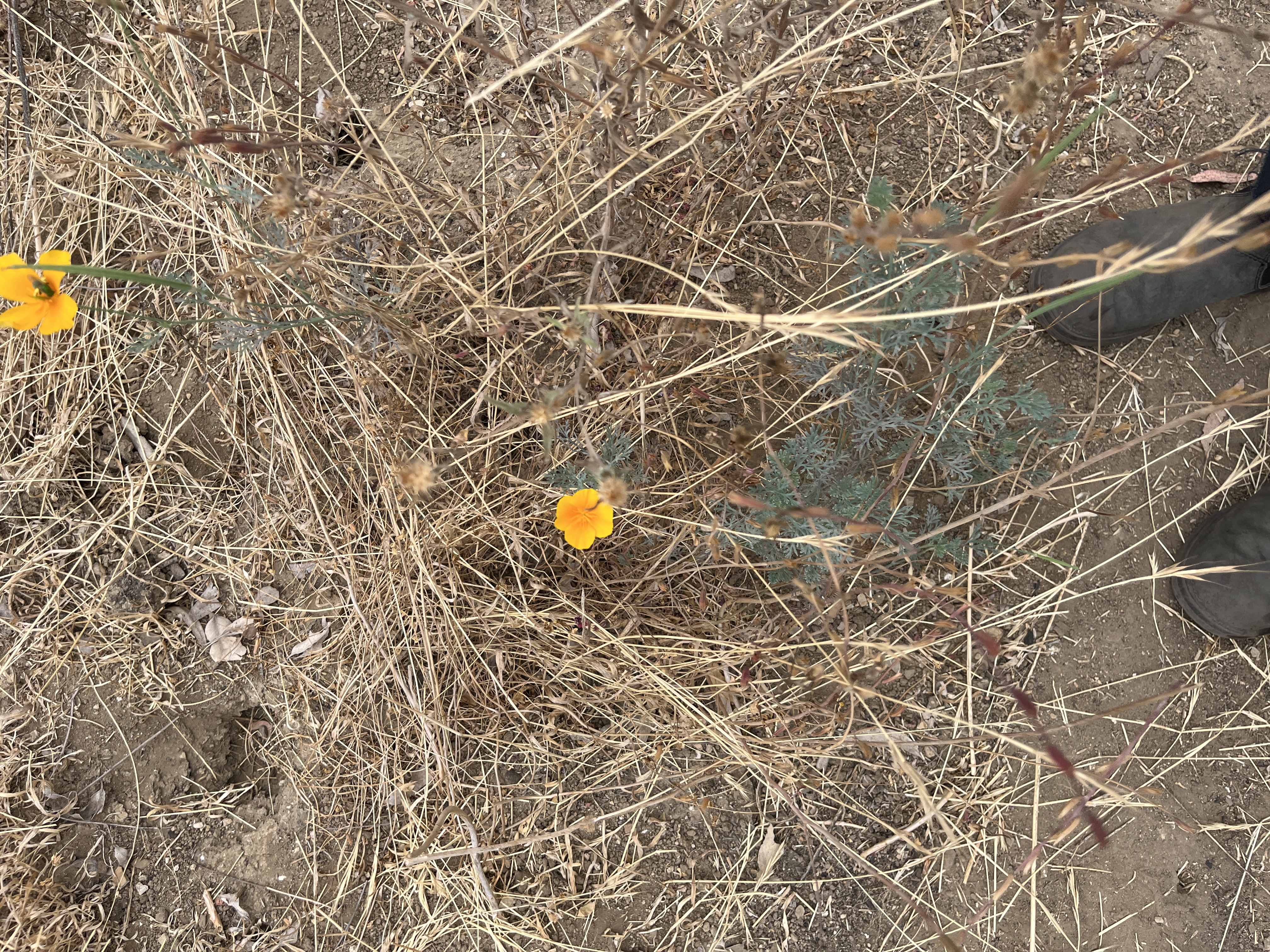


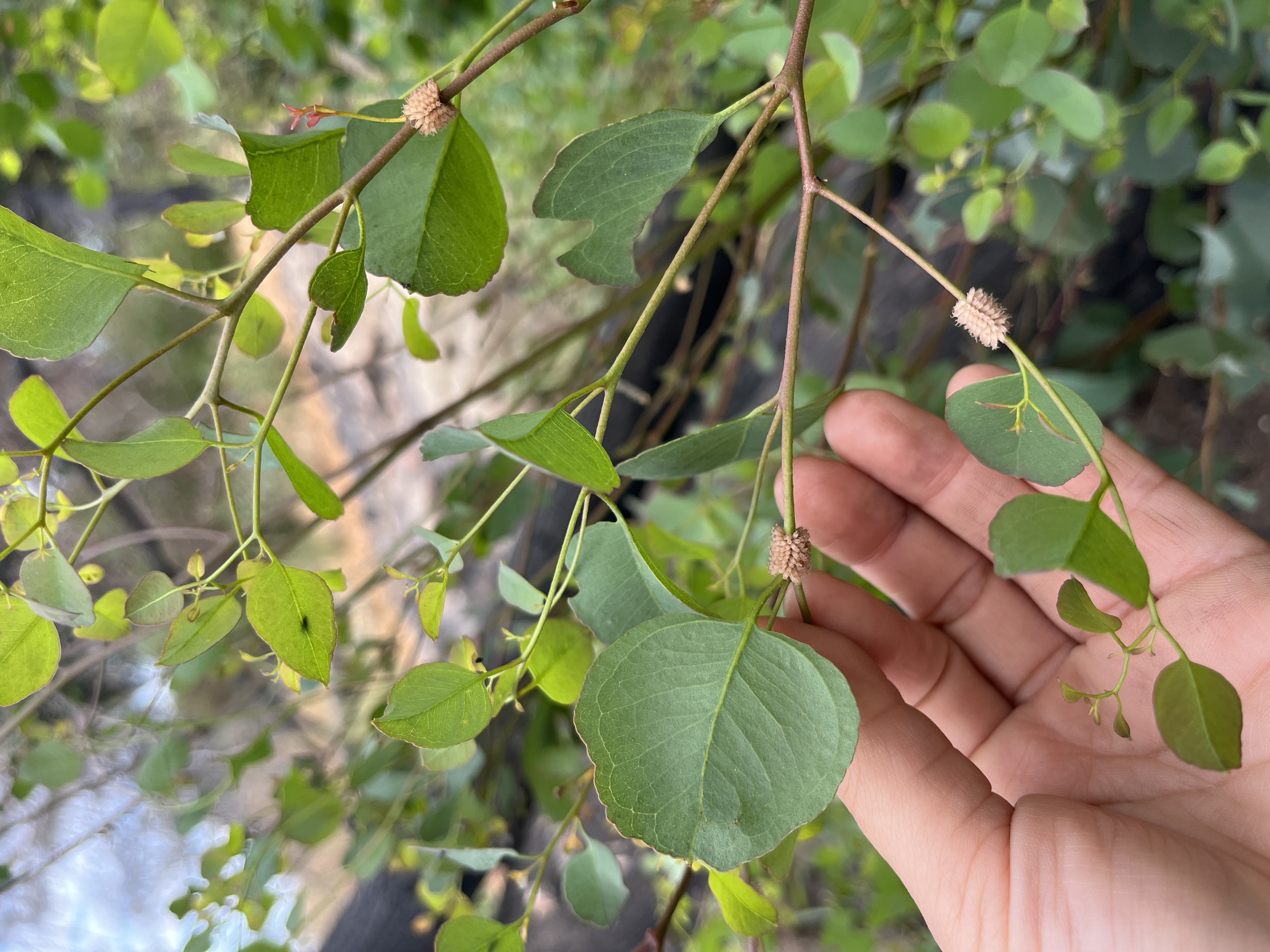

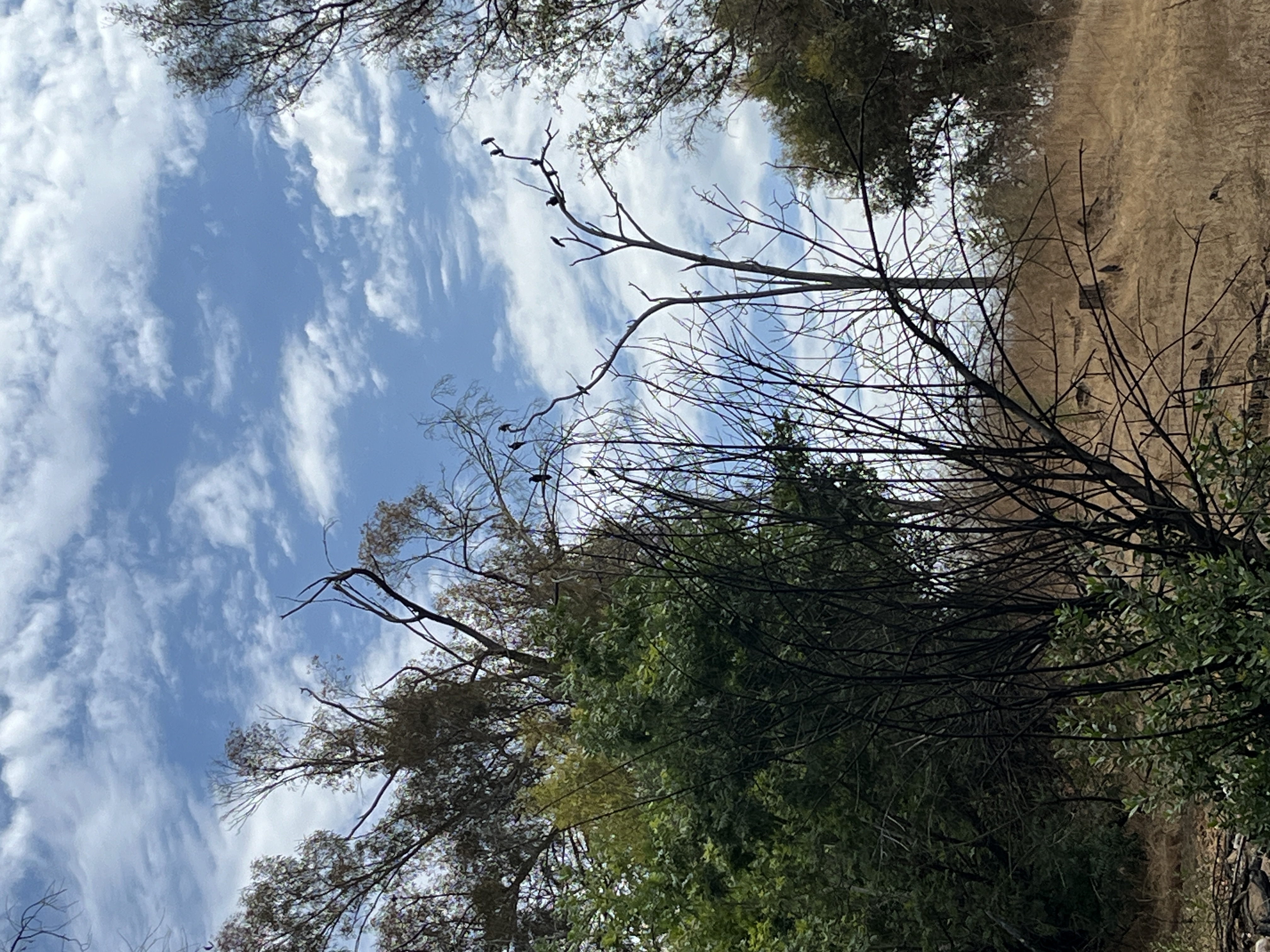
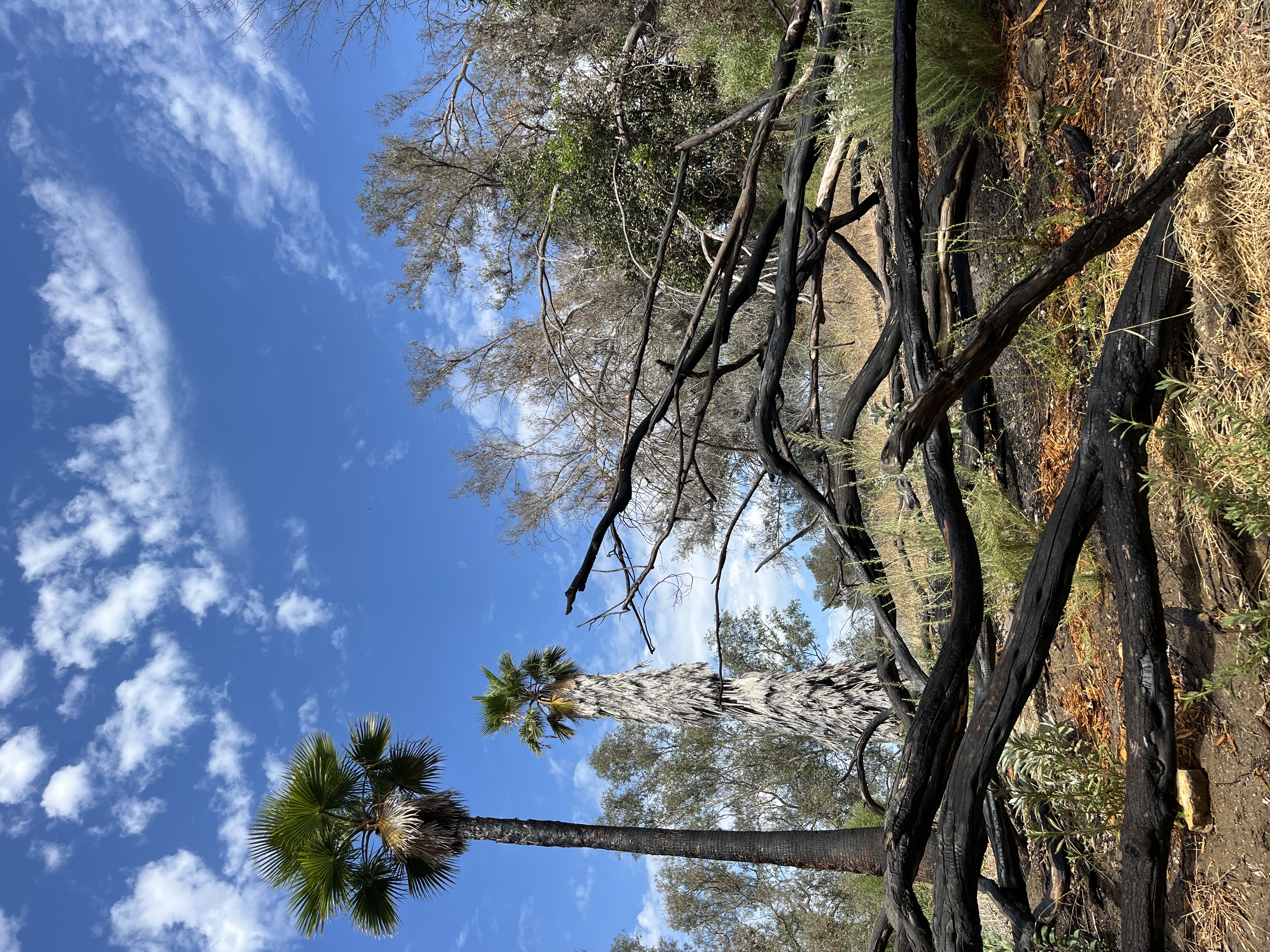


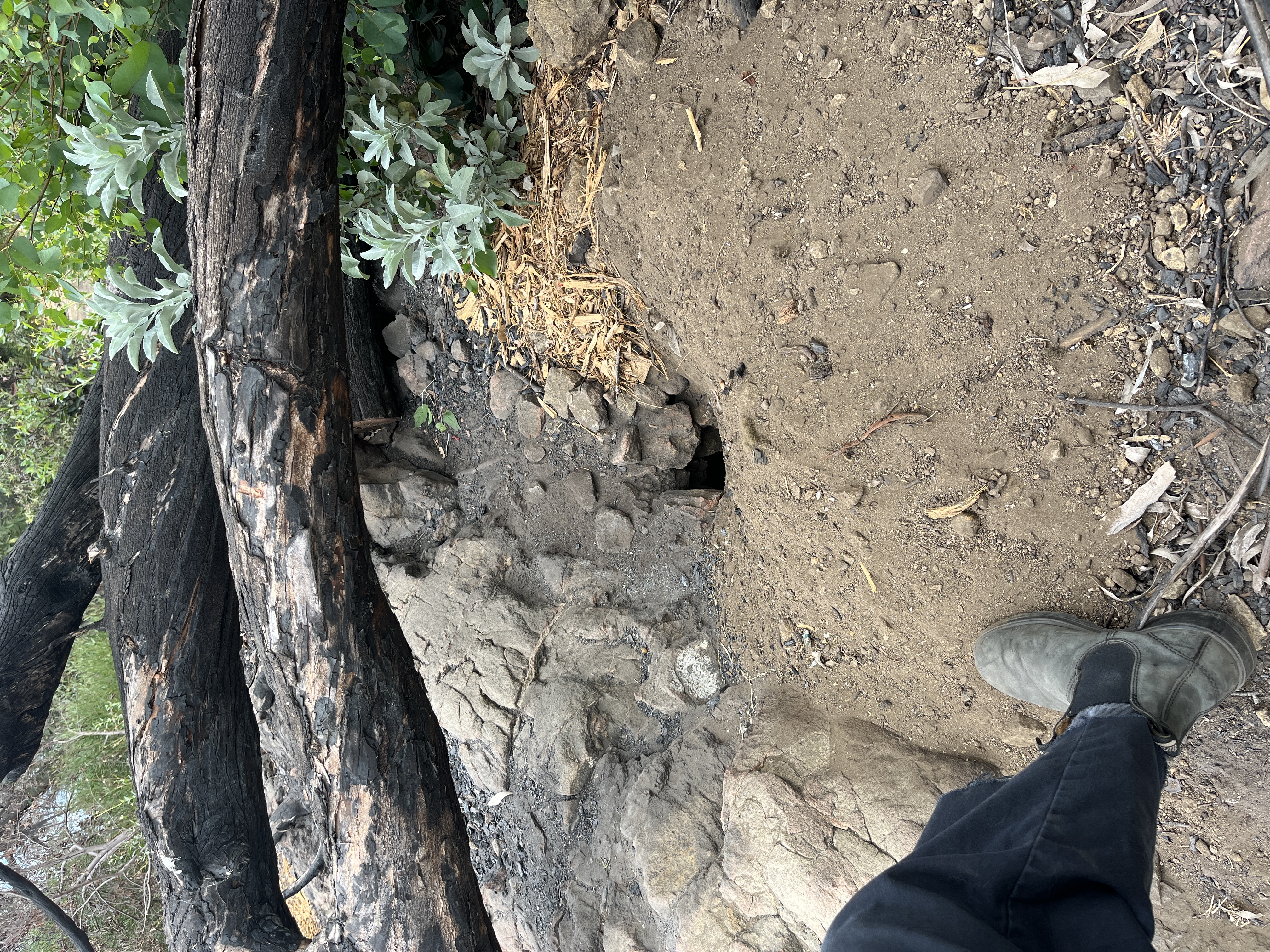
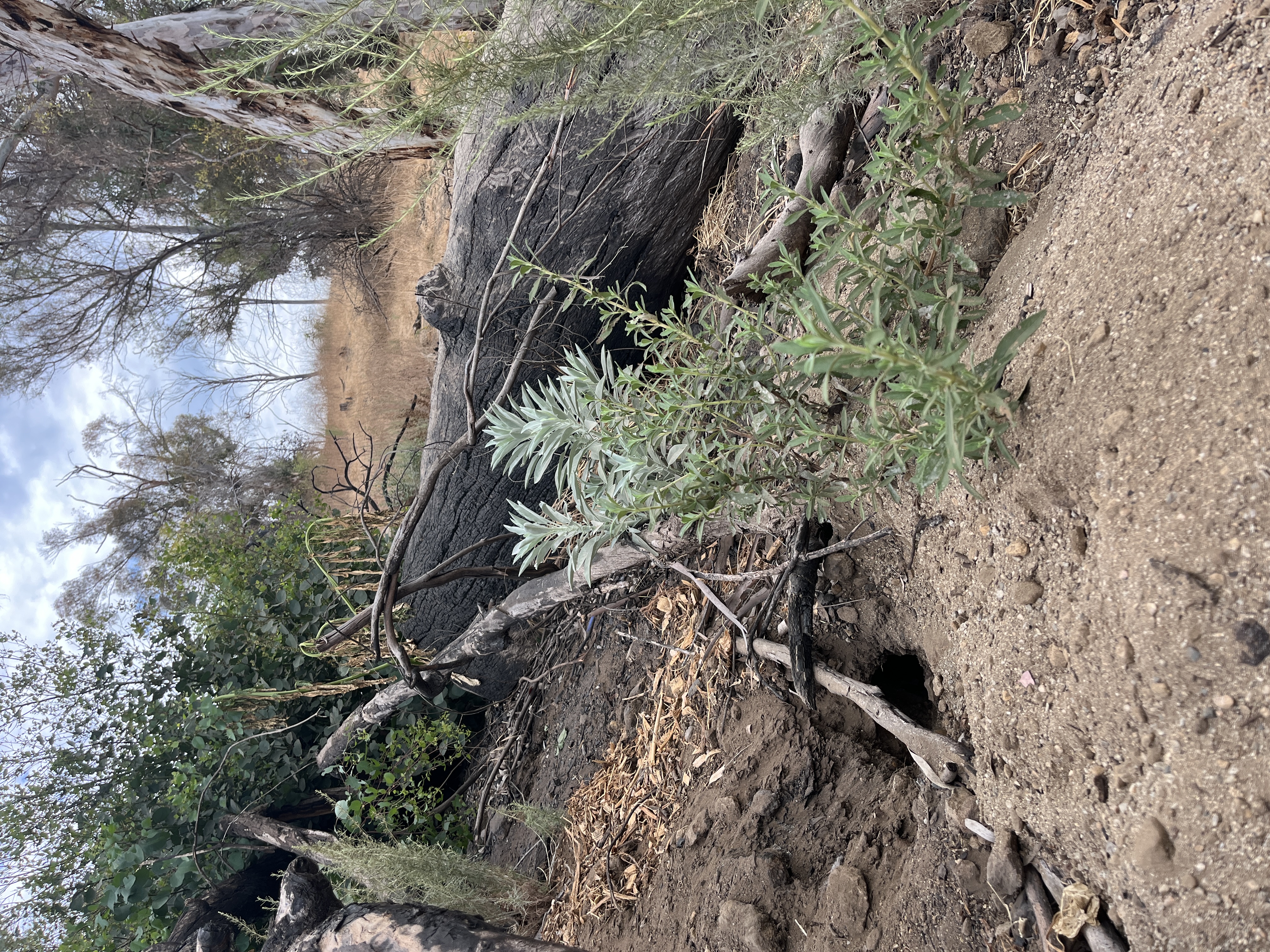
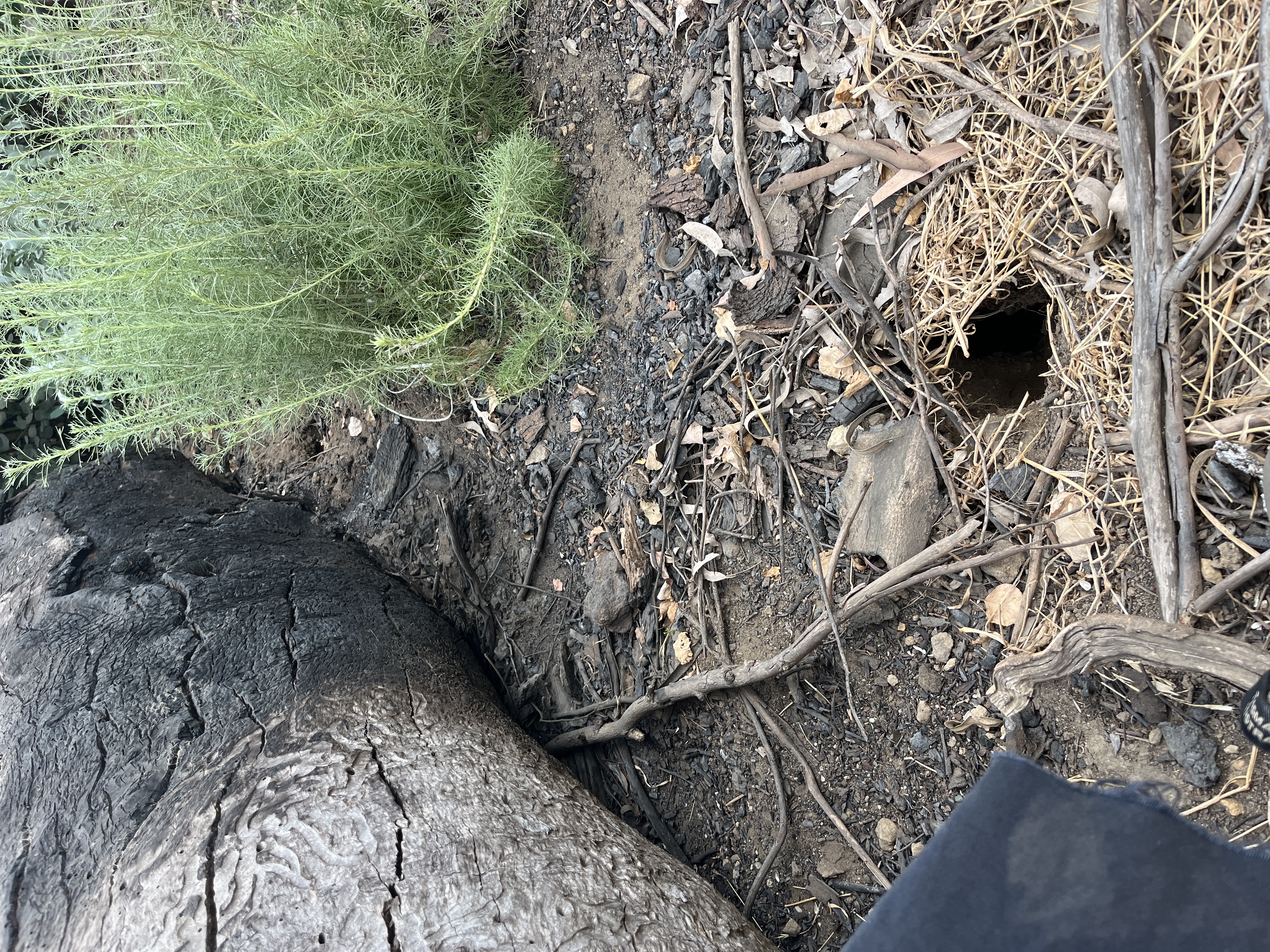
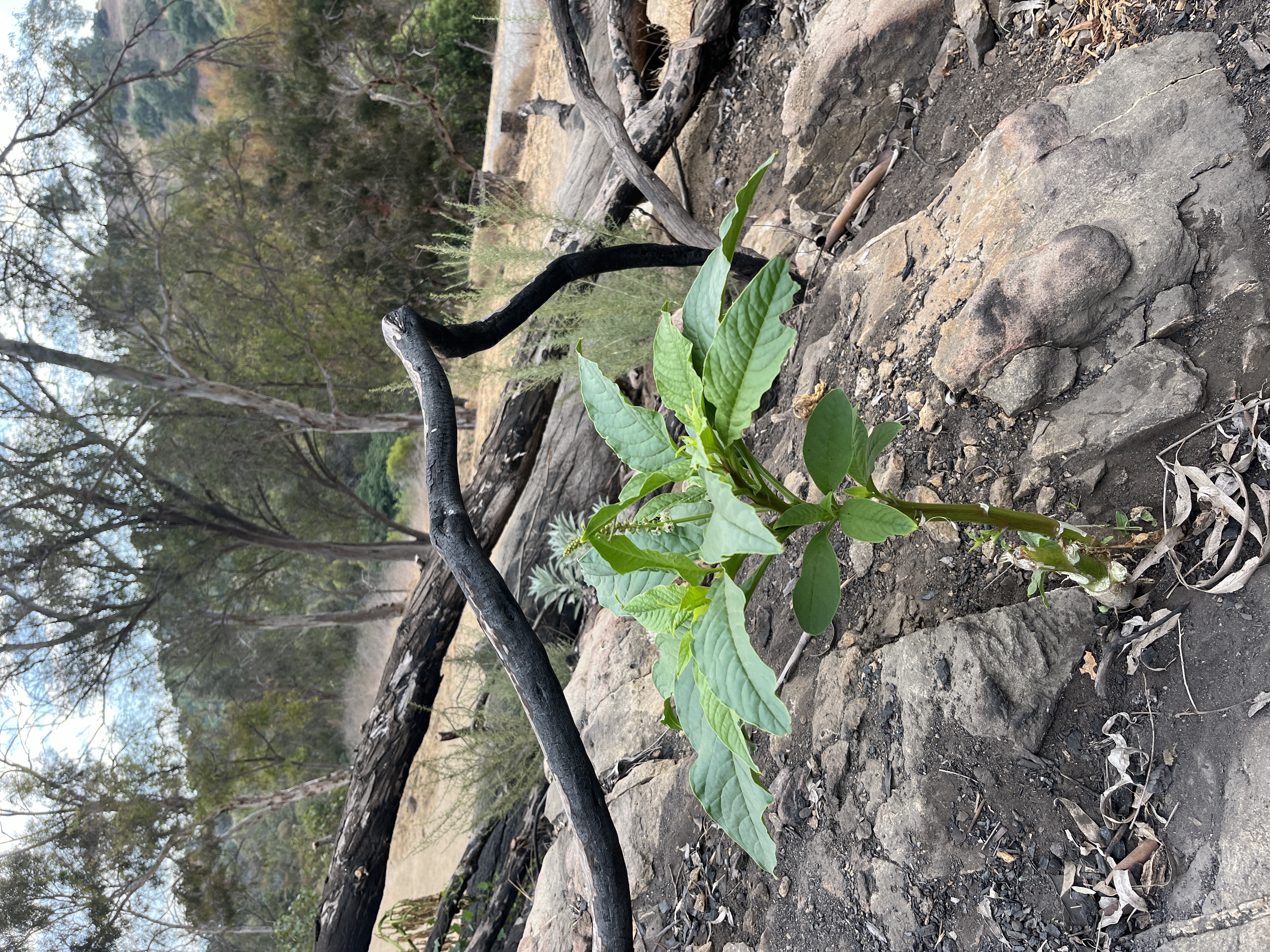

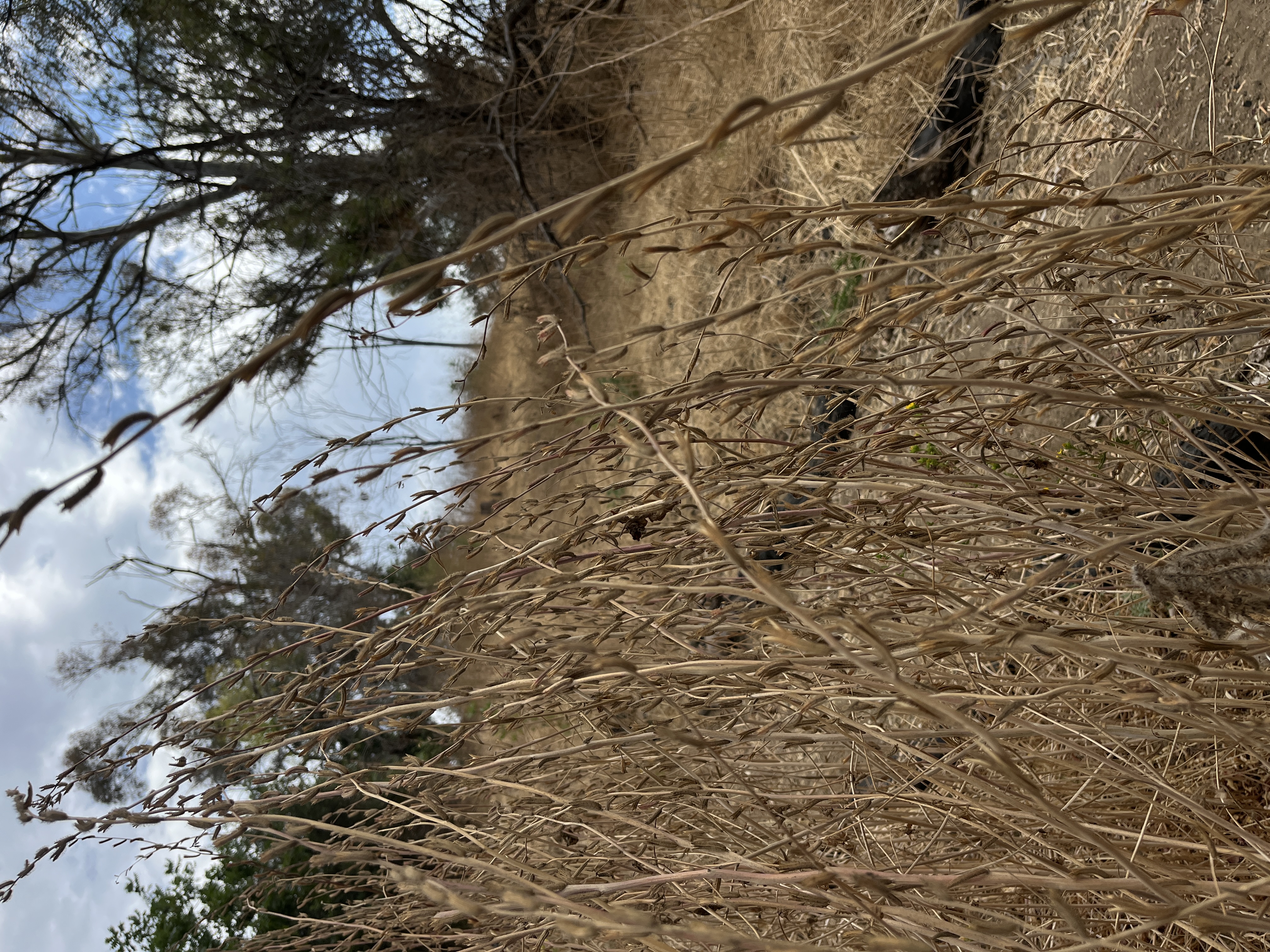


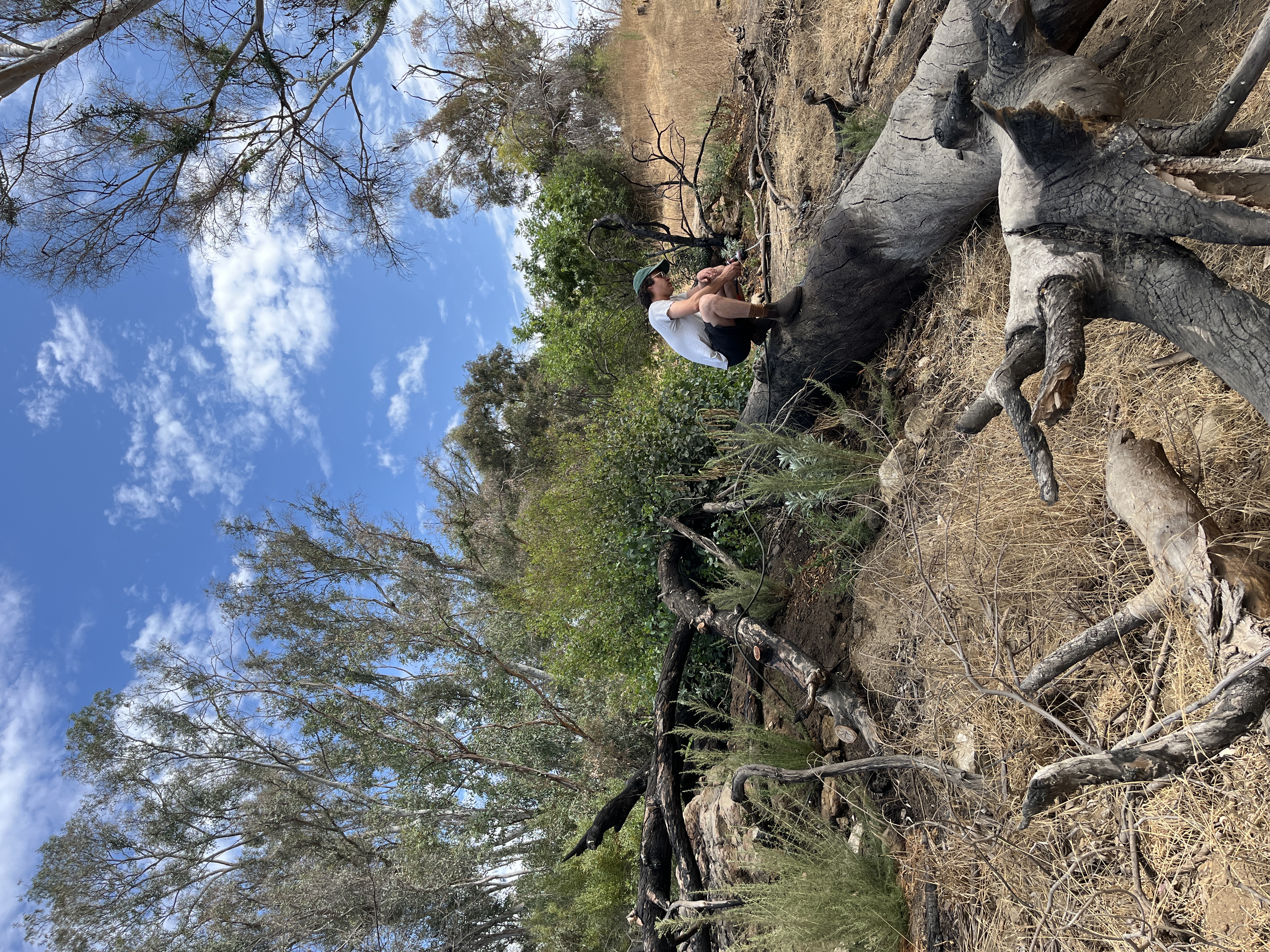

DISTURBANCE
Elysian Test Plot
By Jenny Jones
Test Plot Co-Founder, Terremoto Partner
Elysian Test Plot
By Jenny Jones
Test Plot Co-Founder, Terremoto Partner
DATE: July 08 2024
This post is long overdue. I kept meaning to write, but each time I was ready to document the latest events in the plots, something exciting would happen. Or, something devastating—making it hard to write an objective update without being clouded by emotion. But time has passed, dust has settled, and hopefully this entry has just the right amount of both objectivity and heart.
We started the year extremely hopeful, bolstered by the success of the Rainbow River and our experiments with seed in 2023. We planned to expand the Rainbow River with wildflowers from seed, but also created a new plot, our biggest one yet, to test establishing shrubs from seed. We call this new area the Row Plots, as we decided to lay out the plots into agricultural rows, to make for ease of weeding and management. The Row Plots are also a nice foil to the snaking form of the Rainbow River.
The first seeding of the season started very organically: we were simply inspired by the beautiful tufts of seedheads that were proliferating on our goldenbush, goldenrod, and coyote bush plants within the existing plots. One original dream of the Test Plots at Elysian was for them to serve as seed sources for further expansion of native ecologies, outward from the plots. This past fall, it was obvious that the plots were ready to play this role. The seedheads were calling to us, and were just begging to be cast around. Over a series of weeks when I was at the park alone, on a daily walk, I would stop at the plots, and simply break the branches of the bountiful plants. Then I would walk the adjacent hillsides, beating the branches together to dislodge and spread the seed. I felt like a true plant witch, casting spells with my wands, sending dreamy drifts of seeds floating through the air. It was easy, free, joyful work.



Then we got a little more serious and made our plans. We re-seeded the Rainbow River, unable to let ourselves be patient and see if it would reseed itself. It was simply too beautiful last year to not do it again. Maybe next year we’ll hold back and see what comes up on its own. We also laid out the Row Plots, and used flags to carefully mark both seeded areas. While the Rainbow River was about putting on a show of wildflowers, in the Row Plots, we seeded mostly shrub species. We dappled in some clarkia and poppies for a little splash of color in the first year. The rains blessed us big time this year, and our adorable seedlings quickly started coming up.
![]()
![]()

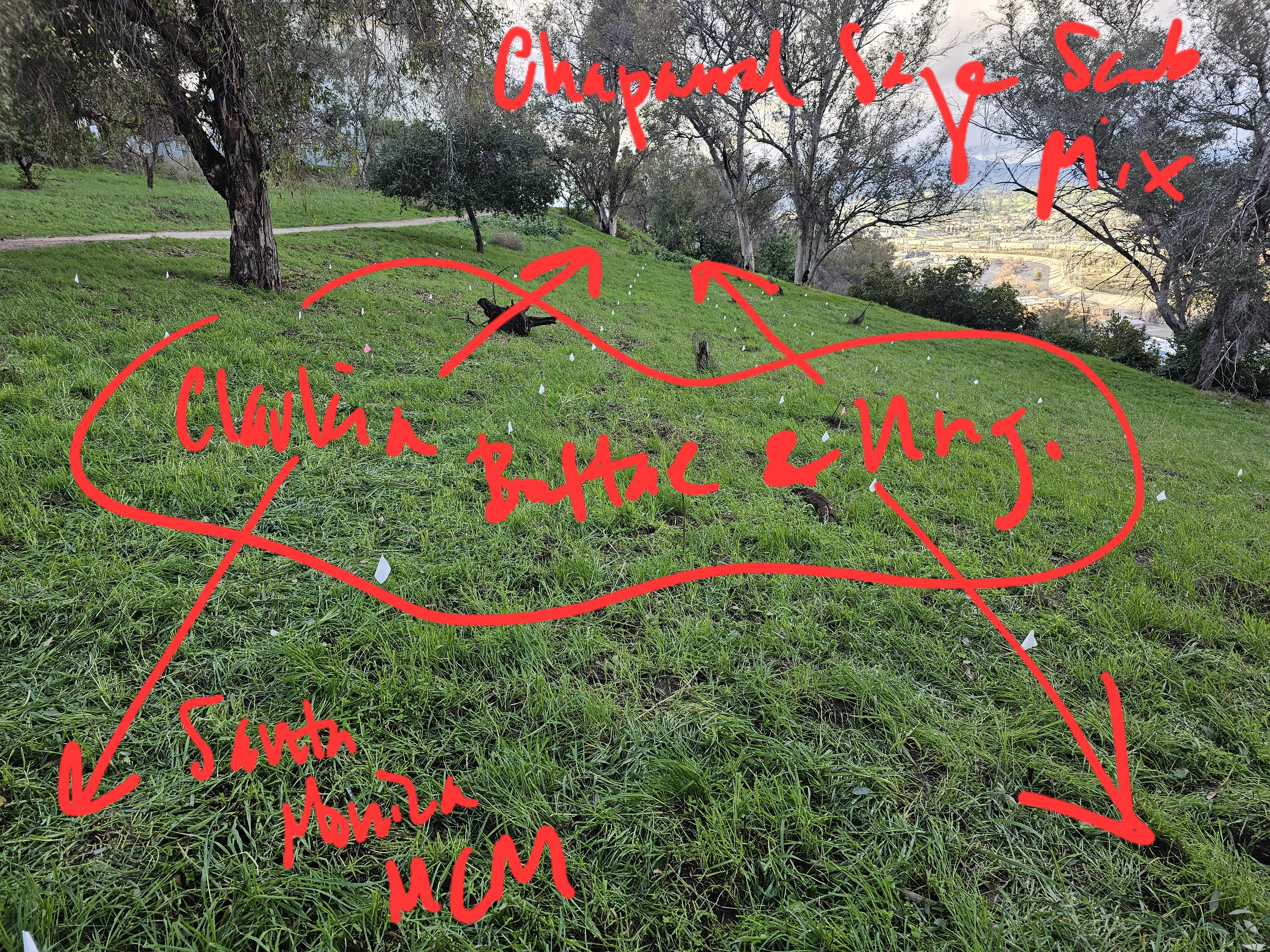
Enter the first setback. One day in February we showed up to work at the plots, to weed among the seedlings. And we found every single one of the hundreds of flags we had laid out, simply gone. We were confused for a bit, wondering if possibly Rec and Parks didn’t like what we were doing this year and had intervened. But then we found all the flags, along with some lovely hand-painted signs we had made, all thrown down the hill scattered in the brush. We still haven’t found the logic in this act, as none of the plants themselves were damaged. All of our work was technically still intact, which was a relief, but it still felt like a violation, nonetheless. We collected the flags we could reach, some of us getting poison oak in the process, and we re-placed the flags as best we could. And kept going.
In March we held several events to bring in and train new volunteers. It was heartwarming to see so many folks come out to lovingly tend to the seedlings, pulling invasive grass and mustard by hand to allow the wildflowers a chance to compete. In addition to hand-weeding, we did a lot of scything this year. We had been experimenting with simple hand-mowers for a few years, but this year Terremoto acquired two real scythes, and we sure had a lot of fun with them. We decided to scythe all around the Rainbow River, thinking it might just be helpful to slowly beat back the mustard and interrupt is cycle of going to seed. We also used the scythes in the Row Plots, both to do the initial site clearing, as well as to keep the weeds between the rows in check. We found that the scything is indeed helpful, and gets a lot of work done in a short amount of time. We also found success in the Row Plots with scything as the only site prep. When timed perfectly before a big rain, no other soil or site prep was needed to see seedlings come up and compete with the invasives. This bodes well for expanding, getting more seedlings established at a larger scale throughout the park, because the labor inputs are fairly low.

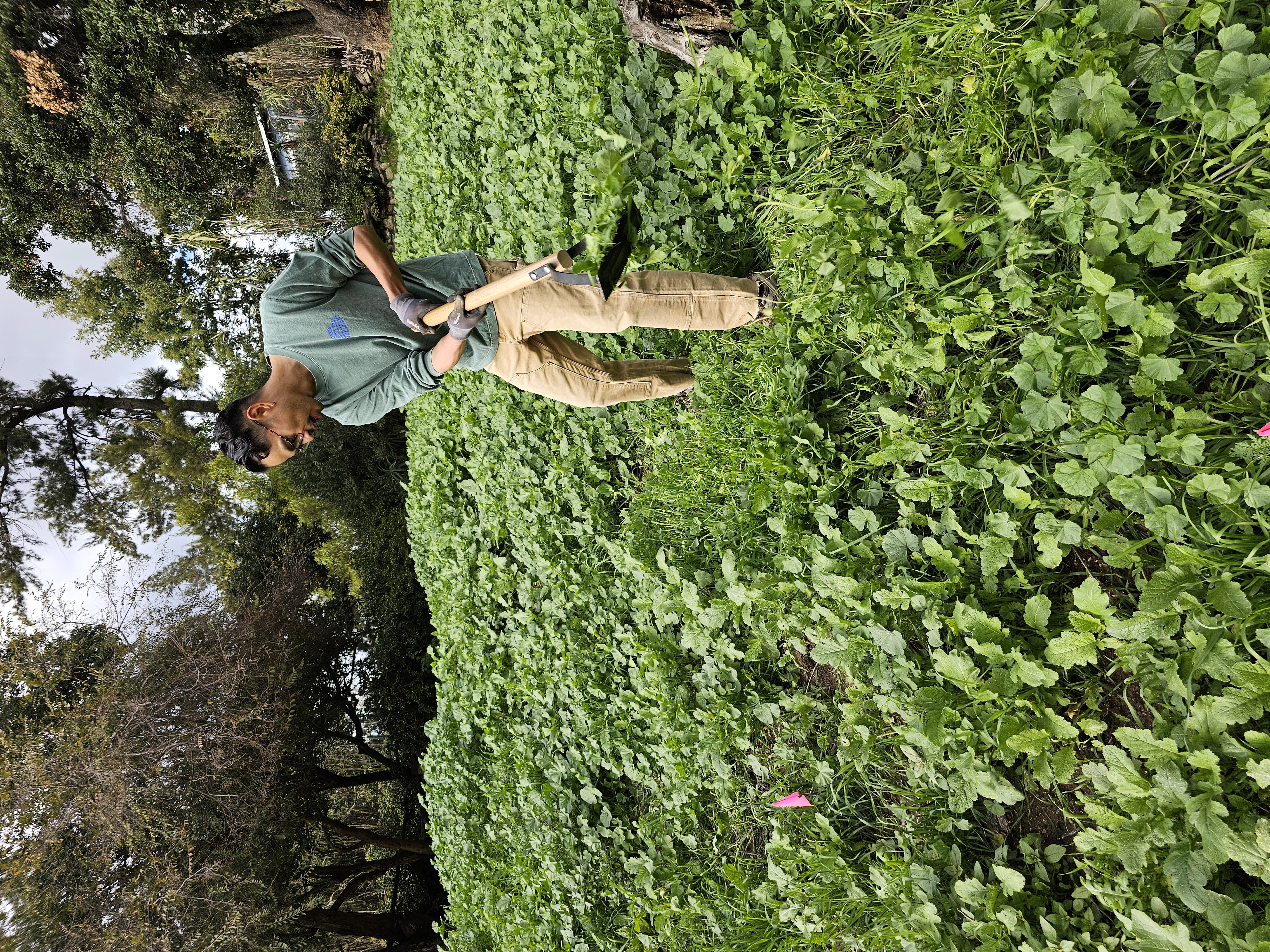

By April we had blooms coming along nicely, and we kept weeding out the grass and mustard. Critters started appearing on the blooms, butterflies, bees, flies, and moths. We suffered another little setback when someone decided to walk through the Rainbow River, leaving a little path of destruction in their wake. We decided to not assume it was intentional, and we simply adjusted some of the wood stakes we had out there marking where to walk across the river. We propped some of the seedlings back up and hoped they’d bounce back. The Row Plots were a few weeks behind the Rainbow River in terms of growth, a mixture of slightly later seeding and the fact that they are on a north-facing slope.
![]()
![]()
![]()
![]()




When May came, so did the flowers. The Rainbow River seemed to pop overnight, into a technicolor array of blooms: Owl’s Clover, Phacelia, Poppies, Lupines, Chia, and of course Clarkia. This year we added in Clarkia bottae that we had collected from the next ridge over in Elysian Park. It’s a tall, striking Clarkia with flowers that are perfectly freckled with dark pink spots. We hope to do even more seed collection from around the park this fall. This year did not bring the massive amount of White Lined Sphinx Moth Caterpillars that we saw in 2023. We did see a few, but nothing like the hundreds if not thousands that were on the Rainbow River last year. We can’t say whether that was just nature’s way, or whether it’s because we did something different. We can’t control all the variables at the plots, and we’re ok with that. We still worshipped the few that showed up.



Then on the morning of May 22nd, I went to check on the blooms, and saw that the Rainbow River had been trampled. I was devastated. I wondered if there’s any way it could have been coyotes having a romp, or someone accidentally walking through at night when they couldn’t see. But then I noticed that all the flags in the Row Plots were gone again, and my only conclusion was that it was another intentional act of vandalism. My heart was broken at the thought of someone deciding to trample all those heavenly beings. After all the hours and hours of loving care that dozens of people put into bringing these wildflowers into the world, over months and months, one person in one night trampled it all. I couldn’t understand, and I was angry.
But I called Jen Toy, who kindly commiserated with me, but then also wisely reminded me that we are working in an urban park, where realities like this are inevitable. She reframed this event as simply one of Disturbance, just another Test for us. Once that sank in, I calmed down and was able to see the trampling as an event to witness and to work with, not one to get defeated by. I moved through the sadness to see the good: that our Row Plots were still coming in, and miraculously hadn’t been damaged; that all of our original plots with fencing were unharmed and were in full glory of flower and abundance; and that actually, people walking through the park were still stopping to tell me how beautiful the flowers were, even though they were now lying down on the ground, broken and withering. And in fact, the bees were still visiting them.
However there was more Disturbance to come. A few weeks later, the brush clearance crews swept through the park. Despite the fact that we had already cleared most everything with scythes, the weed whackers still came through and went scorched earth on the land. A saving grace for me after the flower trampling was that there were still many tiny goldenbush and coyote bush seedlings that were coming up all over. But the crews came through and cut down everything in their path, unless we had a fence around it, or there was a flag marking it. I realized when I witnessed the crews doing this, how very violent and counterproductive this annual brush clearance is. Any tiny native that tries to come up in the spring is destined to get mowed down, essentially maintaining the park as a constantly disturbed site where no native ecology is allowed to live. Not to mention the countless birds, insects and small mammals whose lives are disrupted or destroyed when an army of men with machines tear through the park. Rec and Parks should be caring for the park, not inflicting this violence upon the land. Their brush clearance this year has upset other community members as well, when they destroyed a beloved children’s garden that was full of mature native plants, all in the name of fire safety.
So.
What can we do? We’re trying to help regenerate an urban park that suffers from constant vandalism and violence, from without and within. We plan to speak with our coalition of concerned community members to see what we can change with the overall management of the park. We have a proposal brewing for a pilot project of turning brush clearance duty in and around the plots over to our coalition of community groups. Although we were hoping to be able to not always need fences at Elysian, we’ve learned the hard way that the plants need protection. The disturbance we experienced this winter has lit a fire in our bellies, and we are planning to go even bigger with our scything and seeding work in the years to come.
And as it turns out, a few of the goldenbush that were whacked down are actually still alive, eager to persist. We’ve marked them, protected them, and are watering them this summer. We will keep going with our steady acts of care, moving slowly, gently, and lovingly, inspired by the resilience and persistence of our beloved California plants.


UNDER THE EUCALYPTUS
San Bruno Mountain Test Plot
By Victoria Bevington
Test Plot and ULAP Fellow
This is the first time in a while I’ve been at the Test Plot alone. A nice moment to reflect on just the plants and myself, here in late fall in the middle of the hardest times for these new plantings. It’s good to see who is still here after making it through some lucky late winter rains and the typical dry summer.
I was there on the day these plants were put in (March 2023), and I often think back about how fortunate we were that it rained immediately the day after they went into the ground. As much as I want to report on how the activity of the human stewards of this piece of land has affected their survival, so much of it seems to be about fluctuating environmental factors which no one can control. If it had been a winter as thirsty as the previous year’s, how different would things look here?
Our intent when developing the Test Plot was to examine what plants would survive under the eucalyptus canopy, and what some rudimentary maintenance would do to help along their chances. There is no supplementary irrigation, no gopher cages although we’ve established a fence around the plot to keep out the aggressive San Bruno Mountain rabbit population.
Again, our variables are nullified by huge inhuman factors. The eucalypts around us have decided that everything is to be mulched by their leaf fall. The allelopathic qualities of these leaves as they decompose is something else we may want to monitor.
San Bruno Mountain Test Plot
By Victoria Bevington
Test Plot and ULAP Fellow
DATE: November 13 2023
This is the first time in a while I’ve been at the Test Plot alone. A nice moment to reflect on just the plants and myself, here in late fall in the middle of the hardest times for these new plantings. It’s good to see who is still here after making it through some lucky late winter rains and the typical dry summer.
I was there on the day these plants were put in (March 2023), and I often think back about how fortunate we were that it rained immediately the day after they went into the ground. As much as I want to report on how the activity of the human stewards of this piece of land has affected their survival, so much of it seems to be about fluctuating environmental factors which no one can control. If it had been a winter as thirsty as the previous year’s, how different would things look here?
Our intent when developing the Test Plot was to examine what plants would survive under the eucalyptus canopy, and what some rudimentary maintenance would do to help along their chances. There is no supplementary irrigation, no gopher cages although we’ve established a fence around the plot to keep out the aggressive San Bruno Mountain rabbit population.
Again, our variables are nullified by huge inhuman factors. The eucalypts around us have decided that everything is to be mulched by their leaf fall. The allelopathic qualities of these leaves as they decompose is something else we may want to monitor.

General
- Mulch vs nonmulch sections don’t make much of a difference - the overhead Eucalyptus have mulched them all
- A few common weeds returning: grasses, sow thistle, meadow vetch and weedy geraniums
- Blackberry sprouts everywhere; ones we flipped back along the fence are still alive. They are particularly prolific in freshwater seeps and marsh section; wettest region
Prairie + Grassland Section
- Some existing miners’ lettuce returning
- Phacelia californica doing great
- Clarkia rubicunda dead
- Gopher activity has done a lot of damage
Oak Woodlands
- Artemisia douglasiana doing particularly well
Freshwater Seeps + Marsh
- Cornus seneca vastly differing in sections, but I suspect the mulch vs nonmulch is not a factor
- Helenium puberulum + Symphotricum chilense doing well
- Gopher activity here as well
Coastal Sage Scrub
- Lovingly planted yarrow and Epilobium doing well




Community Activity
We’ve done so much this past summer and into the fall! In no particular order: work with Yoni Carnice and ULAP, a cultural collective centering the stories and work of Pinoy creators in and around the Bay, particularly around Daly City. We’ve done art and flower-arranging workshops with community elders, and a visit with a legendary Daly City artist, and have further plans for the winter. ULAP also just launched its new website, where you can find resources and records of our various projects.
We’ve done several interpretive events in and around the Test Plot, including a Red Elderberry hike and Eucalyptus Hike. Both walks were an exciting way to further explore the surrounding landscape through the lens of these two specific species. And, of course, we did a number of work days at the site that involved mulching, weeding, planting, and monitoring species composition and survivorship.
My own work involved interviewing members of my family and weaving what I learned with voices from the community. Earlier this year, we put out a community survey that, while asking practical questions about public familiarity and uses of the mountain, also collected more poetic answers to questions like “Why do you think Daly City is so foggy?
I created a zine that enfolds the answers into a written piece, mixed together with interviews I conducted with members of my family. I talked with my mom and my uncles, who themselves were second-generation immigrants, illustrated the difficult experience of growing up Asian-American in a Daly City that had not yet become the Pinoy Capital of the Bay Area. I also interviewed my brother, and with his experiences and mine, tried to briefly sketch a portrait of my family and its complicated diaspora.



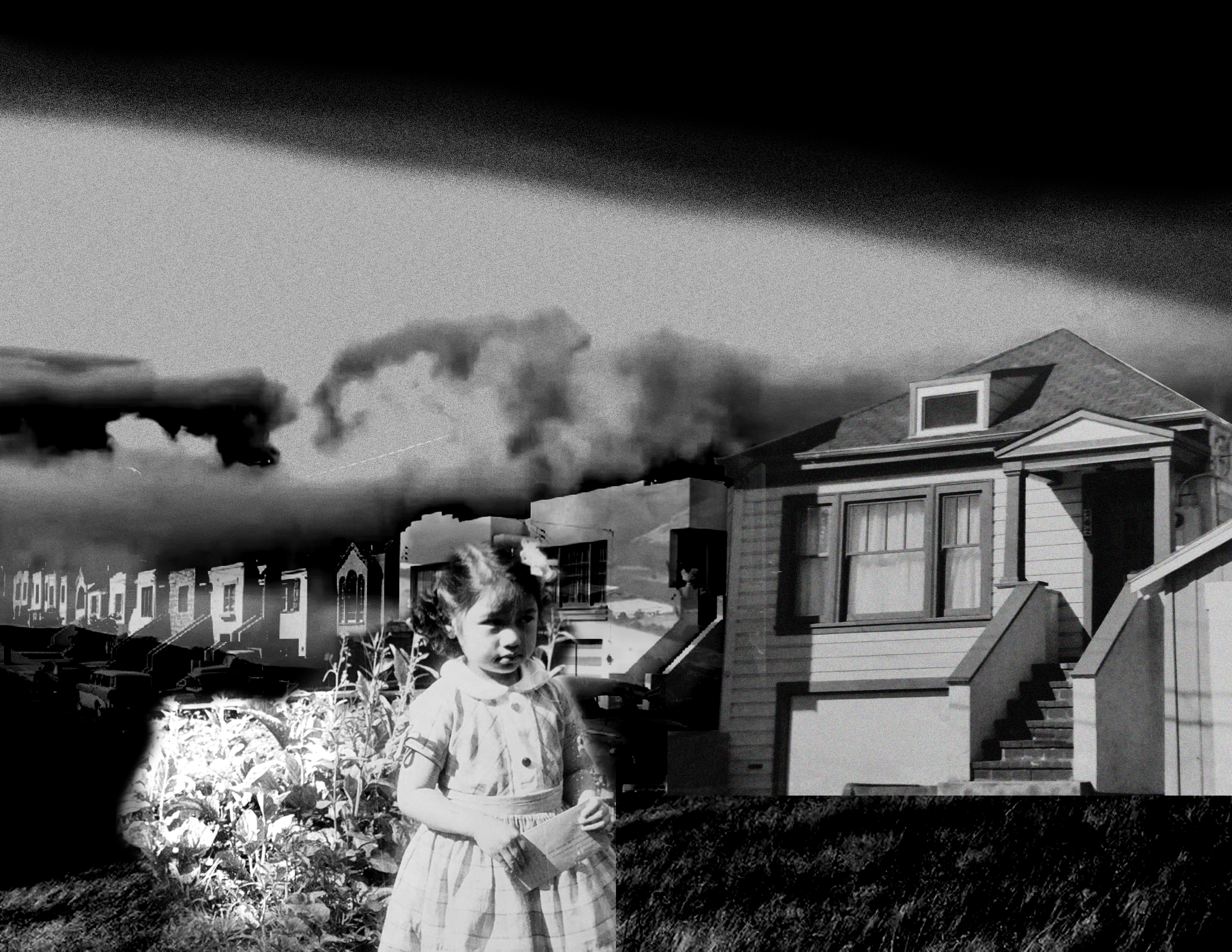





STARR KING INTRO
San Francisco Test Plot
Terremoto
The Starr King Test Plot sits on a serpentinite hilltop in the Potrero Hill neighborhood of San Francisco. This site is part of an intermittant strip of serpentinite bedrock that stretches across the city to the northwest and ends in the Presidio (see purple blobs in the geologic map below. Starr King, a little patch of neighborhood open space, and meadows in the Presidio, are the only extant serpentine grasslands in the city.
Terremoto plans to investigate various weeding and seeding methodologies that can be applied to the rest of Starr King and to Terremoto projects. We hope to grow some starts from archival seed from the site. And we’ll be figuring out how to water as little as possible since there is no great access nearby.
But first, we will get to know the site through regular observations for a WHOLE YEAR. During this time our only intervention will be passive restoration through the careful removal of certified grade A weeds. We just met, but we’re looking forward to developing a deep relationship with this land. We’re hoping that by slowing, listening, looking and being with, we’ll develop an ability to hear what the site is telling us it needs. This slow, relational approach is borrowed wisdom from our friends at The Cultural Conservancy which we picked up on our visit to their Heron Shadow project. We’re also hoping to engage with local community through this TEST PLOT - Starr King regulars, volunteers from the Terremoto-verse, and new faces from the neighborhood.
Follow our observations by clicking on the Starr King tab at the footer.
San Francisco Test Plot
Terremoto
DATE: November 2023
The Starr King Test Plot sits on a serpentinite hilltop in the Potrero Hill neighborhood of San Francisco. This site is part of an intermittant strip of serpentinite bedrock that stretches across the city to the northwest and ends in the Presidio (see purple blobs in the geologic map below. Starr King, a little patch of neighborhood open space, and meadows in the Presidio, are the only extant serpentine grasslands in the city.
Terremoto plans to investigate various weeding and seeding methodologies that can be applied to the rest of Starr King and to Terremoto projects. We hope to grow some starts from archival seed from the site. And we’ll be figuring out how to water as little as possible since there is no great access nearby.
But first, we will get to know the site through regular observations for a WHOLE YEAR. During this time our only intervention will be passive restoration through the careful removal of certified grade A weeds. We just met, but we’re looking forward to developing a deep relationship with this land. We’re hoping that by slowing, listening, looking and being with, we’ll develop an ability to hear what the site is telling us it needs. This slow, relational approach is borrowed wisdom from our friends at The Cultural Conservancy which we picked up on our visit to their Heron Shadow project. We’re also hoping to engage with local community through this TEST PLOT - Starr King regulars, volunteers from the Terremoto-verse, and new faces from the neighborhood.
Follow our observations by clicking on the Starr King tab at the footer.
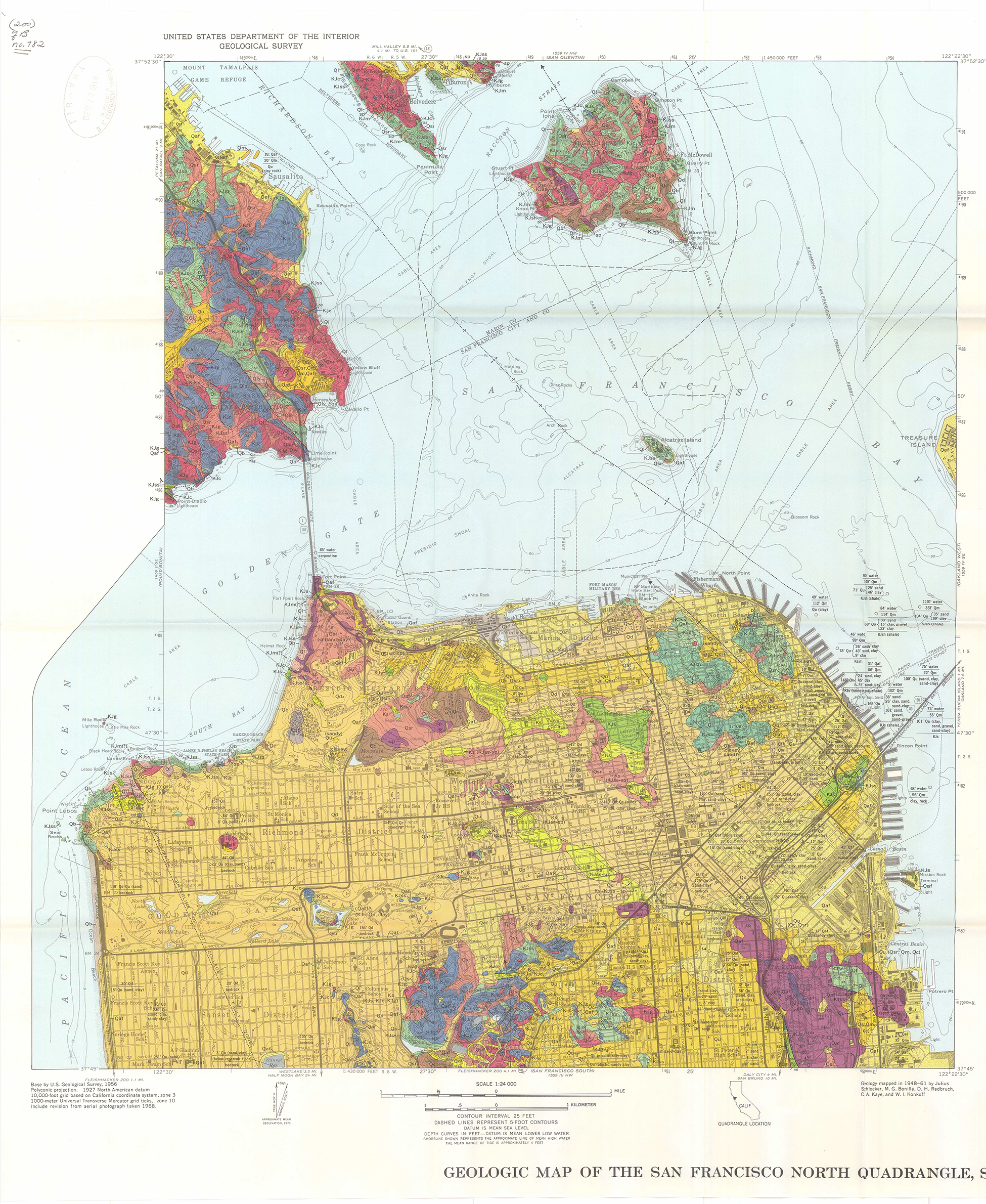
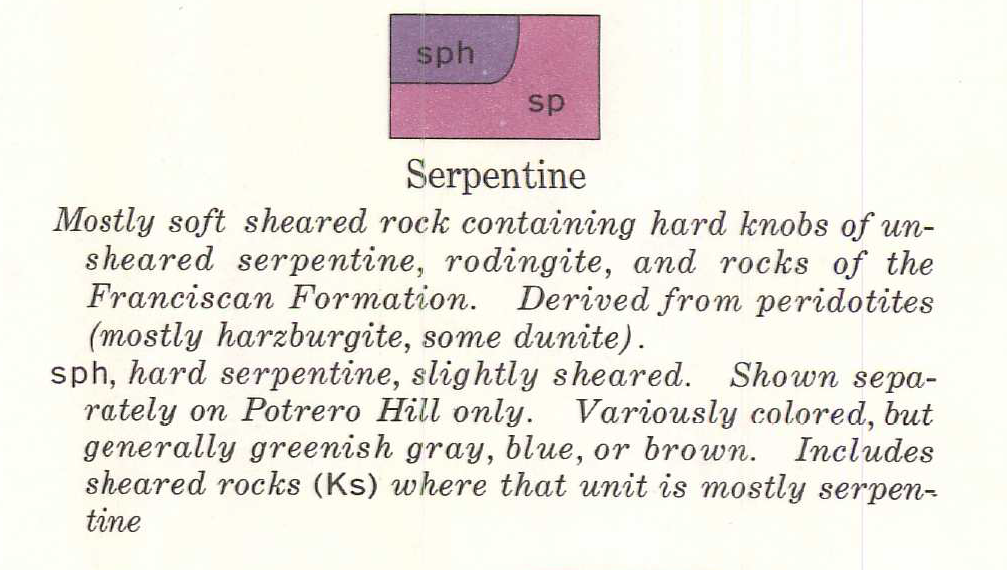

WATCHING WEATHER
Elephant Hill Test Plot
Interview with Joey Farewell by Jen Toy
DATE: October 16 2023
Jen: I wanted to create this post to share information with our Test Plot community about the wondrous topic of weather. Watching weather patterns and climate forecasting is both an art and science. It’s also increasingly necessary for the business we’re in, and a field that I want more people to understand given the weather extremes we’re all living through nowadays. To that end, please enjoy this conversation with Joey Farewell, a resident of El Sereno, conservation co-chair of Los Angeles CNPS, and unofficial Test Plot meteorologist.
PS. easy access to the links that Joey mentions:
WeatherWest Blog (check out the comments)
Tropial Tidbits (access to GFS model)
National Weather Service
Ambient Home Weather Station
Weather Underground (crowd sourced data from home stations)
Elephant Hill Test Plot
Interview with Joey Farewell by Jen Toy
DATE: October 16 2023
Jen: I wanted to create this post to share information with our Test Plot community about the wondrous topic of weather. Watching weather patterns and climate forecasting is both an art and science. It’s also increasingly necessary for the business we’re in, and a field that I want more people to understand given the weather extremes we’re all living through nowadays. To that end, please enjoy this conversation with Joey Farewell, a resident of El Sereno, conservation co-chair of Los Angeles CNPS, and unofficial Test Plot meteorologist.
PS. easy access to the links that Joey mentions:
WeatherWest Blog (check out the comments)
Tropial Tidbits (access to GFS model)
National Weather Service
Ambient Home Weather Station
Weather Underground (crowd sourced data from home stations)

Jen: Hey Joey, welcome and thanks for chatting today. How did you get interested in following weather?
Joey: Hi Jen! I’ve always really enjoyed the weather and its nexus with many of my favorite interests –– chasing powder for skiing & snowboarding, growing native plants, and learning about Californian habitat. I also grew up with a father who’s totally obsessed with weather, so meteorology was (and still is) my way to connect with him. Nothing gets my dad more fired up than a big snow cycle forecast for 5-7 days out in the Sierra Nevada –– and it’s really fun to share that excitement.
Also I’m a trusts & probate lawyer, and while I really enjoy estate planning work, meteorology makes for a fun side hobby.
Jen: I’ve heard you talk about how following weather makes you feel good...can you share about that more?
Joey: Yea, accurate forecasting is kind of like having a superpower for the stuff I’m into. You ski better snow (because others foolishly made plans without following the data –– leaving more tracks of deep powder), you plant native plants at better moments (see: our impeccably timed Elephant Hill Test Plot installation, which was followed by 3” of rain just a day later, and our relaxed watering schedule), and you are just generally more connected with the natural world around you. Rain isn’t something that just happens to you that day; instead, you observed a process, maybe learned something along the way, and then perceive the phenomenon of water falling from the sky. It also gives one an illusory feeling of control in an otherwise indomitable universe. So that’s cool too.
Jen: Weather is kind of interesting because it connects global patterns with local experience. How do you think about scale when you are following weather trends?
Joey: That’s an interesting question. I would say that, when it comes to precipitation and snow in California, the storm door is (as we well know) closed more often than it’s open. Global patterns often conspire against us here, particularly in Southern California –– and that seems even more true in an era of climate change and “stuck” weather patterns. When that storm really opens, though, it’s both (generally) great for us and really problematic for other places that are far more accustomed to receiving rain and snow. Big precipitation years in California usually indicate some level of drought in the Pacific Northwest, fires in Australia (particularly during El Niño years), and below-average snow on the East Coast. When we’re scoring, the world often isn’t. That translates to forecasting, too –– when we see big high pressure building in the Hudson Bay region, for example, we can usually assume that the Northeast will get shut out and we can expect stormy low pressure out west. And when we see a pattern favoring cold temperatures and snow in New York, it’s usually time to put away the skis and break out the hose in the garden.


Jen: What is your favorite forecasting model? What is it useful for, and what are the limits?
Joey: Let’s put it this way –– all models are wrong, but taken in context, and in sum, they’re useful. Supercomputing, the internet, model aggregator websites such as Tropical Tidbits, weather blogs like WeatherWest, they all have made for what I consider the golden-age of home forecasting, but with that comes a myriad of ways to misuse that data and get humiliated in front of your friends and colleagues.
So here’s what I do. I generally use the USA-based GFS, not because it’s the best (that would be the ECMWF, the European model and gold-standard for forecasting) or because I’m particularly patriotic (our tax dollars at work, though!), but because it’s freely available, it’s generally pretty good out to 7 days, can spot things with some accuracy out to 10 days, and after that is, to put it kindly, useless. We call the post-12’ish day forecast “fantasyland” in model data, because it’s just too hard at the moment to forecast that far in advance with (1) our computing limits and (2) the inherent chaos of weather. It also “runs” (produces readable data) 4x a day, whereas the ECMWF only runs 2x a day (viewable around noon and then midnight), so the latter isn’t quite as good for a daily weather nerd routine.
For big cycles and events, it’s best to use multiple models –– so that’s when we are looking at the GFS, the ECMWF, and other models like the German IKON and Canadian CMC, all to try to find a consistent solution between them to best anticipate what is really going to happen. And then there are also short term models, like the NAM and HWRF, which are run at higher resolutions and can spot things (like isolated thunderstorm development or rain shadowing –– which is when topographical features such as mountains “catch” the moisture from rain-bearing clouds and deny it to the areas behind them –– where certain areas might get skunked) that the lower resolution models can’t. There’s also the ensemble models, which is when the GFS, the ECMWF, and others, are run multiple times and then averaged together in a super-model of sorts –– but that data is more available to the pros than the lay forecaster.
And what’s critical is to corroborate model findings with other users, too. The internet makes this more possible than ever (though I’ve got to shout-out a few weather nerds of mine in real life, where “lol dude the 18Z GFS is totally bonkers” is a real thing that we text each other), where we can connect with other model-riders (yes, that’s a real thing) on fabulous online weather forums like WeatherWest. On the comment board for each post (follow the activity on the most recent post for up-to-date analysis), you’ll find general chatter about current conditions, model data, storm prognostications (and post-mortems), banter, and –– my personal favorite –– the absolute hazing of folks who call “bust” on a storm far too early, before any meaningful precipitation or effects were forecasted to begin in the first place. These folks aren’t professionals, but they’re close. And oftentimes these users are the first to spot long-range patterns and atmospheric perturbations that result in that thing we all love: storms.
And speaking of pros –– I’ve absolutely got to mention that the National Weather Service is an invaluable resource for both confirming your own read of the data, but also illuminating many other things you will invariably miss in your forecasting. They present their accessible info through social media, but the good stuff is in their AFDs –– called “Area Forecast Discussions.” These discussions (updated 2 to 3 times daily) contain thorough, high-level analysis of both short and medium term forecast windows. They usually don’t go out past that time-frame (see the above community WeatherWest for proper fantasyland chatter) but are seriously invaluable for learning to understand this stuff. And again, National Weather Products reflect our tax dollars at work! In a world of complicated, slow government –– I love reading and learning from the professionals at the National Weather Service. It’s public work at its best.


Jen: What kind of weather station do you have at your house?
Joey: Ambient Weather station. You could pay more for a Davis, etc, but these work great, are user-friendly, and connect well with Weather Underground and a range of data supporting apps.
Jen: Couple more questions. You’ve said that this has been “the best year ever” for habitat restoration plantings –– can you tell us why that is?
Joey: Oh man, the 2022-2023 planting year! Wet season for the ages. Deserving of a treasure trove of superlatives (I’ve written too much already –– so I’ll spare you). We had a strong storm in early November (2-3”), a couple smaller fronts that kept things moist and happy through early December –– at which point a series of atmospheric rivers took aim at California and just unloaded consistent, cold storms through late March, early April. We had one “long” break from precipitation, like 12 days in late January and early Feb, and then it was game on again. Then, as if all that rain wasn’t enough (but at 38” in El Sereno, it definitely was), May was downright cold and cloudy, June went full gloom, July wasn’t that bad, and in August –– it rained like (almost) never before during a SoCal summer! 4” in El Sereno (bringing our season total up to 42” incredible inches for the wet season ending September 30), 6” in Glendale, just all totally bonkers. After all that, the weather gods delivered perhaps the most unexpected coup-de-grace: September was nice and cool for once! I think we watered the Elephant Hill Test Plot like 6 times all year. Unbelievable.
Jen: Finally, any thoughts on this coming year and the predicted El Niño?
Joey: I’ve got a few thoughts! More likely than not that we get above-average precipitation in SoCal –– which is a big deal in California, where we are more likely to have a dry year than a wet one –– as strong El Niños are as sure a bet as you’ll find for wet season forecasting. In fact, it’s really only strong Niños that move the needle in that regard for CA, and we certainly can get wet years without them (last year was a La Niña).
Indeed, on one hand, things look good. A strong El Niño (particularly an east-based one, as we have now) should theoretically amplify the southerly jet stream into Southern and Central California, propping the storm door open for mid-latitude cyclones to provide the ultra rare back-to-back wet years for LA.
But in an era of climate change and rapidly warming oceans, things seem less predictable than usual. Because El Niños operate via an oceanic-atmospheric relationship that relies fundamentally on ocean temperature anomalies –– in layperson terms, a bunch of warm water in a certain place (certain zones of the equatorial Pacific) that are markedly warmer than areas around them –– they may be less impactful when the entire Northern Pacific is basically on fire. The temperature gradient might be there for strong Niño effects (ie, a strong southern jet stream), but what if the overall oceanic temperatures in the mid and northern latitudes are warm enough to disturb that effect? That’s what some folks smarter than me think happened in 2015-2016, the last strong El Niño (which, outside of a riveting week in early January, was a total bust for SoCal storms).
So yeah! Looks good, but I wouldn’t be surprised if we go dry, perhaps owing to the extraordinary warmth above, or for another fly in the ointment yet to be discovered. But that’s part of the fun, isn’t it?
(OK well, not the global warming thing)
Jen: Thank you for sharing your knowledge with our Test Plot community. Next time, let’s talk more about local weather and microclimates.

CATALINA SOIL TEST #1
Green Ravine Test Plot
Q&A by Jen Toy with Emersyn Klick and Alia Harris
Environmental Studies undergraduate students at USC
Date: September 19 2023
Jen: Can you please start by introducing yourselves?
Emersyn: My name is Emersyn and I’m a junior Business Administration major with a minor in Environmental Studies at USC. I’m from Northern California and my hobbies include dancing and hiking.
Alia: My name is Alia and I’m a sophomore studying mechanical engineering with a minor in environmental studies at USC. I’m from Oregon and I play basketball, make jewelry, and I love doing anything outside.
Green Ravine Test Plot
Q&A by Jen Toy with Emersyn Klick and Alia Harris
Environmental Studies undergraduate students at USC
Date: September 19 2023
Jen: Can you please start by introducing yourselves?
Emersyn: My name is Emersyn and I’m a junior Business Administration major with a minor in Environmental Studies at USC. I’m from Northern California and my hobbies include dancing and hiking.
Alia: My name is Alia and I’m a sophomore studying mechanical engineering with a minor in environmental studies at USC. I’m from Oregon and I play basketball, make jewelry, and I love doing anything outside.
Emersyn: Catalina Island has a very similar feel to much of California’s natural landscape with a chaparral environment, but with some unique wildlife and a serenity that is unlike the mainland. Because much of the island is part of the Catalina Island Conservatory or a Marine Protected Area, you become immersed with the wildlife. Outside of Avalon, it feels rather remote on the island, in the best way possible, despite being only 22 miles from California’s mainland.
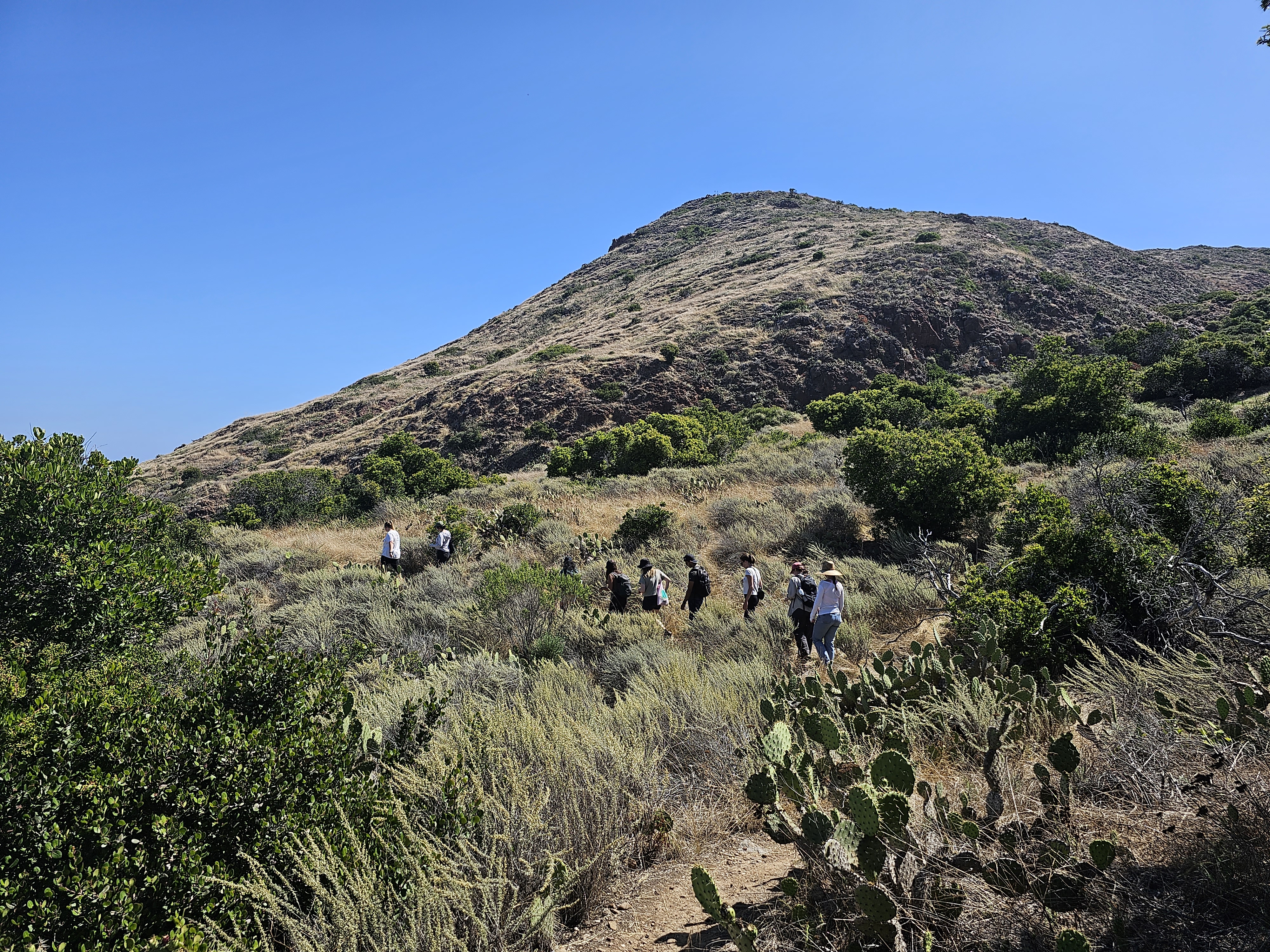
Jen: Can you describe the Green Ravine? Where does it sit on the island? What is the ecosystem? How does it relate to the Wrigley Campus?
Emersyn: The Green Ravine is part of one of the lowermost sections of a watershed, located on the USC Wrigley Institute outside of the dorm style housing. A watershed is an area bound by ridges in the land above where water falls and converges to one point. More generally, the Wrigley Institute is located in Big Fisherman Cove near the town of Two Harbors. The ecosystem on the Island is of a chaparral biome, meaning that it has hot, dry summers with mild, rainy winters, creating an overall arid landscape with many native drought resistant shrubs. At the time of our data collection, the Green Ravine had a mix of both native and invasive plant species.
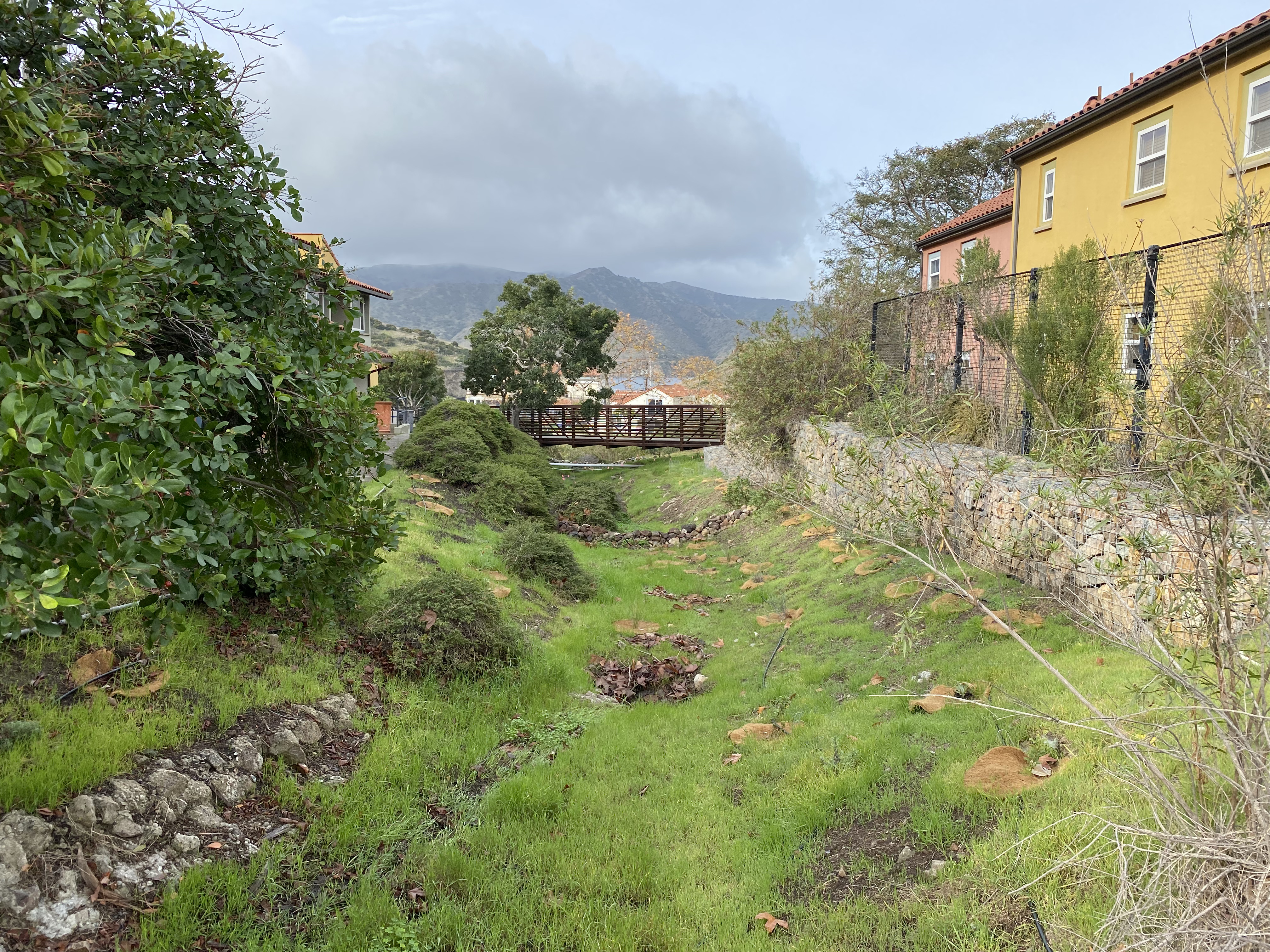
Jen: What were your objectives in taking soil samples?
Alia: When taking soil samples, we had the objective of determining whether or not the soil would support a restoration of native plants, and if there would be anything that would be needed to be done to it in order to support more lush plant life. We wanted to assess the current health of the soil. This would set a baseline for comparison after native plants were put into the area. It would also help us understand the conditions of the surrounding watershed in addition to the green ravine. When we took samples, we had to take them in a mostly random distribution because the area is so rocky, and we had trouble getting our equipment to penetrate the ground in a lot of places.
Jen: Can you describe what did the soil look and feel like?
Emersyn: Depending on where the soil sample was taken, the soil was either dry and crumbly or dry and compacted, making it easy to take some of the samples while a few were quite difficult. Within the samples, there was gravel and small rocks and the soil particles themselves appeared large. Due to the presence of rocks and/or plants throughout the test plot, the samples were taken in a mainly random pattern wherever it was feasible. When breaking up the soil with a mortar and pestle to be able to sift it, many of the particles were tightly bound in small clumps.
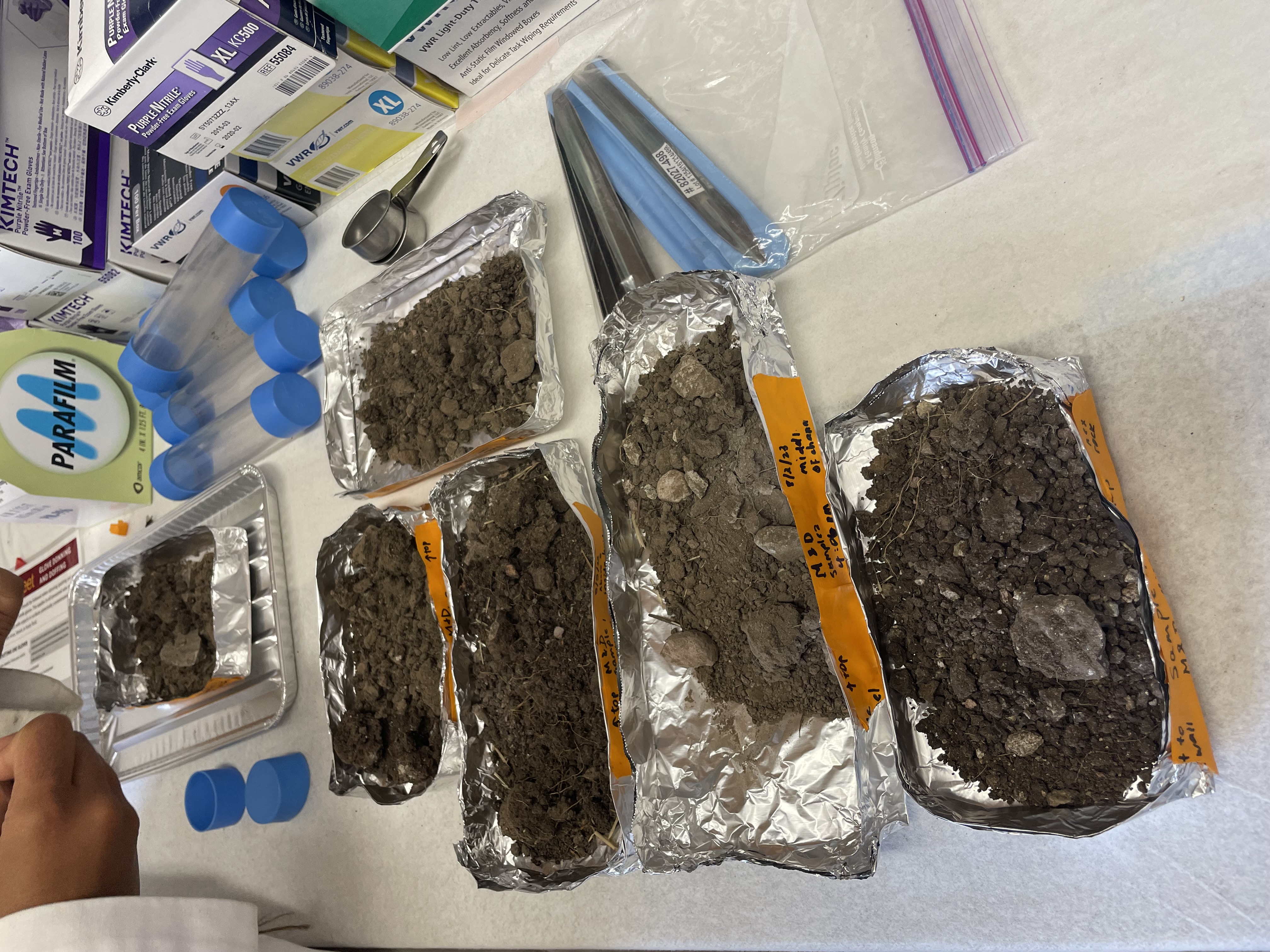
Jen: What soil properties did you examine? Why is each one important?
Alia: The soil properties we examined were soil composition, soil texture, nutrient content and pH, bulk density, porosity and water content, respiration, and conductivity.
-
Soil composition tells us how much of the soil is solution, how much is air, how much is organic matter, and how much is minerals. This lets us know how well the soil can hold and provide nutrients for plants.
-
Soil texture is basically a measure of the composition of the mineral portion of the sand, so it reveals the content of sand, silt, and clay in the mineral part of the soil. This measurement gives us insight into how well the soil will hold water.
-
Nutrient content and pH are two characteristics of soil that are very important when discussing plant growth because plants need a balanced pH as well as a certain level of nutrients present in the soil to be able to thrive. Bulk density, porosity, and water content are all aspects of soil compaction and moisture, so they may affect the root growth of plants and how far into the soil those roots are able to reach.
-
Soil respiration is measured by the amount of oxygen released from soil over a given time period. This measurement is used as an indicator of microbial activity, so it can give us an indication of whether or not there are a lot of microorganisms at work in the soil.
-
Lastly, we measured the electrical conductivity of the soil. This is important because the thing that helps soil be a good conductor is salt content, so conductivity tells us if the soil has a high salt content that could be damaging to plants.
Jen: Is there any special equipment you need to perform these tests? Are there any of these tests that people can do at home?
Emersyn: Many of the tests we conducted can be done at home with some simple tools. To collect soil samples, we used soil core samplers to collect a precise amount of soil and to maintain the condition of the soil; however, a soil sampler probe could be used to collect samples as well. Testing for pH, nitrogen, phosphorus, and potassium are the easiest tests to do at home using a Rapitest soil test kit. To weigh the samples in bulk density, porosity, and water content measurements, a scale is needed as well as an oven. To measure soil texture, a sift, mortar and pestle, graduated cylinder, water, sodium hexametaphosphate, thermometer, timer, and hydrometer are needed. Other helpful tools include a hand shovel, a pen and tape for labeling, and tin foil. Tests for organic matter would require an oven that can reach 450℃, respiration tests would require a CO2 indicator, and salinity tests would require a soil EC meter, therefore these tests would be difficult to conduct at home.
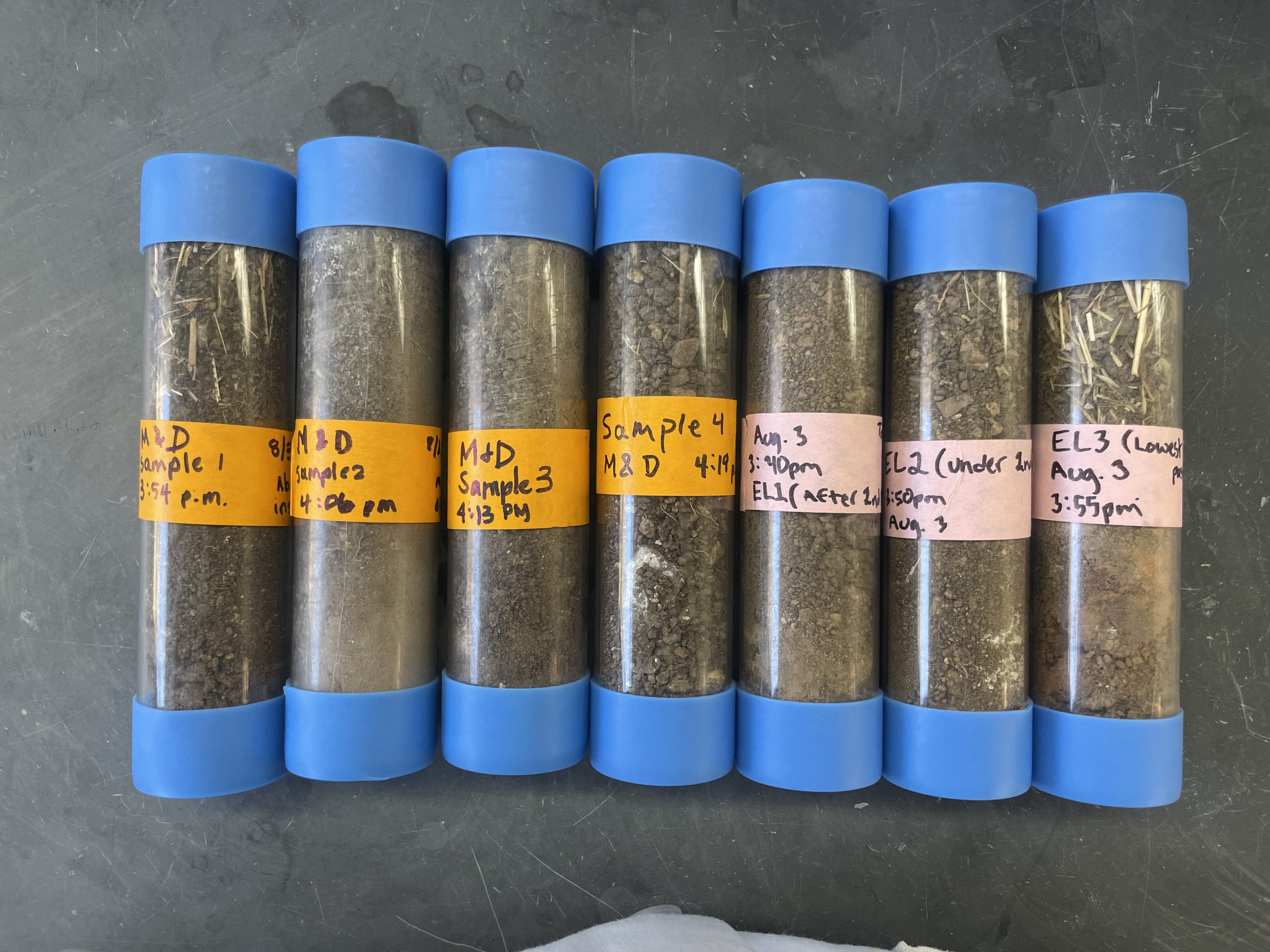
Jen: How would you describe the soils in the Green Ravine?
Alia: The soil in the green ravine is very porous, it’s dry, and it has a low nutrient content. The main aspect of this soil that makes it unique is the fact that it is almost entirely newly settled sediment, so it is very loose soil. It falls in the bottom of a channel through which water that is often carrying a lot of sediment flows, which describes its low compaction. Its low water content and lack of nutrients may sound concerning, but they are not actually a bad thing. This is typical of this biome which means that the soil in the green ravine is very normal for a chaparral biome in all of its other aspects. It has coarse grain size because it is considered a sandy loam based on our soil texture data, which basically means that it has a lot of sand and a lot of silt, and not very much of it is clay which is the smallest soil particle. Overall, the green ravine soil looks like a loose, less compact version of healthy chaparral biome soil.
Jen: What were the results and takeaways?
Emersyn: The breakdown of soil components was 45.47% air, 42.54% mineral, 8.24% solution, and 3.75% organic matter.
-
The soil’s texture was overall a sandy loam composed of 65% sand, 18% silt, and 16% clay. This composition allows for good drainage of water, which is beneficial for the Green Ravine where one of the goals is to allow the water to infiltrate and percolate through the soil.
-
The average bulk density was 1.0742g/cm^3, and while this was low, it still indicates overall good soil health.
-
The average pH was 6.8, which falls within the ideal pH range for many native plants in the area. The soil was depleted in nitrogen, phosphorus, and potassium indicating a low cation exchange capacity, which is normal and expected for the environment as the tests used are designed for agricultural fields where levels are anticipated to be higher.
-
All the soil samples had a high concentration of CO2 possibly due to the Birch Effect, where the sudden addition of water to dry soil with typically limited water levels, causes a short-term spike of CO2 output with higher microbial respiration and activity levels.
-
Finally, the soil was non-saline. The conductivity of the soil was 0.17dS/m, while the USDA defines saline soil as being higher than 1dS/m.
Taking all our measurements into consideration, a few takeaways could be made. Firstly, as Alia mentioned, the soil is typical of its biome. The arid landscape of a chaparral biome creates soils that have high porosity, are nutrient-poor, dry, and have a coarse grain size, all of which were observed in our soil samples. So while these conditions aren’t necessarily ideal for agricultural production, we concluded that native plants will likely do well as they have been well adapted to thrive in this type of soil. This was great news because it meant that the Test Plot was suitable for the restoration that would be taking place in the following months. Secondly, there weren’t any large differences between the soils taken before and after the two check dams in the Green Ravine, which was likely due to our distribution and random choice in sample location. To properly assess how well the check dams work, more samples right before and after each should be taken in the future. Lastly, the lower bulk density of the soil had to do in part because most of our soil samples were taken within the part of the Green Ravine where the water stream was flowing, therefore there was less organic matter and plant growth in that area. Additionally, with a large amount of rain from this past winter, sediment from upstream had recently been displaced and loosely consolidated in that part of the ravine as well, making it less compact than soil in a field would be.

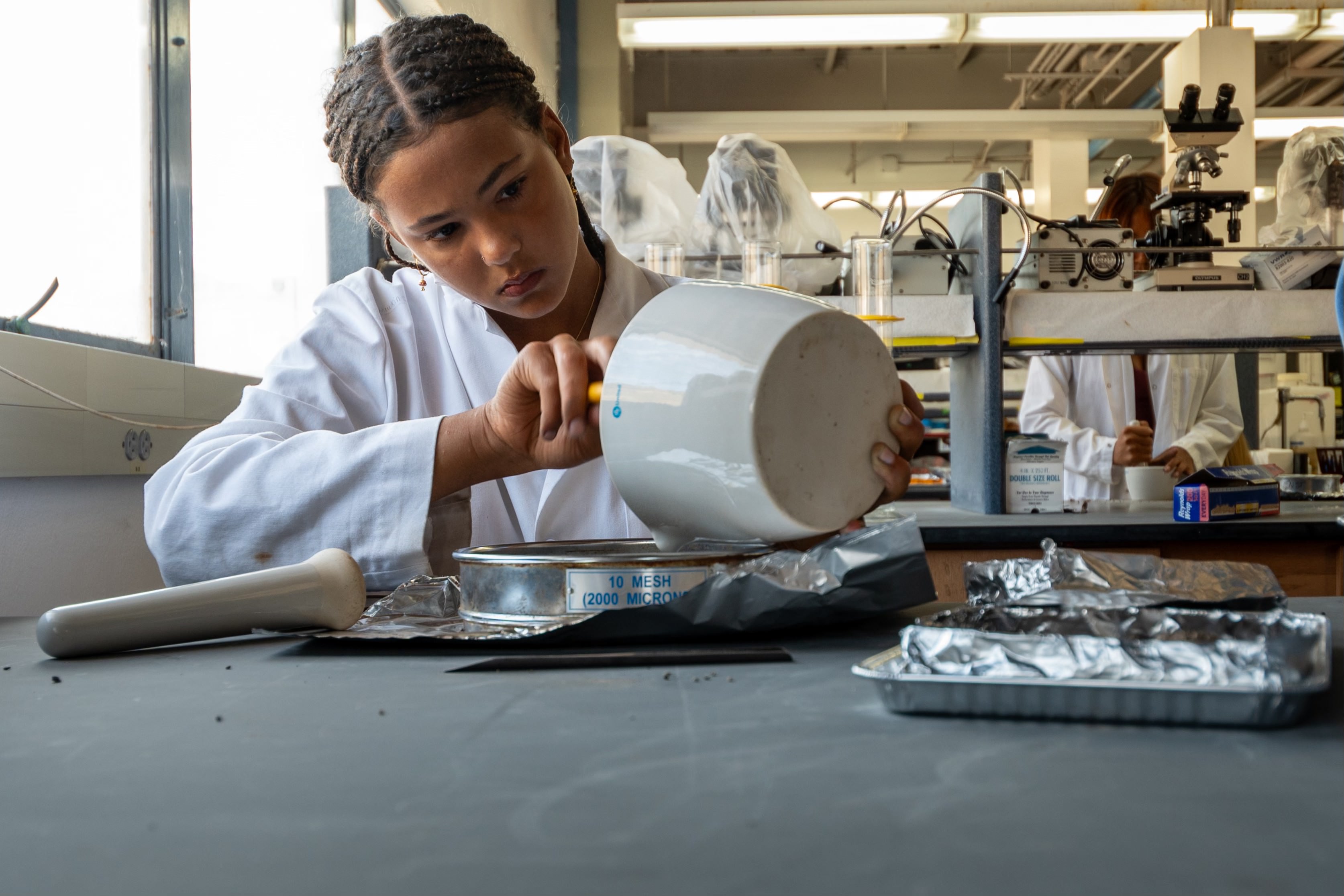
SUMMER FIELD SKETCHES
Debs Test Plot
By Hannah Pae
Debs Volunteer, Terremoto designer
DATE: July 10 2023
The atypical amount of rain this spring has resulted in some exciting lush growth as the soil underfoot gladly absorbs the extra moisture. The cool and dusky scent of CA sagebrush surrounds us as we pull milk snails off the stems and leaves of purple lupines that pop up amongst the salvias. On other days, we carefully free sprawling coyote brush and monkeyflower that have happily outgrown their protective gopher baskets. A desert centipede wriggles itself deep into bark mulch while wild cucumber drops its spiky lime green fruit and winds its tendrils through a bank of deep green toyon. The peaks of the San Gabriel Mountains are laden with snow in March when the Encelia flanking the trail up to the test plot starts to let out the first of its yellow flowers. By July, the snow has melted and the Encelia is in full ecstatic bloom.
The following is a series of field observations, memories, and moments collected from the past few months while volunteering at Debs Test Plot.
Debs Test Plot
By Hannah Pae
Debs Volunteer, Terremoto designer
DATE: July 10 2023
The atypical amount of rain this spring has resulted in some exciting lush growth as the soil underfoot gladly absorbs the extra moisture. The cool and dusky scent of CA sagebrush surrounds us as we pull milk snails off the stems and leaves of purple lupines that pop up amongst the salvias. On other days, we carefully free sprawling coyote brush and monkeyflower that have happily outgrown their protective gopher baskets. A desert centipede wriggles itself deep into bark mulch while wild cucumber drops its spiky lime green fruit and winds its tendrils through a bank of deep green toyon. The peaks of the San Gabriel Mountains are laden with snow in March when the Encelia flanking the trail up to the test plot starts to let out the first of its yellow flowers. By July, the snow has melted and the Encelia is in full ecstatic bloom.
The following is a series of field observations, memories, and moments collected from the past few months while volunteering at Debs Test Plot.



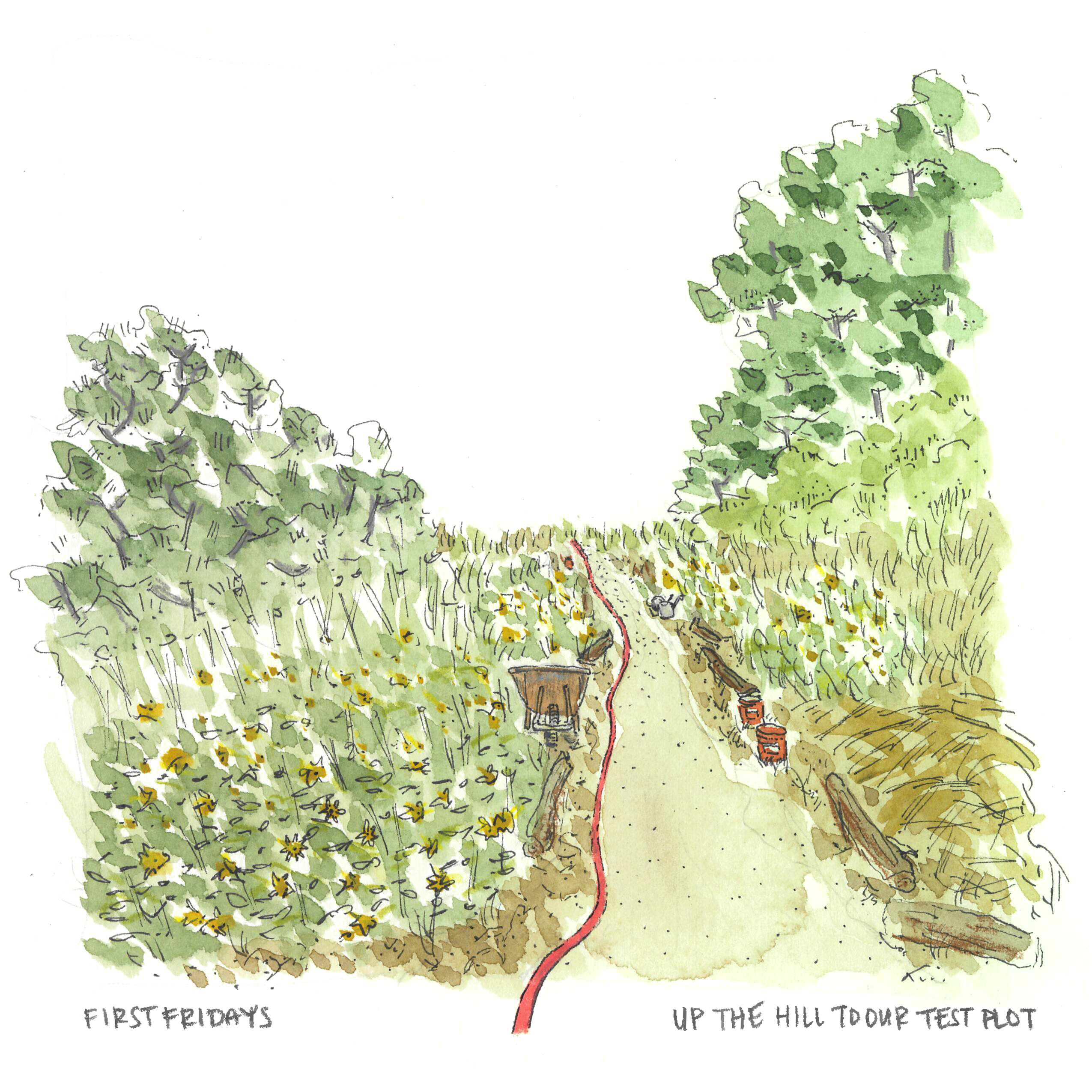

FIELD DRAWINGS
San Bruno Mountain
DATE: Fall 2022
Exploring the native and introduced species in and around San Bruno Mountain in Daly City, CA such as Blue Green Eucalyptus, Bay Laurel, Monterey Cypress, Toyon and Monterey Pine.
San Bruno Mountain
By Tera Johnson, Lian Mae Tualla
UC Berkeley Landscape Architecture students
UC Berkeley Landscape Architecture students
DATE: Fall 2022
Exploring the native and introduced species in and around San Bruno Mountain in Daly City, CA such as Blue Green Eucalyptus, Bay Laurel, Monterey Cypress, Toyon and Monterey Pine.


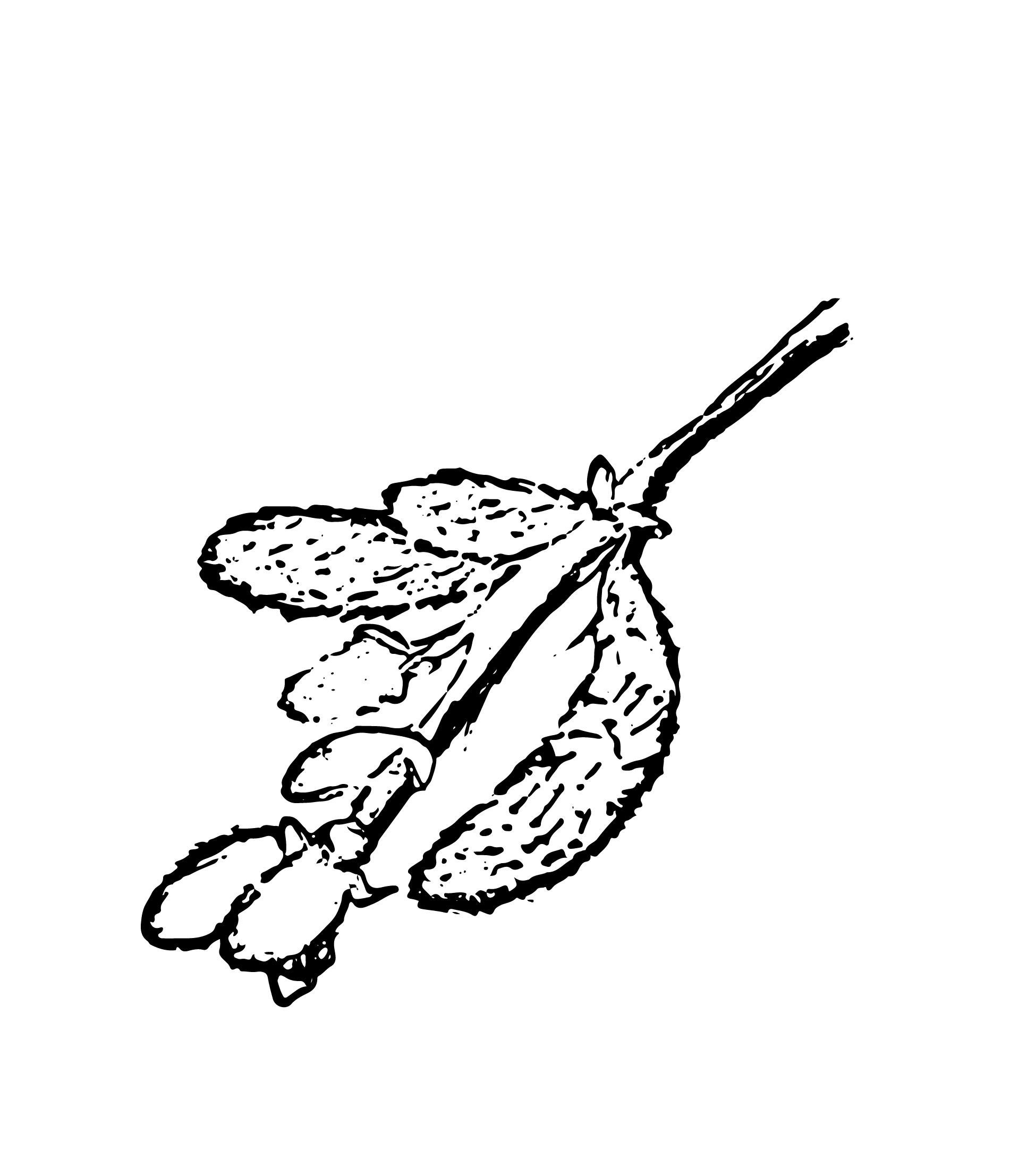
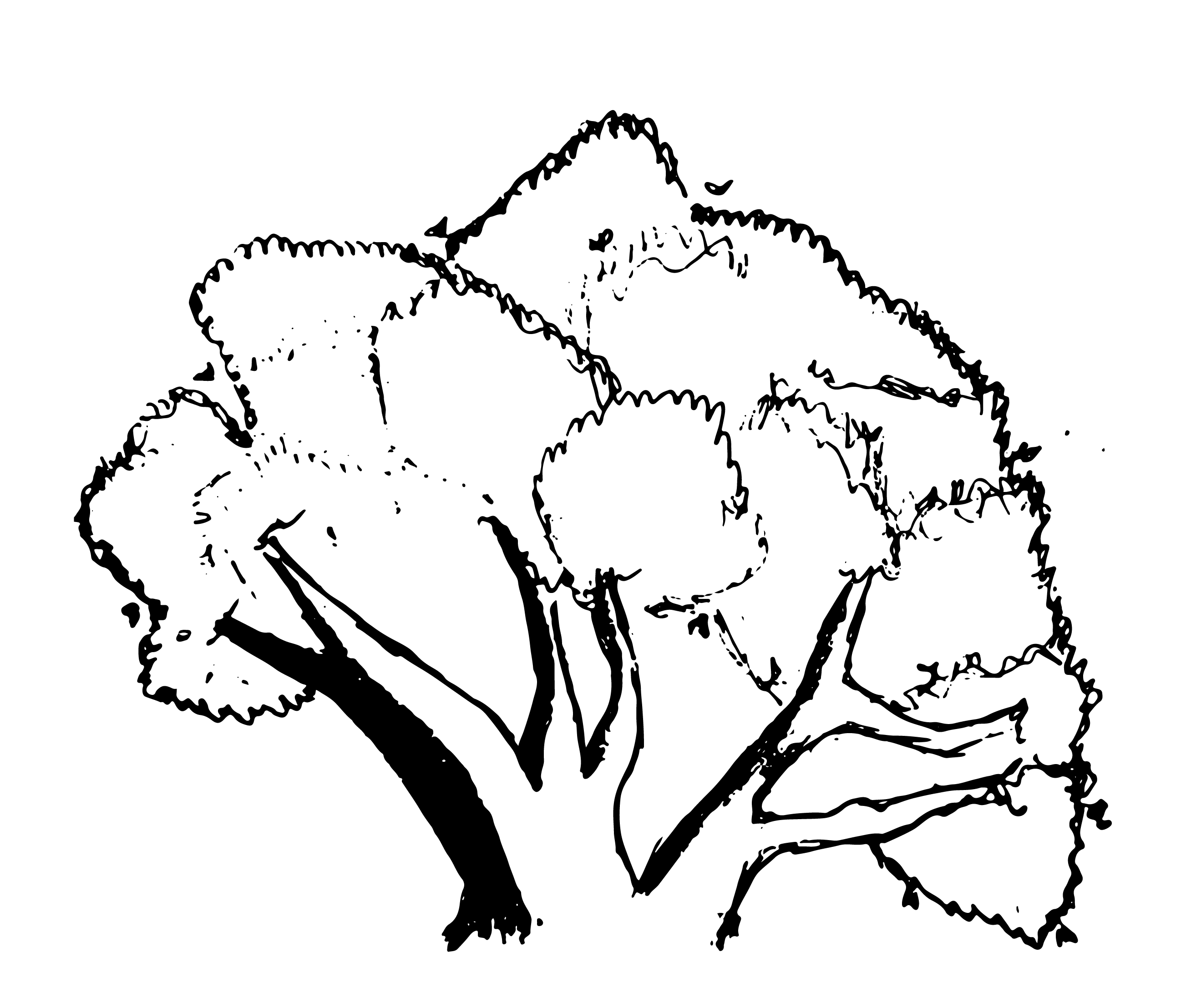



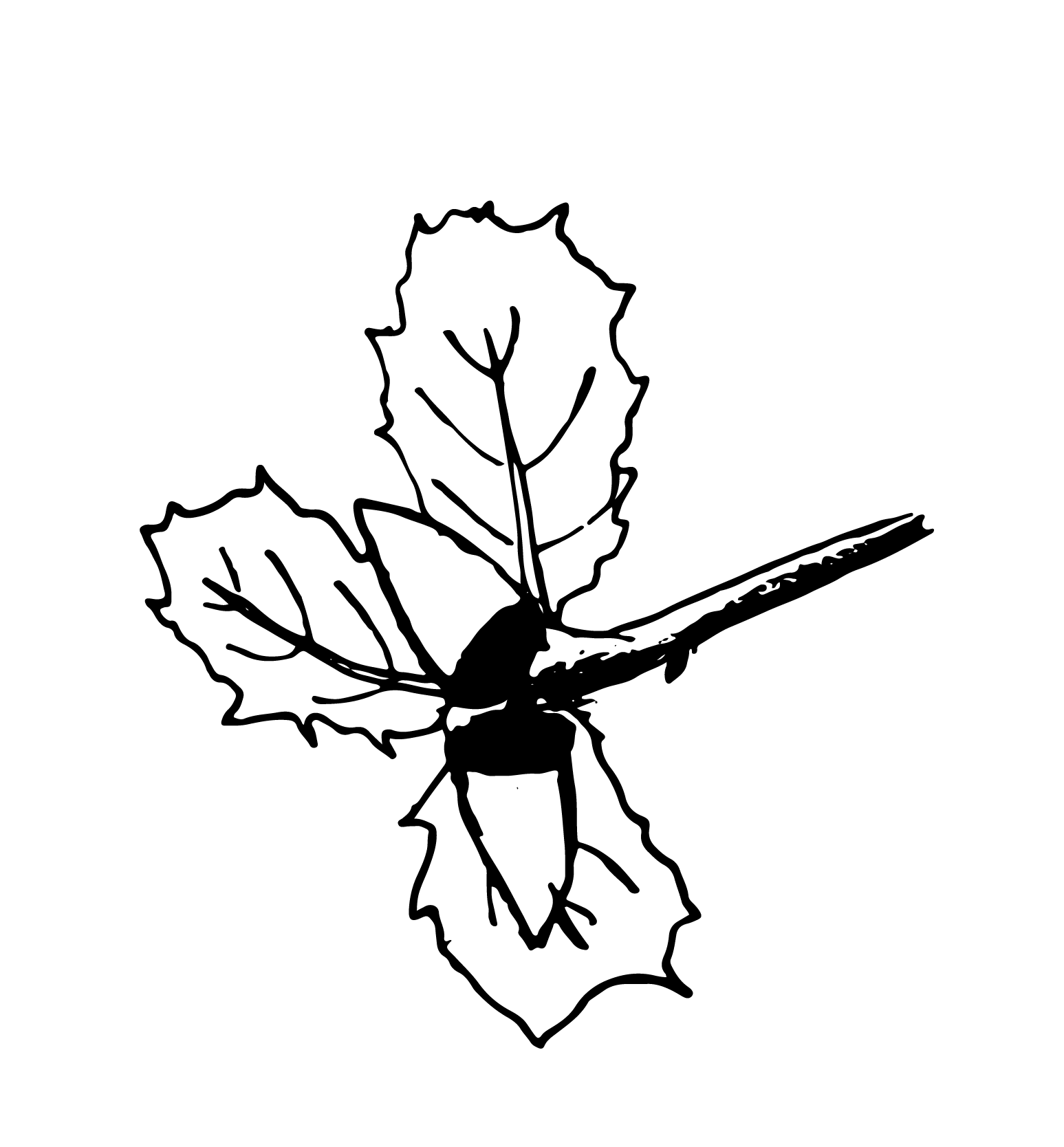

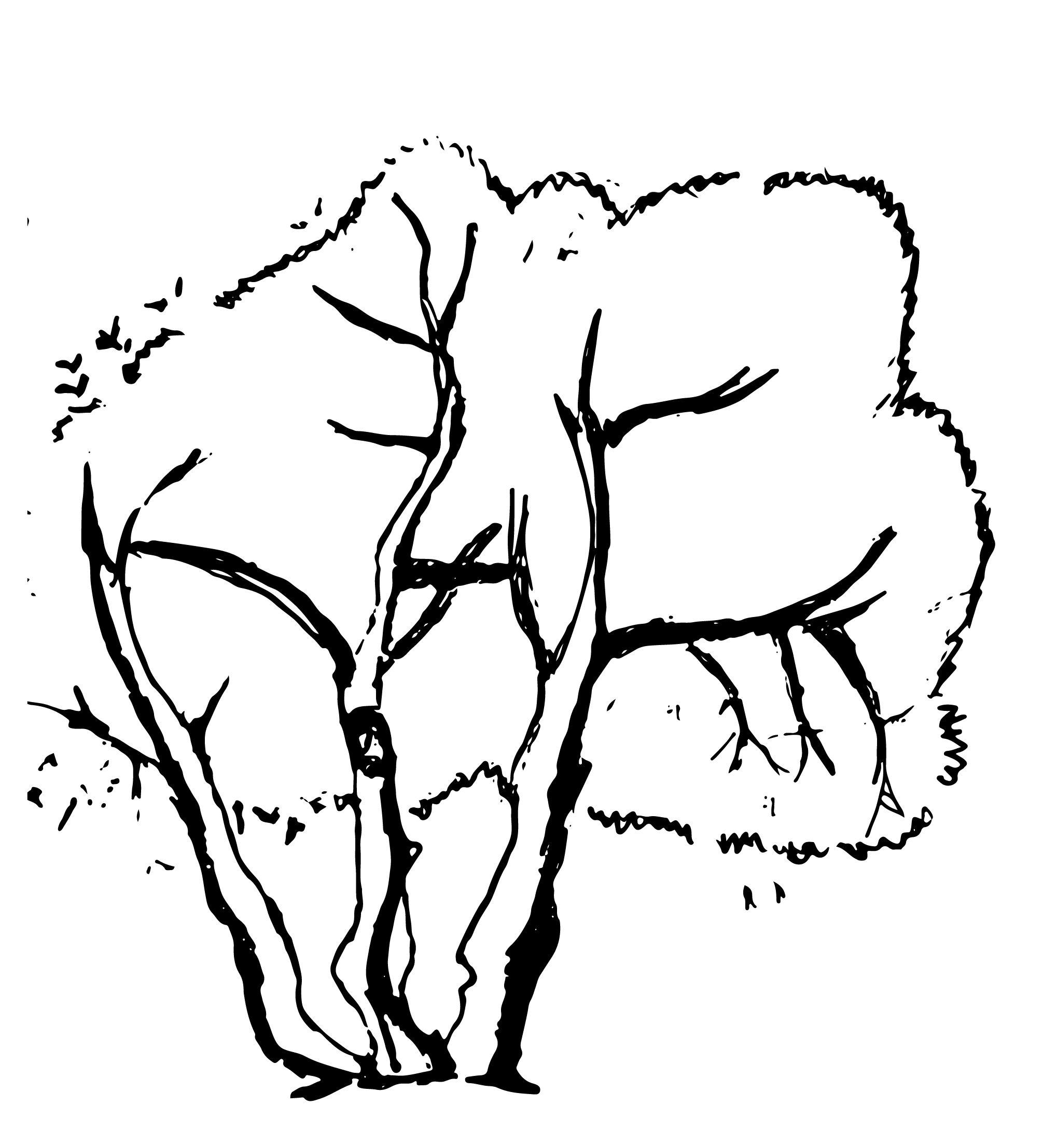
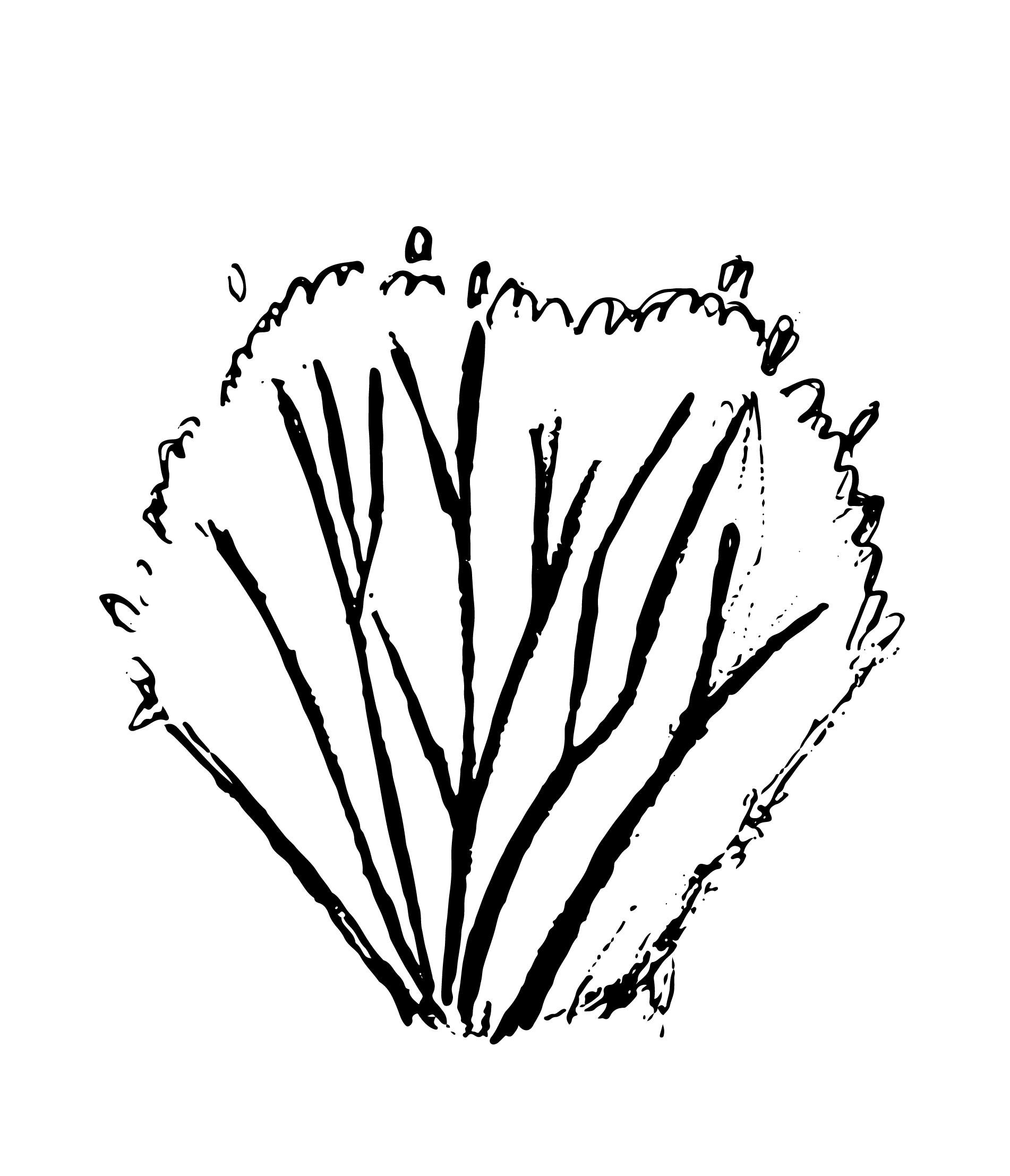
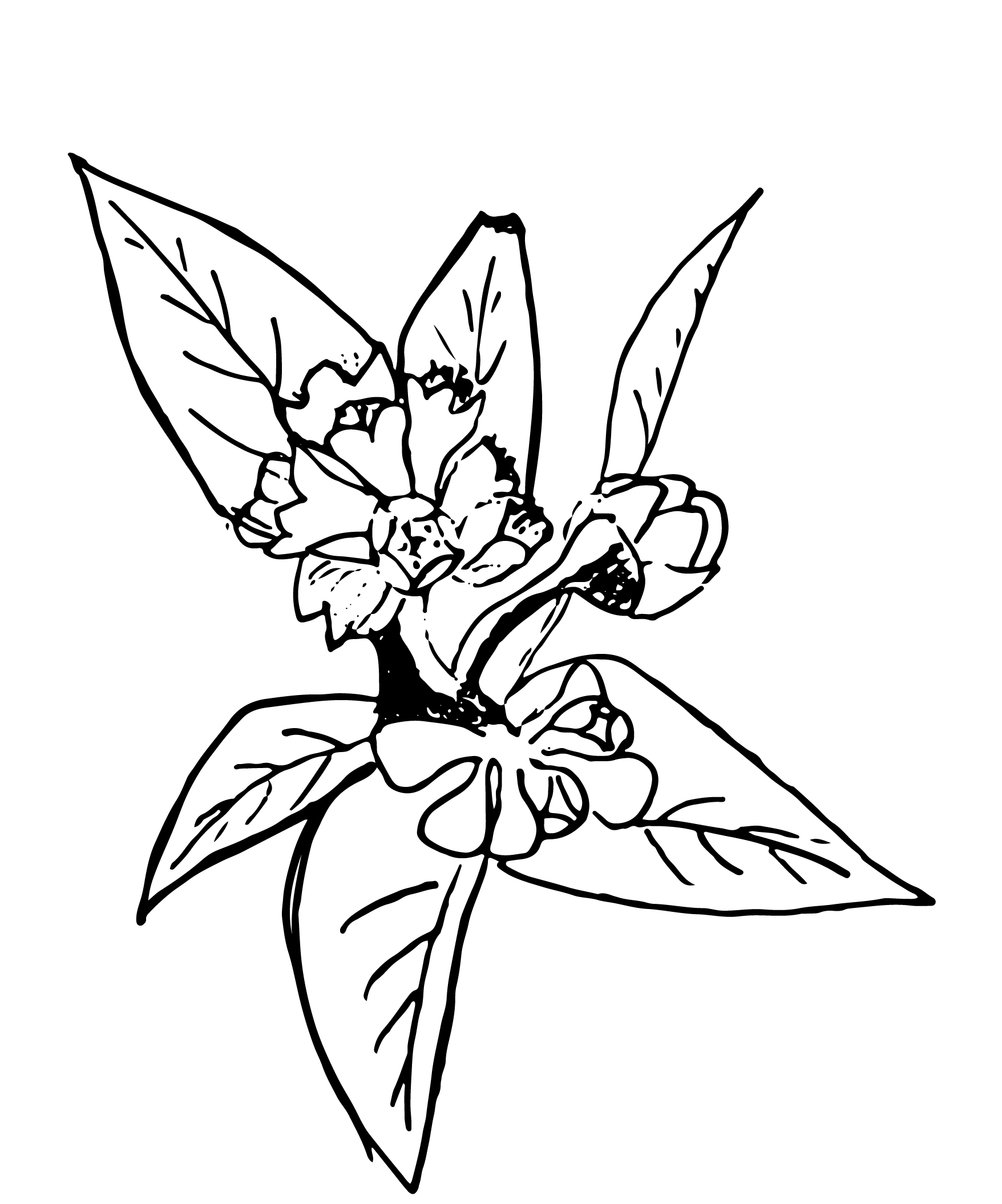
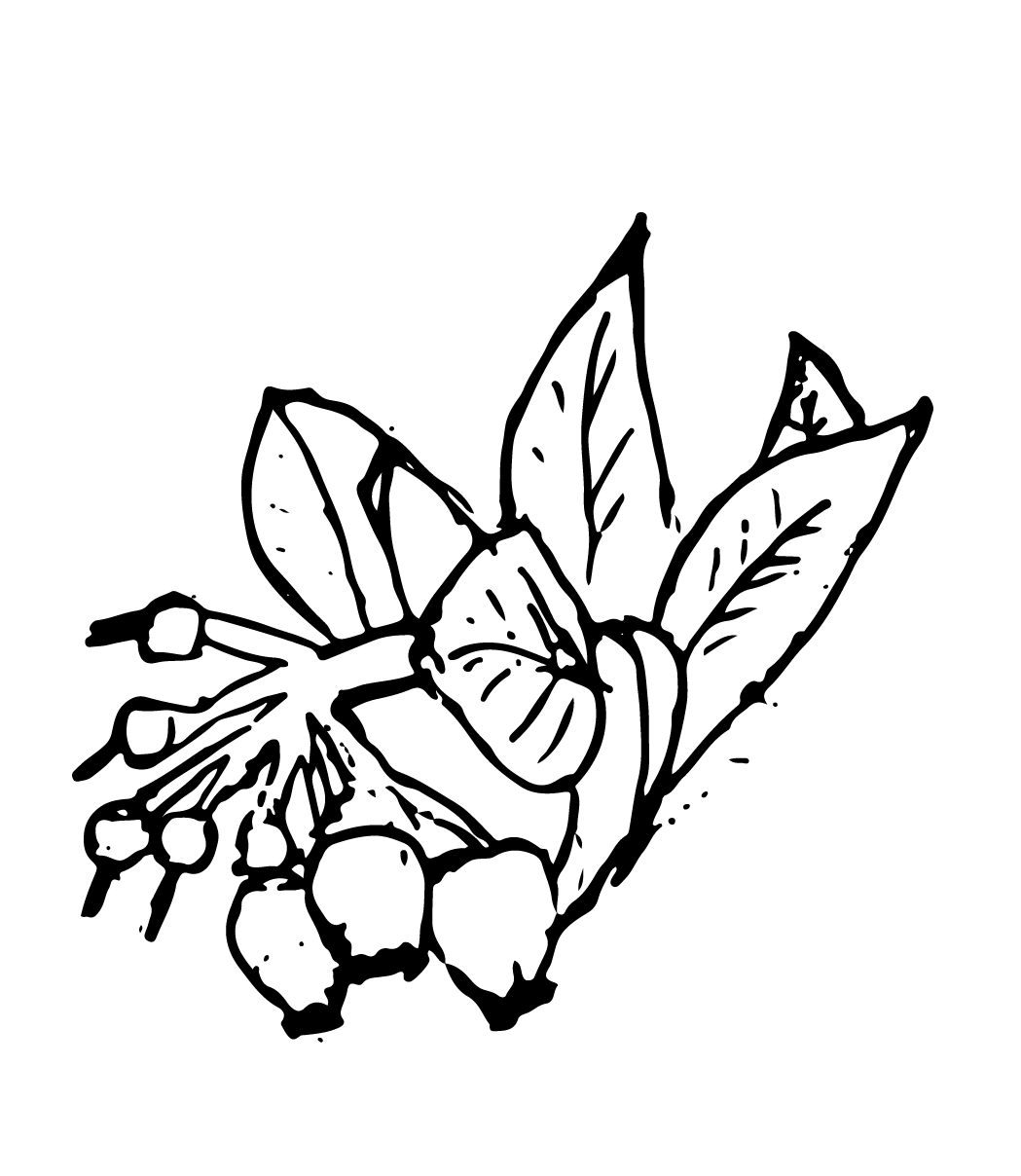







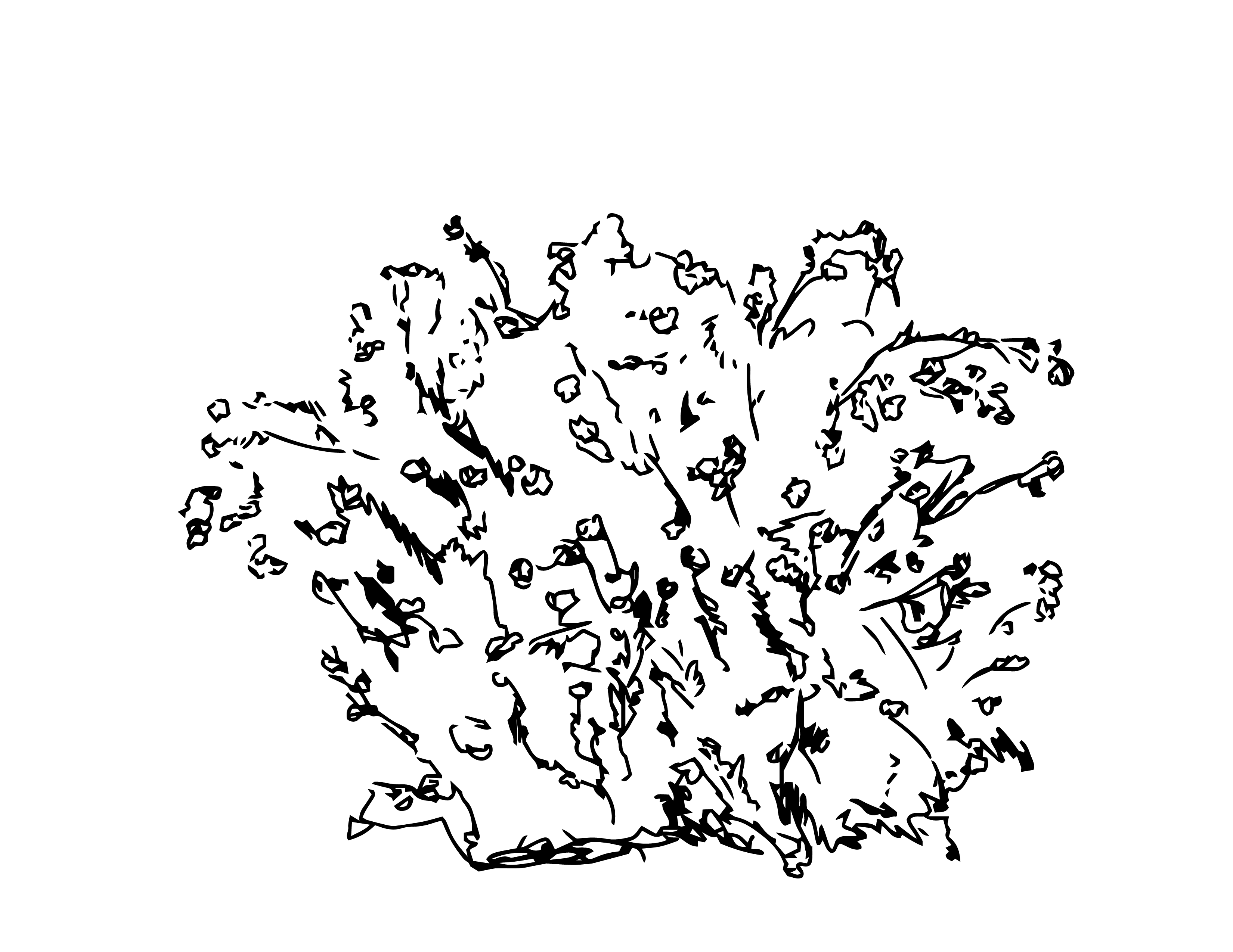

FIELD NOTES
Rio Update
Rio Update
By Daniela Velazco
Test Plot Intern
Test Plot Intern
DATE: October 22 2022
Nina and I met up at the Test Plots to monitor the existing species and create labels for plants when necessary. We met at 10am on a Sunday. The log borders are working well as a way to differeniate the plots from the path. It seems that the most successful plots have a thick 3-5” layer of mulch.
While going through and taking note of successful species two park visitors came up to us and told us they were volunteers and a part of the larger recent natives planting at Rio. The area around the test plots had 50-100 new young sprouts that were planted.
One of the volunteers mentioned noticing what seemed like a pest growing on one of the oak tree saplings. She remarked how much she loved the species and knew how long they take to grow, so she wanted to keep an eye on it to give it the best chance possible. We walked over and saw a red beetle and white substance underneath the oak leaves (eggs, fungus, foam?). We took pictures and notified the Parks Coordinator. We then completed our assessment of the plots and infilled metal labels in areas that needed it most. We were at the park for around an hour.
Nina and I met up at the Test Plots to monitor the existing species and create labels for plants when necessary. We met at 10am on a Sunday. The log borders are working well as a way to differeniate the plots from the path. It seems that the most successful plots have a thick 3-5” layer of mulch.
While going through and taking note of successful species two park visitors came up to us and told us they were volunteers and a part of the larger recent natives planting at Rio. The area around the test plots had 50-100 new young sprouts that were planted.
One of the volunteers mentioned noticing what seemed like a pest growing on one of the oak tree saplings. She remarked how much she loved the species and knew how long they take to grow, so she wanted to keep an eye on it to give it the best chance possible. We walked over and saw a red beetle and white substance underneath the oak leaves (eggs, fungus, foam?). We took pictures and notified the Parks Coordinator. We then completed our assessment of the plots and infilled metal labels in areas that needed it most. We were at the park for around an hour.
Weather
High of 72, Low of 59 degrees
We received the first sprinkle of rain earlier this month, Prior to that it has not rained since April, which is typical of our summer dry climate.
Tests
The seeded only plots are visibly different from the plots planted with 1-5 gallon plants. Not as variety visible in the fall with the seeded plots. This could be due to the seeded species being mostly annual wildflowers. Check plantlist to vertify hypothesis.
How are the plants doing?
The plants look good, none are visibly in distress. Many of the plants have gone to seed or fruit. California Buckwheat provides a nice color through its seeds to compliment the evergreens in the Fall. After monitoring the test plots for two years we’ve noticed certain species are thriving
Successful species:
Future Activities
Note spontaneous growth in the Spring. Many of the species have grown for 2 years, infill planting to fill in the gaps as next steps
High of 72, Low of 59 degrees
We received the first sprinkle of rain earlier this month, Prior to that it has not rained since April, which is typical of our summer dry climate.
Tests
The seeded only plots are visibly different from the plots planted with 1-5 gallon plants. Not as variety visible in the fall with the seeded plots. This could be due to the seeded species being mostly annual wildflowers. Check plantlist to vertify hypothesis.
How are the plants doing?
The plants look good, none are visibly in distress. Many of the plants have gone to seed or fruit. California Buckwheat provides a nice color through its seeds to compliment the evergreens in the Fall. After monitoring the test plots for two years we’ve noticed certain species are thriving
Successful species:
- Eriogonum fasciculatum - California Buckwheat
- Isocoma menziesii - Menzies' Goldenbush
- Baccharis pilularis - Coyotebrush
- Asclepias fascicularis - Narrowleaf milkweed
- Muhlenbergia rigens - Deergrass
- Sphaeralcea ambigua var. Rugosa - Apricot Mallow
Future Activities
Note spontaneous growth in the Spring. Many of the species have grown for 2 years, infill planting to fill in the gaps as next steps
- Mulch beds with depleted mulch layer. 3-5” thick layer of wood chip mulch is optimal.
- Replace labels and provide labels for all plants
- (Tongva, English, Botanical names)
- Can this be done before the Oct 17th?
- Update “What is Planted Here” laminated sheets
- Make this signage more visible
- Increase vegetation density
- Increase variety of species
- Struggling species
- Penstemon spectabilis (Showy Penstemon)
ELYSIAN AFTER 3 YEARS
The Elysian plots were first planted in the Winter of 2019. After three years, we wanted to share some reflections on how they are doing and what we have leanred.
Q: Will people show up?
Yes. Young professionals sign up and self organize via a google sheet to water weekly. Plus we’ve hosted semi-monthly “plant church” community events.
Q: What are your key lessons learned so far?
What questions are you thinking about moving forward?
Q&A with Jenny Jones
Test Plot Co-Founder, Partner at Terremoto
Test Plot Co-Founder, Partner at Terremoto
Oct 13 2022
The Elysian plots were first planted in the Winter of 2019. After three years, we wanted to share some reflections on how they are doing and what we have leanred.
Q: Will people show up?
Yes. Young professionals sign up and self organize via a google sheet to water weekly. Plus we’ve hosted semi-monthly “plant church” community events.
Q: What are the minimum inputs to establish a native ecosystem?
- We planted over 600 plants with 50% survival rate.
Only caveat on this stat is that we don't actually need ALL the plants to survive. The Micro Forest idea.
-
Fencing, gopher cages, signage, signs of care, and programs help.
-
Success in location. A lot of people see the test plots during their routine daily use of the park and reach out to volunteer as a result of this visibility
-
Initial mulching and adding new mulch year to year, plus chop and drop from in-situ pruning.
-
Planted while mounding berms for new planting to stabilize
- Enhanced watering basins for more efficient watering, seems to be working well.
Q: What are your key lessons learned so far?
- Method of watering has been adapted to the age and success of the plots. Watering with round diameter sprinkler at first, as plants age water changes to direct contact hose watering. Volunteers seem to prefer this method
- Dialing in the planting palette has taken years. We’ve monitored gopher activity and its relation to certain species and replanted those plants that were gopher resistant during the second/third years. The plant palette was quite broad and has narrowed over time to reflect what are the most successful species
- Seed plot was a mild success. Annuals did well, very few perennials or shrubs grew from seed and survived.
- Influence from neighboring trees (pine and eucalyptus) has played a role in the health of the plots
- Consistency of volunteer base has a lot to do with keeping up with community volunteer events. Sense of collaboration with others has been important.
- Some plants that were thriving in years 1-2 are now declining (Satureja). Shade plot looked amazing first 2 years, now has seen a little decline. Could be Pine Tree’s influence?
What questions are you thinking about moving forward?
- How to maintain a consistent and diffuse volunteer base so that the task of watering every weekend doesn’t get left to a handful of ultra-dedicated volunteers?
- Method of establishing new test plots while accounting for water restrictions and changing climate?

RIO AFTER 2 YEARS
DATE: October 06 2022
The Rio plots were planted in the Fall of 2020. A class of landscape architecture students partnered with CA State Parks and a local group the Abuelas de Rio. After two years, we wanted to share some reflections on how they are doing and what we have learned.
Q&A with Jen Toy
Test Plot Lead, USC Lecturer
Test Plot Lead, USC Lecturer
DATE: October 06 2022
The Rio plots were planted in the Fall of 2020. A class of landscape architecture students partnered with CA State Parks and a local group the Abuelas de Rio. After two years, we wanted to share some reflections on how they are doing and what we have learned.
Q: Can we replicate Test Plots in other places?
Yes! our 2nd location at Rio has been very successful. It’s been a completely different process, site and community than at Elysian, so that is very exciting and we’ve learned a ton. For example, the site prep needed to change because Rio is urban fill as a former railyard (as opposed to the naturalized areas of Elysian). The Grow/kill strategy to flush out the weeds was not very successful at Rio b/c the ground was so compacted. We ended up removing bermuda grass, thistle, etc with pickaxes.
Q: What are your key lessons learned so far?
What challenges have you faced?
Yes! our 2nd location at Rio has been very successful. It’s been a completely different process, site and community than at Elysian, so that is very exciting and we’ve learned a ton. For example, the site prep needed to change because Rio is urban fill as a former railyard (as opposed to the naturalized areas of Elysian). The Grow/kill strategy to flush out the weeds was not very successful at Rio b/c the ground was so compacted. We ended up removing bermuda grass, thistle, etc with pickaxes.
Q: How did you adapt for different community needs?
- At Rio we work with a group of elderly Spanish speaking abuelas - with no email or social media. They come to the park in the morning for a walk and some gardening. It was difficult during the pandemic, but we’ve started to create a weekly time to meet on Monday mornings that is organized by Luis Rincon, a community engagement coordinator who works for CA State Parks.
-
This site is also much sunnier and exposed and requires meeting earlier in the morning during the summer.
Q: What are your key lessons learned so far?
- Pioneer species taking off (Isocoma menziesii-- Goldenbush, Encelia californica -- CA Bush Sunflower).
- For the seed only plot, in the first year, seedlings of chia, black sage, lupines, buckwheat and annual wildflowers were present - from a mix that Theodore Payne made for us based on the historical riparian ecology. In 2nd year, the seed only plot was composed largely of Buckwheat (Eriogonum fasciculatum).
- Seed/plant combo plots more successful than seed only or plant only.
- Sheet mulch and thick layer of mulch (4-6”) has been effective at suppressing Bermuda grass, but it can still creep in from plot edges
What challenges have you faced?
- We watered almost every week for the 1st year (maybe too much? Huge growth quickly and found scale on some plants like Malosma)
-
Baby oak and walnut trees (not in plots) died b/c not watered / trampled. Need better cues.

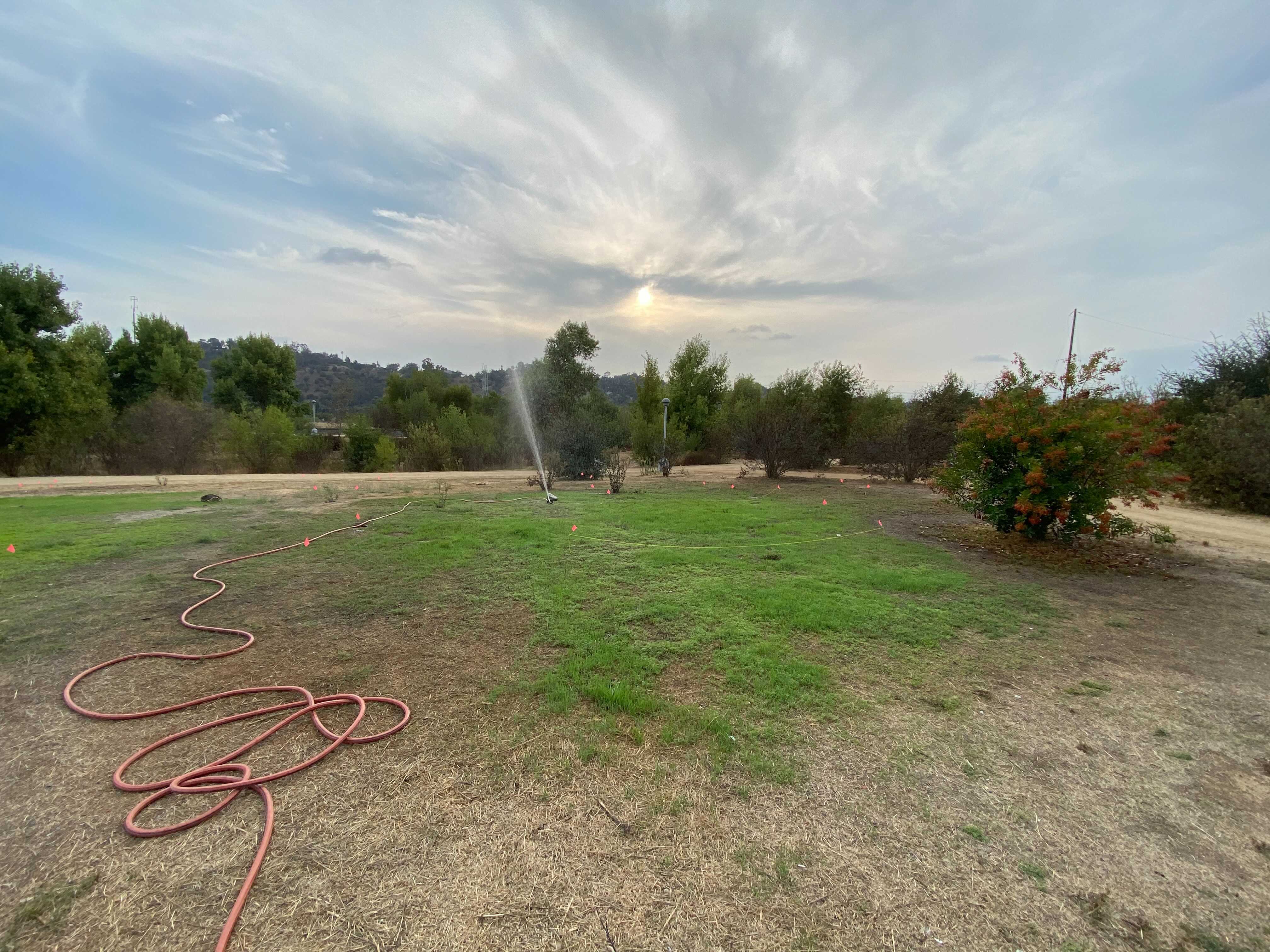
STARTING THE USC CAMPUS PLOTS
DATE: Spring 2022
Q: How do we help a campus transition away from turf?
Q: How do we make native plants and sustainable, water-wise practices, practicable in an institutional setting?
Q: How we make the practice of testing and stewardship part of standard campus / landscape architecture practice?
Still thinking about this one....
![Original condition as unusable turf]()
Questions we’re thinking about
by Alex Robinson
by Alex Robinson
DATE: Spring 2022
Q: How do we help a campus transition away from turf?
- Identify areas of “non-functional turf” as places to start plots.
- Test a palette of plants that are easily found to purchase, are primarily evergreen or semi-deciduous, and can be maintained/trimmed to USC’s aesthetic standards
- Develop a Plant Suitability Framework for choosing other native plant species that have not been tested by the Test Plot team
- Work with facilities to understand needs, opportunities, existing efforts/maintenance regimes, and knowledge gaps
- Expand the existing Test Plot student employee role into 2 internship positions covering maintenance and monitoring
Q: How do we make native plants and sustainable, water-wise practices, practicable in an institutional setting?
- Work with existing Irrigation infrastructure
- Suitable palette for campus use and aesthetics
- Maintenance practices & personnel management
Q: How we make the practice of testing and stewardship part of standard campus / landscape architecture practice?
Still thinking about this one....

THE PLOT WITH THE VIEWS
Starting Baldwin Hills
By Daniela Velazco
Test Plot Intern
DATE: November 2021
The Baldwin Hills Test Plot came together through a collaboration between the Nature Nexus Institute, USC Landscape Architecture graduate students, and local high school students and volunteers.
![]()
![]()
![]() The folks at Nature Nexus Institute have worked hard to take the hills from largely overrun by non-native invasive species to hills of coastal sage scrub habitat patchworked throughout the park. With their help, we turned a 5,000 square foot area near the top of the hill by the Skyline Terrace Amphitheater from a field of mustard into a testing site for speculative climate futures.
The folks at Nature Nexus Institute have worked hard to take the hills from largely overrun by non-native invasive species to hills of coastal sage scrub habitat patchworked throughout the park. With their help, we turned a 5,000 square foot area near the top of the hill by the Skyline Terrace Amphitheater from a field of mustard into a testing site for speculative climate futures.
Below is a breakdown of what was done.
1. Prep the site.
The staff at the Nature Nexus Institute hand pulled wild mustard in early August. They left a few bladderpod plants, black sages, a tobacco tree (home to a resident hummingbird) and a large white sage.
![]()
![]()
![]() 2. MLA graduate students visited the site to prepare for research on the site’s current ecology/ historic ecology and site uses.
2. MLA graduate students visited the site to prepare for research on the site’s current ecology/ historic ecology and site uses.
![]()
![]()
![]()
![]()
![]() 3. In late August we started a grow/kill cycle to stimulate the many years of seeds below ground in the seedbanks. We watered the site weekly and once the plants (mostly black mustard) began to sprout we’d weed and water again.
3. In late August we started a grow/kill cycle to stimulate the many years of seeds below ground in the seedbanks. We watered the site weekly and once the plants (mostly black mustard) began to sprout we’d weed and water again.
![]()
![]()
![]()
![]()
*A note on black mustard: black mustard is an extremely resilient non-native brought to California from Europe. The plant with the huge green leaves with yellow flowers that covers the Los Angeles hillsides in the Spring. It does extremely well in nitrogen areas thriving off the nitrogen from our car exhaust pipes. It grows faster than our native species, choking them out before they’ve had a chance to grow. By removing it and planting natives, we are creating more much needed habitat that local species need to survive. It was also a huge fire hazard!
4. The Test
Climate experts predict a future of more extreme weather events. As we’ve seen this year, this can mean heavier rainfall, storms, and/or longer drought. As a studio class we developed a test based on these predictions using the selected species and planting strategy as variables for the site.![]() We landed on a strategy that takes 3 different California native plant communities and intermixed them on site.
We landed on a strategy that takes 3 different California native plant communities and intermixed them on site.
-Oak woodland based on the historic ecology of the north facing slope
-Coastal sagescrub based on the sites current ecosystem
-Grassland, a plant community that thrives in disturbance
The intent is that the diverse initial planting palette will allow the land to sort out into the appropriate future community makeup.![]()
![]()
![]()
Starting Baldwin Hills
By Daniela Velazco
Test Plot Intern
DATE: November 2021
The Baldwin Hills Test Plot came together through a collaboration between the Nature Nexus Institute, USC Landscape Architecture graduate students, and local high school students and volunteers.


 The folks at Nature Nexus Institute have worked hard to take the hills from largely overrun by non-native invasive species to hills of coastal sage scrub habitat patchworked throughout the park. With their help, we turned a 5,000 square foot area near the top of the hill by the Skyline Terrace Amphitheater from a field of mustard into a testing site for speculative climate futures.
The folks at Nature Nexus Institute have worked hard to take the hills from largely overrun by non-native invasive species to hills of coastal sage scrub habitat patchworked throughout the park. With their help, we turned a 5,000 square foot area near the top of the hill by the Skyline Terrace Amphitheater from a field of mustard into a testing site for speculative climate futures.Below is a breakdown of what was done.
1. Prep the site.
The staff at the Nature Nexus Institute hand pulled wild mustard in early August. They left a few bladderpod plants, black sages, a tobacco tree (home to a resident hummingbird) and a large white sage.



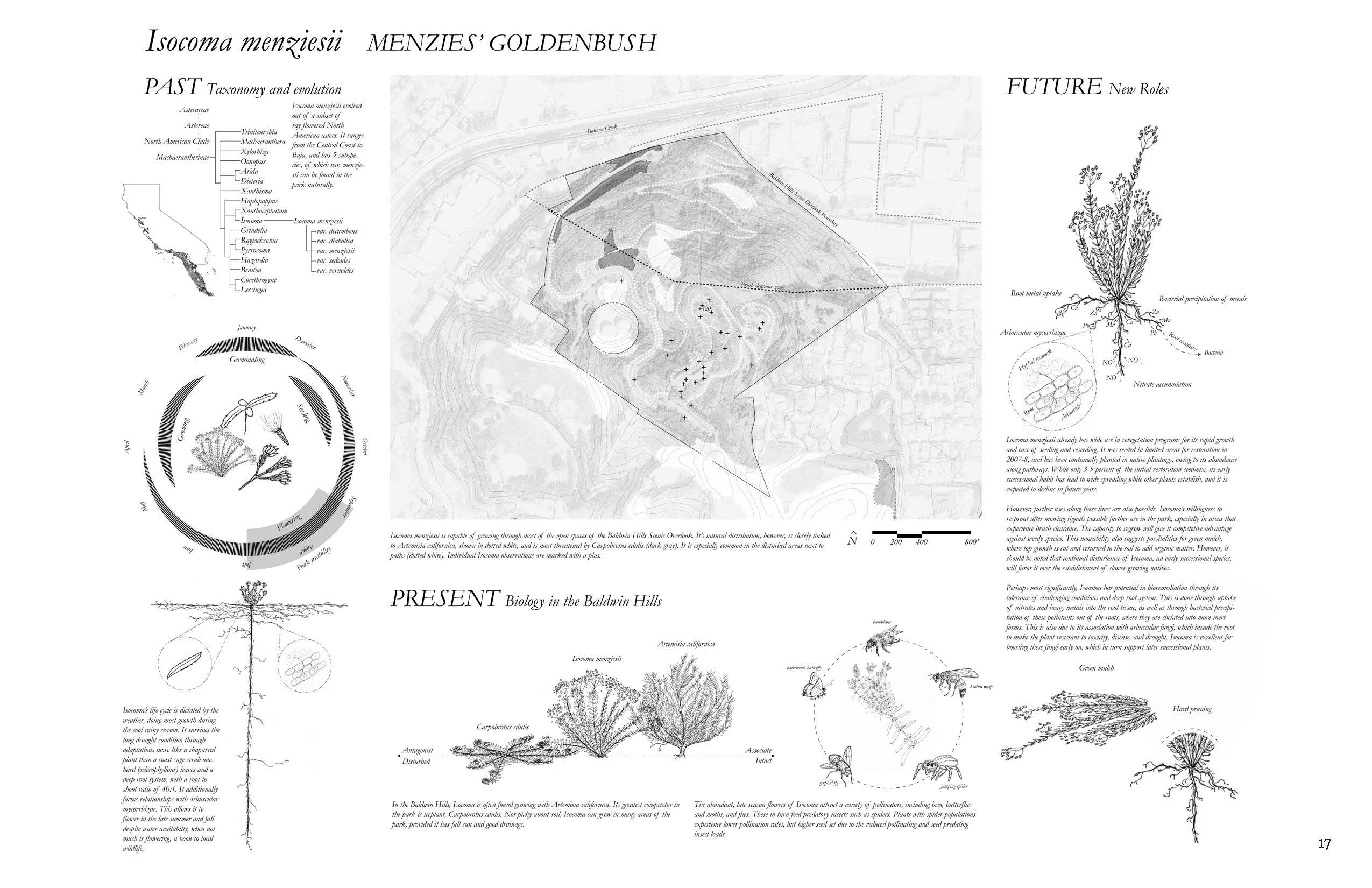
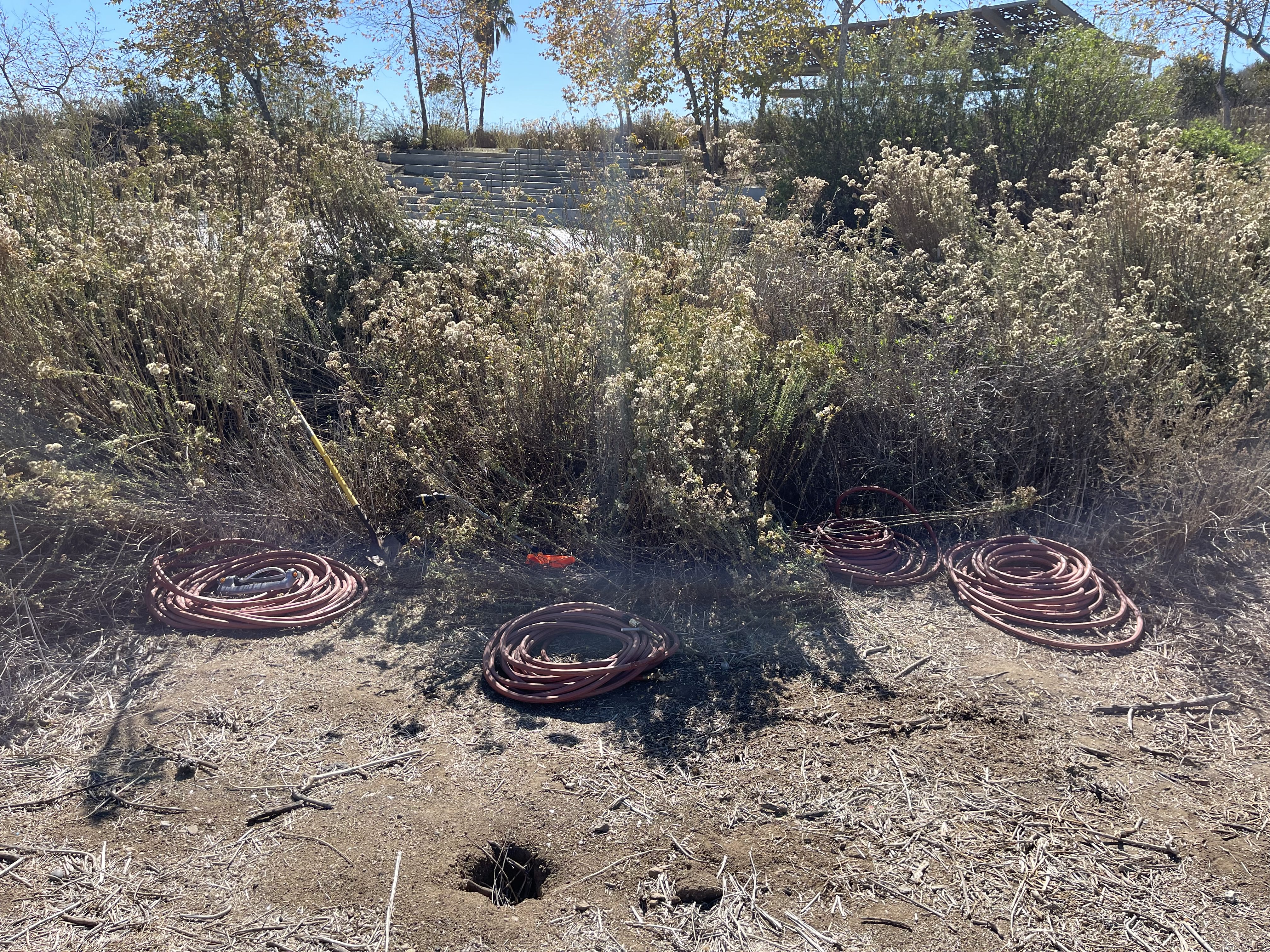

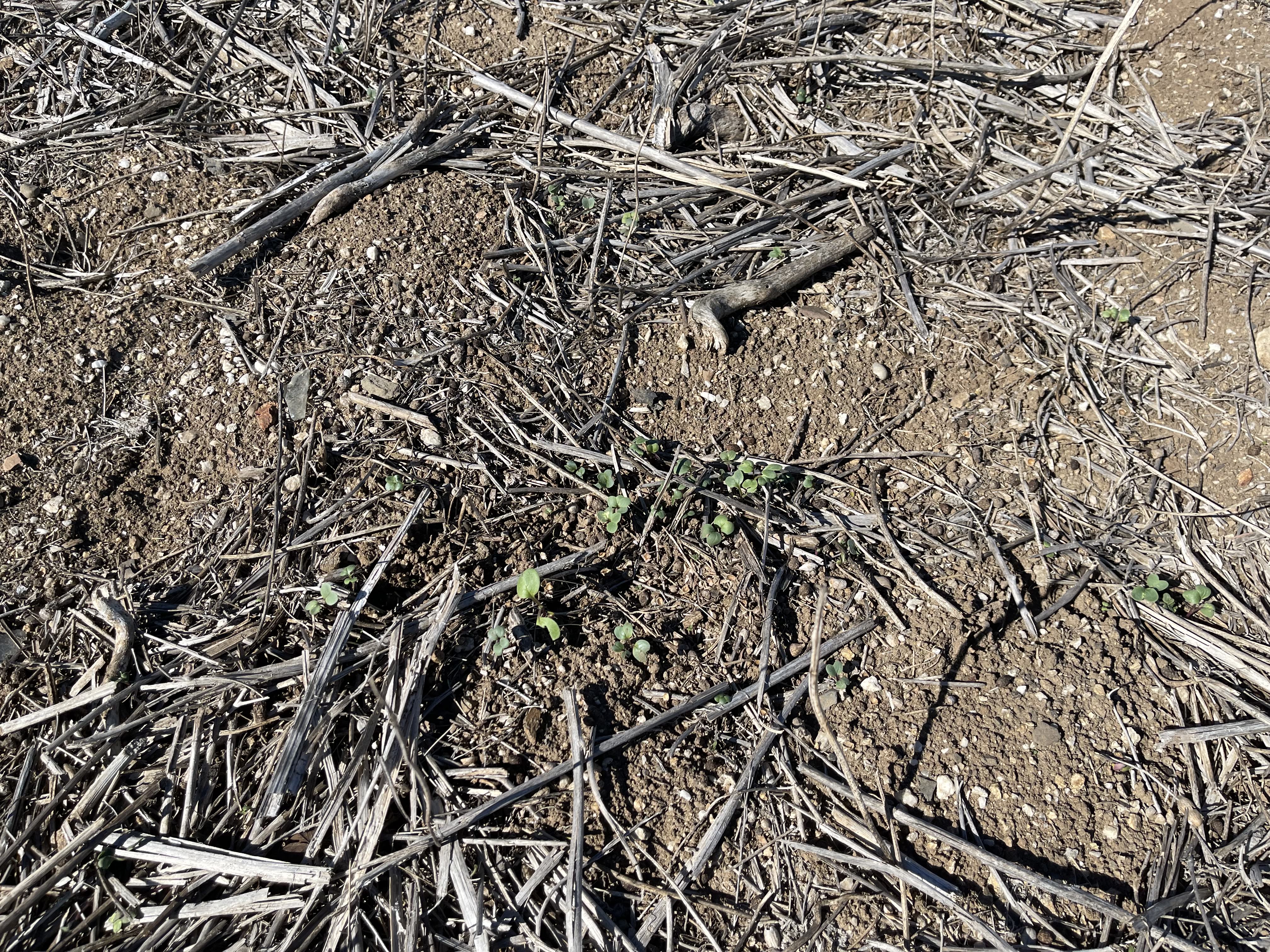

- diagram by Lara Lebeiko
*A note on black mustard: black mustard is an extremely resilient non-native brought to California from Europe. The plant with the huge green leaves with yellow flowers that covers the Los Angeles hillsides in the Spring. It does extremely well in nitrogen areas thriving off the nitrogen from our car exhaust pipes. It grows faster than our native species, choking them out before they’ve had a chance to grow. By removing it and planting natives, we are creating more much needed habitat that local species need to survive. It was also a huge fire hazard!
4. The Test
Climate experts predict a future of more extreme weather events. As we’ve seen this year, this can mean heavier rainfall, storms, and/or longer drought. As a studio class we developed a test based on these predictions using the selected species and planting strategy as variables for the site.
 We landed on a strategy that takes 3 different California native plant communities and intermixed them on site.
We landed on a strategy that takes 3 different California native plant communities and intermixed them on site. -Oak woodland based on the historic ecology of the north facing slope
-Coastal sagescrub based on the sites current ecosystem
-Grassland, a plant community that thrives in disturbance
The intent is that the diverse initial planting palette will allow the land to sort out into the appropriate future community makeup.


TANIA ROMERO,
LOS ANGELES SUPER STEWARD
Rio de los Angeles
By Hannah Flynn & Daniela Velazco
former Test Plot interns
![]()
LOS ANGELES SUPER STEWARD
Rio de los Angeles
By Hannah Flynn & Daniela Velazco
former Test Plot interns
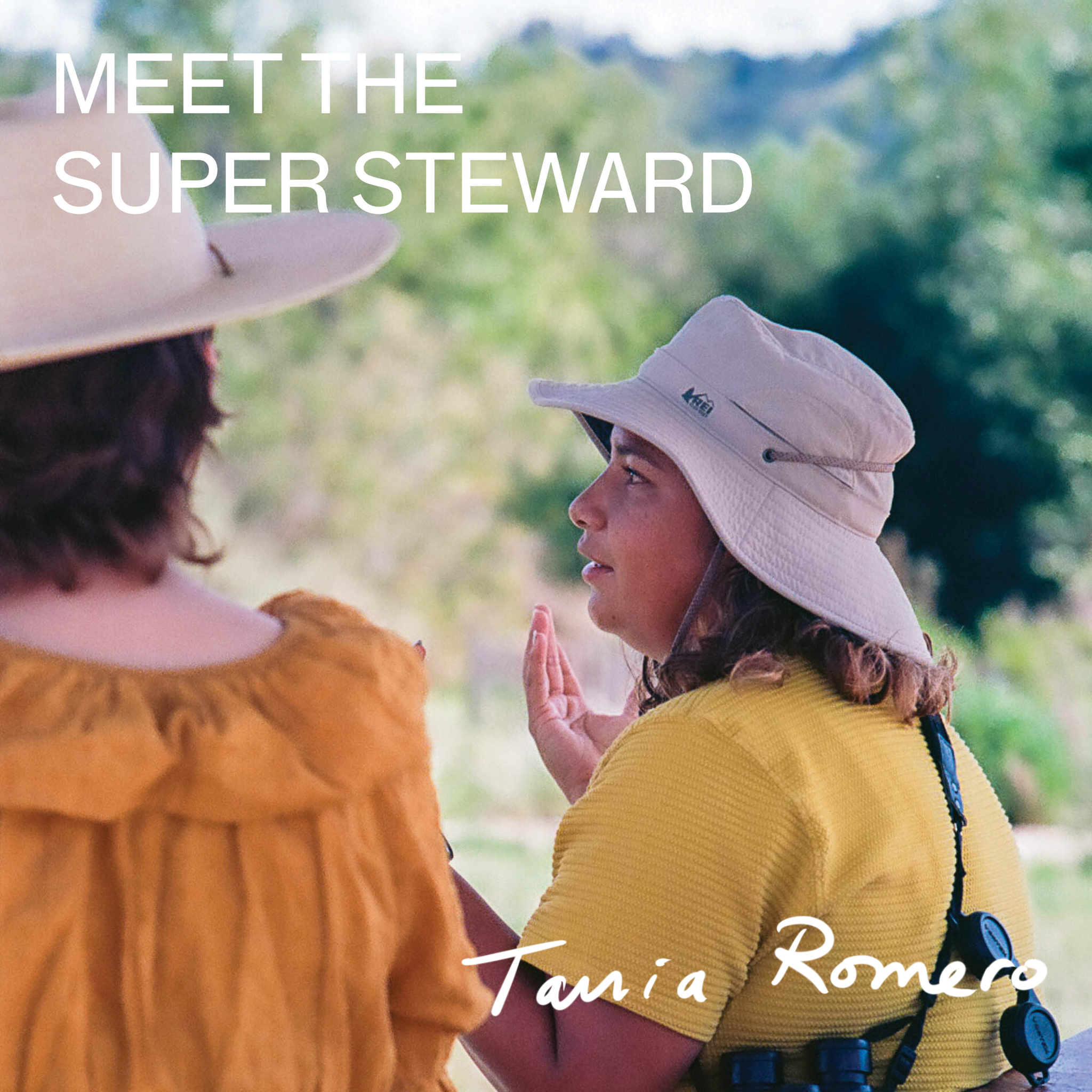
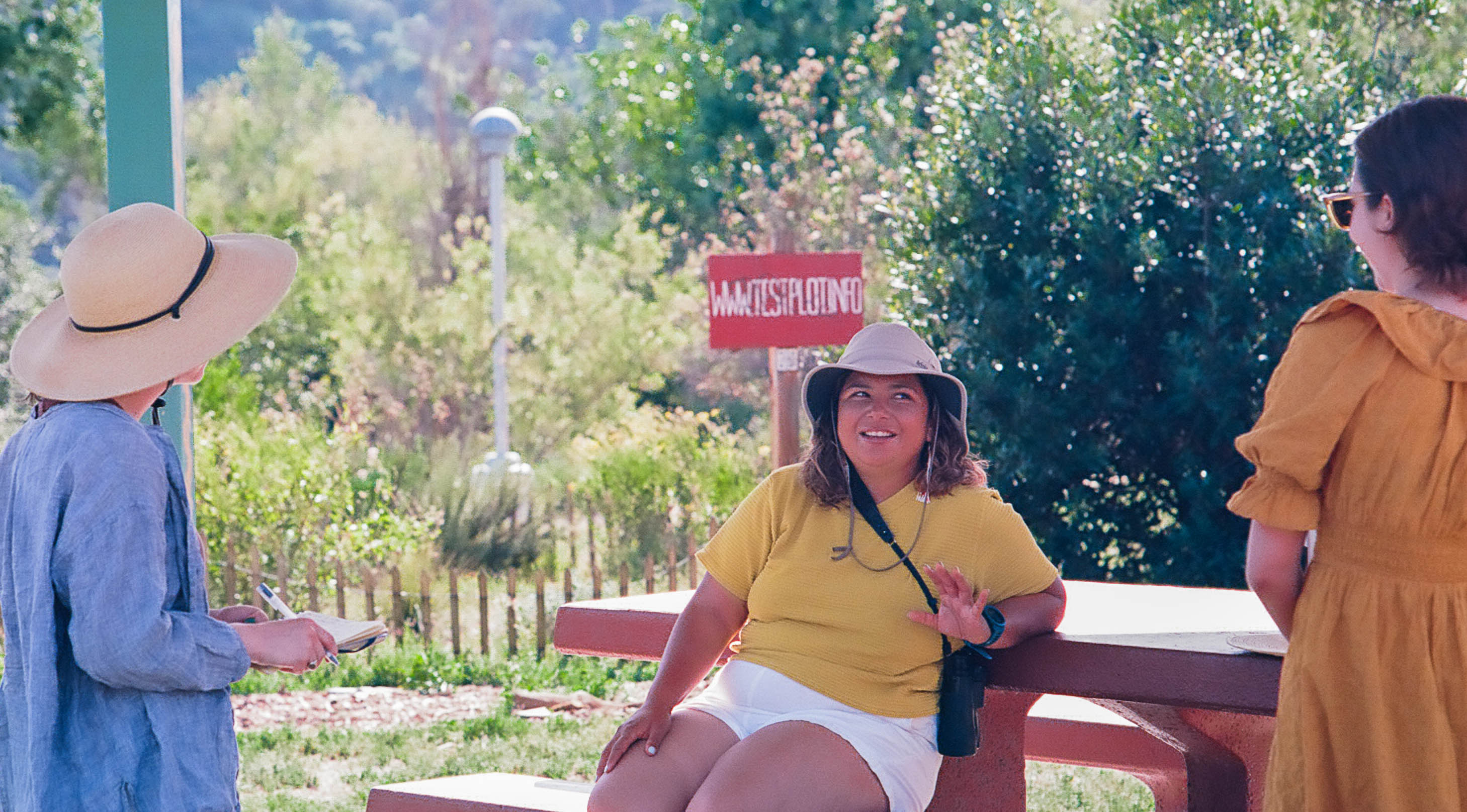
We met Tania Romero at the Rio de Los Angeles State Park Test Plot on a sunny spring day. While Tania played an important role in shaping the plant palette for the naturalized portion of the park, our conversation with her focused on a different subject; who makes up arguably one of the biggest groups of the park’s users: the birds. When developing the plant palette, Tania researched what plant and bird species could be found within a 5-mile radius of the park, and went from there.
Tania works as an environmental consultant, performing bird surveys for electrical pole replacement operations, making sure that a pole due for maintenance is not the current home of nesting birds or any species with special status. The beauty of consulting, she explains, is its flexibility: while she’s “more of a bird person”, she also gets to learn about mammals and plants, and how they all fit into the whole picture.

Tania has always been curious about how the whole picture comes together. Growing up in South Central, there wasn’t much nature around, she recounted. Her mom believed nature was important to experience, so many of her foundational childhood experiences involved trips to places like Pasadena and Azusa, to experience the mountains and rivers. Once, on a trip to the San Diego Zoo, Tania saw a monkey climb on a hippo’s back. This small interaction grew into a bigger curiosity in college - why do animals behave the way they do?
In the outdoors and conservation field in general, Tania always felt like an outsider. She often found herself reflecting on her childhood experience and questioning “Why was there limited green space and nature where she was raised in south central Los Angeles?“ As she got deeper into her studies, she came across environmental racism and began to understand why. She also found herself dwelling further into social justice including worker’s rights, gender and sexuality issues, and racism. Although she had a passion for conservation, she found herself questioning how she focused on conservation when there were multiple other social issues that impacted her everyday life and her community.

Currently, Tania runs a bird banding station at Bear Divide, in the foothills of the Angeles National Forest. Accessible only by car, the station is anything but immediately located for most people and station visitors. The greater Bear Divide area is used by dedicated birders and hikers. For many of people visiting the station, it is their first time touching birds or seeing them up close. Her long-term dream is to open a bird observatory that balances community and research.
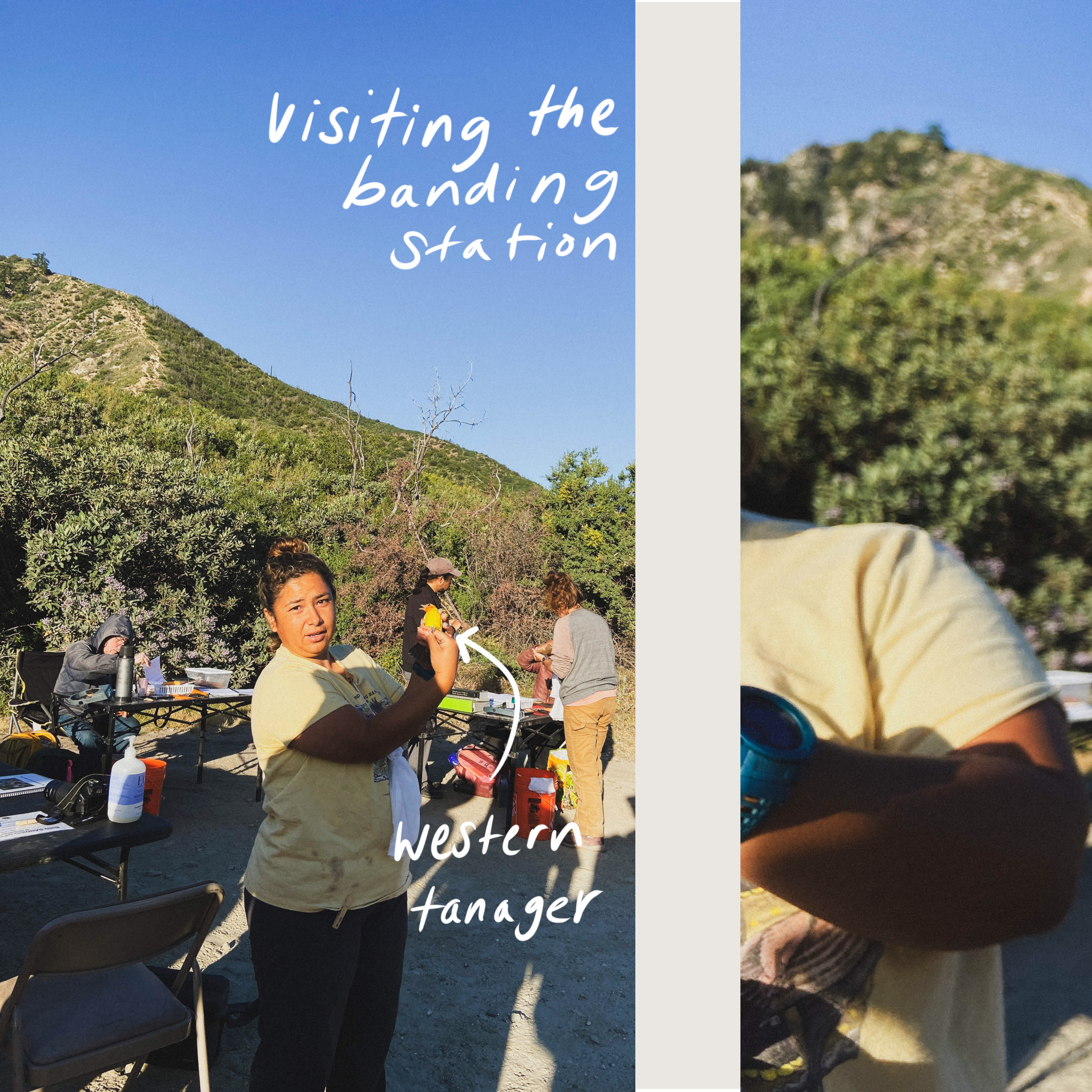
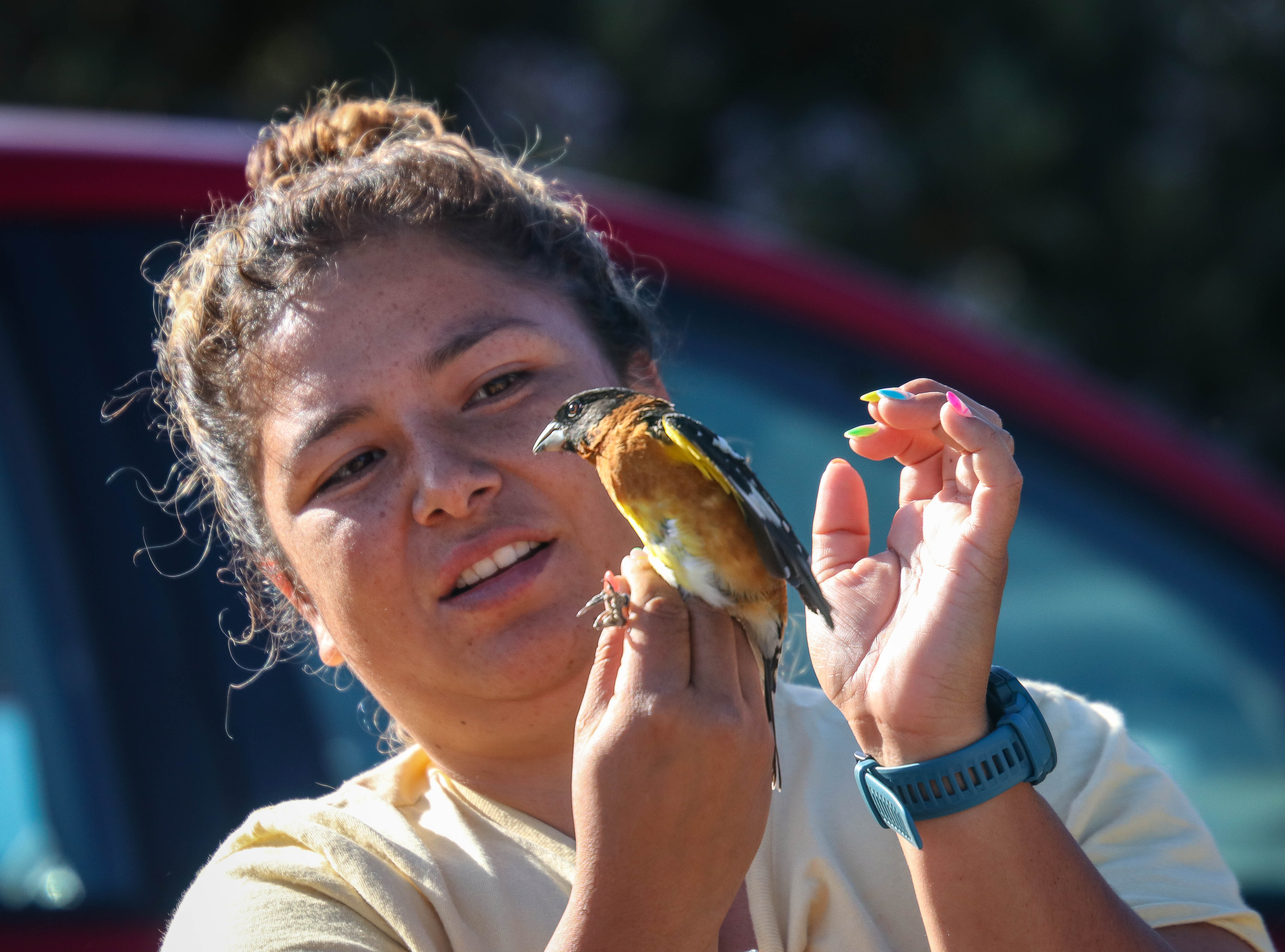
Balancing community and science is a challenge, she tells us, as people often underestimate the work that goes into building a sense of stewardship. Building a relationship with volunteers and the community should be intentional. For example, for restoration events that require volunteers, we should ask “ Why should someone volunteer at this event and work this land?” Tania suggests reaching out to local partnerships that are already involved in the community or within the community such as community partners and schools, to build mutual understanding and deliver a message with a foundation of trust and understanding. Building trust however is work, often becomes an afterthought, and is reduced to posting a flier in hopes that the right people will see it. Or worse, she explains: as a person of color, employers will expect her to “know diversity” and will throw inclusion work to her even when it is not part of her job card.
But to take the effort to engage people - to understand their wants and needs, and to teach them how they relate to nature - is absolutely worth it, she explains. One of the most validating experiences is when volunteers show up, especially repeatedly, because then it’s clear that the work means something to everyone involved. Her goal is to branch out of common narratives of conservation, to value and incorporate new narratives and new sources of knowledge when it comes to restoration work. By incorporating new narratives and accepting new experiences, we become more inclusive of everyone in the community. One example in restoration work is including the stories of gardeners, farmers, and Indigenous people who know so much about how the land works - but because they may not have the specific vocabulary associated with restoration work, their knowledge is overlooked.
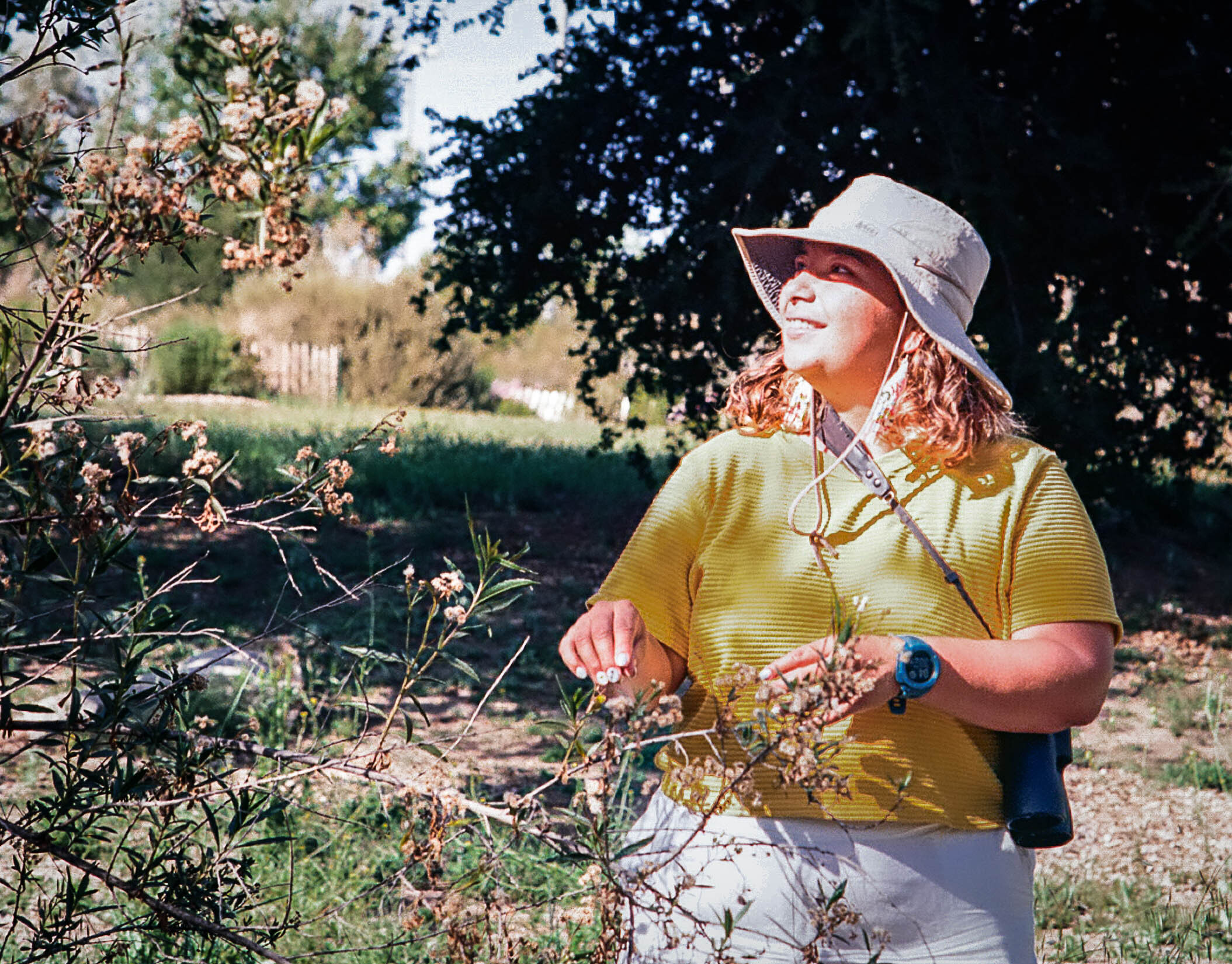
Not only does Tania hope that this evolving model of restoration and stewardship will become more and more prevalent - she is actively working to make it happen. When asked who she would like to share her restoration work with, her answer looked towards the past: she would want to share it with her grandmother, who passed away when Tania was 10 years old. Tania’s family members in Mexico have told her that her grandmother was just like her - she loved birds and bright colors. She would want to share this understanding with her grandmother, and maybe gain some understanding in return - about how we have built this passion and love in our veins.
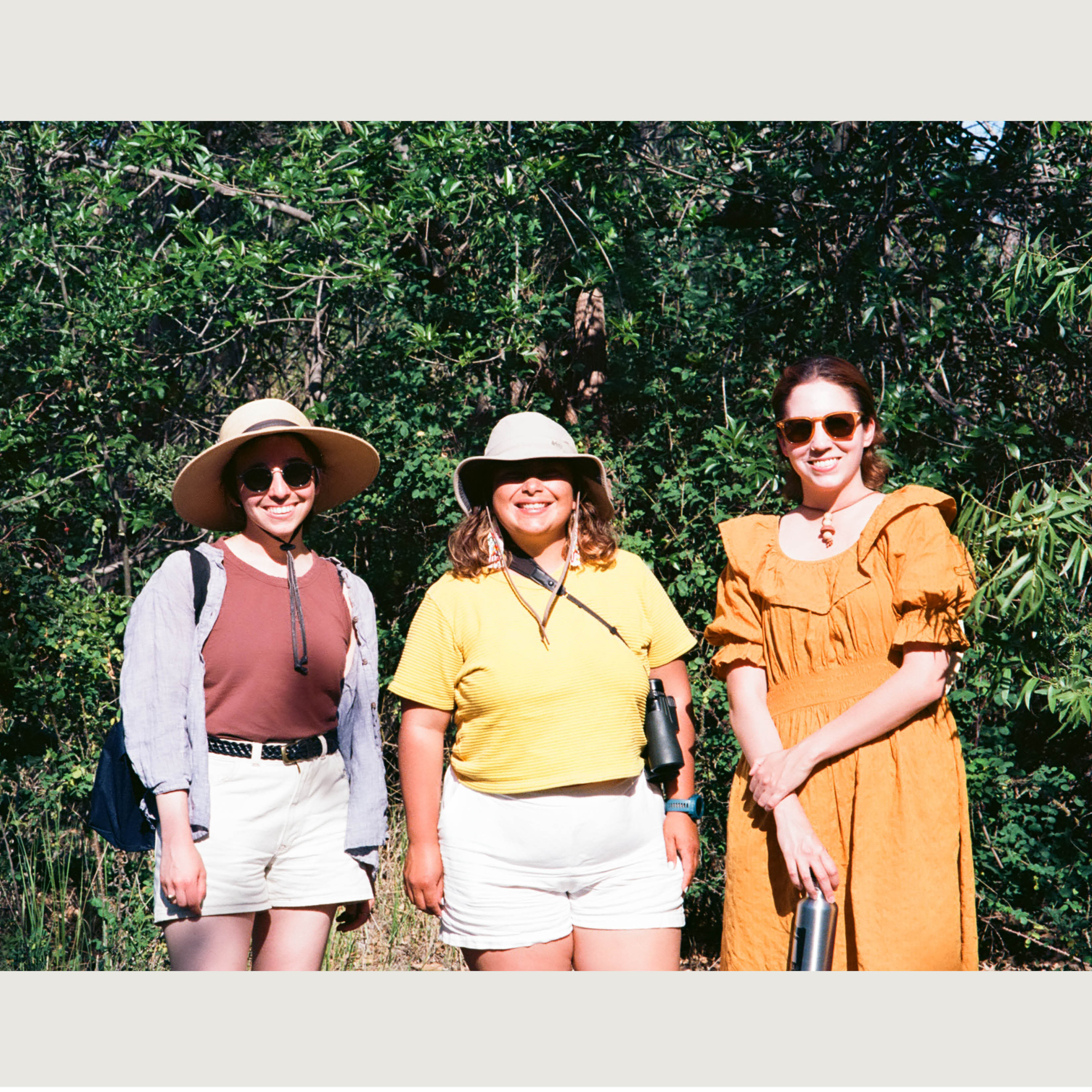 Thanks so much for sharing your story with us Tania!
Thanks so much for sharing your story with us Tania! Photos by the talented Robert Flynn
DANTE INIGUEZ + ANTHONY MARTIN,
LOS ANGELES SUPER STEWARDS
Elysian Park
By Daniela Velazco & Hannah Flynn
current and former Test Plot interns
We are Dani and Hannah, current and former Test Plot interns. Starting in early 2022, we conducted a series of seven interviews with “Super Stewards” - members of the Test Plot community who are stewards of community and of the environment. Our conversations covered personal histories, what it means to be a steward, and what the future of community-tended green space can be.
![]()
We met Dante Iniguez and Anthony Martin at the Elysian Park Test Plot on a chilly late afternoon as they were watering what was at the time the newest plot, a plot mostly filled with wildflowers grown from seed. Dante and Anthony are more than regular volunteers at Elysian Park - their reliable presence is a pillar of the Test Plot.
![]()
Dante, a designer, and Anthony, a microbiologist, live in an apartment together with no room for a garden to tend to. Dante spent formative years in San Luis Obispo, where widespread native plants and protected nature areas instilled a deep appreciation for the nature of California. Anthony’s parents, immigrants from the Philippines, took him camping frequently throughout the state as a child. His father developed his own deep connection to the land by studying agriculture, a connection that was practically “genetically transferred” to Anthony, citing his father’s own interest in agriculture.
![]()
They were both drawn to the opportunity to be outdoors and work with people with similar values to theirs. In spending so many hours working, they quickly bonded with the plots. Dante’s reasoning behind his choice of favorite plant in the plots, the Manzanita, reflects this: they are “really sculptural, beautiful….[and] unique”, but they also take a long time to grow”.. Anthony’s favorite part of the plots isn’t a plant, but the whole picture - including the soil in which the plants grow. He’s “excited by…the idea of creating habitat and returning the land to how it needs to be.” He draws a comparison with his work studying gut microbiomes: like our own digestive systems that power us, “there’s a whole ecology of microbiomes that affect the soil’s health.”
Spending quality hands-on time with the plots has taught them a lot. Anthony feels that he’s getting to see the life he studies in the lab “being its full self outdoors”, understanding how plants interact with each other and with the climate. Test Plot has become like “a game”, experimenting with parameters like pH and soil composition to see how plants will grow – or not. And it’s not just the volunteers who get to learn: as people walk by, they get curious and ask about them. These interactions have the potential to be valuable opportunities to help people who aren’t as exposed to ecology “understand the value of what [Test Plot is about] and why native plants are better than other plants.”
![Wild mustard growing on the hill]()
![Test Plot planted with native species]()
Dante and Anthony strongly believe exposure leads to understanding, which leads to an appreciation of ecological systems much larger than the Test Plots themselves: a greater understanding of how our gardens connect to the broader ecological context of the city, to “our food systems, the clothes we wear, and where [that all] is coming from.” An understanding that our plant palettes “can be aesthetic and still building an ecology.”
![]()
Who would benefit from this hands-on exposure? A lot of people are already showing their desire to work with plants, say Dante and Anthony, citing beautiful balcony gardens that they’ve noticed hanging down from apartment balconies throughout the city. If apartment gardeners had a plot to care for, they would bond to it, just like Dante and Anthony did. Neglected public spaces - like the mustard-filled spots at Elysian before the plots were established - are a “missed opportunity to give the land back to the people” so that they can get their hands dirty and build that connection, plant by plant.
![]() Thank you, Anthony and Dante
Thank you, Anthony and Dante
Photos by Robert Flynn
LOS ANGELES SUPER STEWARDS
Elysian Park
By Daniela Velazco & Hannah Flynn
current and former Test Plot interns
We are Dani and Hannah, current and former Test Plot interns. Starting in early 2022, we conducted a series of seven interviews with “Super Stewards” - members of the Test Plot community who are stewards of community and of the environment. Our conversations covered personal histories, what it means to be a steward, and what the future of community-tended green space can be.

We met Dante Iniguez and Anthony Martin at the Elysian Park Test Plot on a chilly late afternoon as they were watering what was at the time the newest plot, a plot mostly filled with wildflowers grown from seed. Dante and Anthony are more than regular volunteers at Elysian Park - their reliable presence is a pillar of the Test Plot.
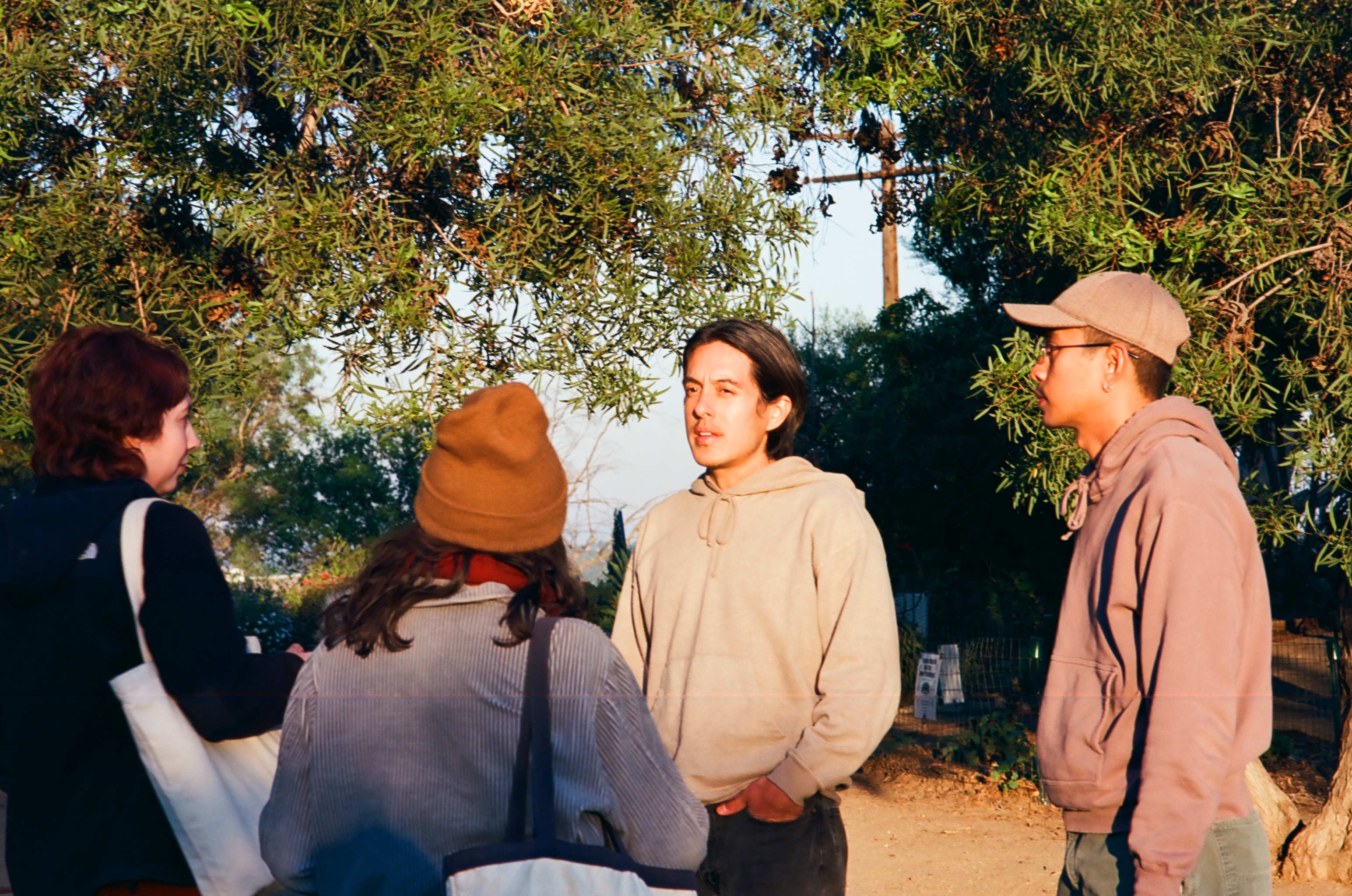
Dante, a designer, and Anthony, a microbiologist, live in an apartment together with no room for a garden to tend to. Dante spent formative years in San Luis Obispo, where widespread native plants and protected nature areas instilled a deep appreciation for the nature of California. Anthony’s parents, immigrants from the Philippines, took him camping frequently throughout the state as a child. His father developed his own deep connection to the land by studying agriculture, a connection that was practically “genetically transferred” to Anthony, citing his father’s own interest in agriculture.

They were both drawn to the opportunity to be outdoors and work with people with similar values to theirs. In spending so many hours working, they quickly bonded with the plots. Dante’s reasoning behind his choice of favorite plant in the plots, the Manzanita, reflects this: they are “really sculptural, beautiful….[and] unique”, but they also take a long time to grow”.. Anthony’s favorite part of the plots isn’t a plant, but the whole picture - including the soil in which the plants grow. He’s “excited by…the idea of creating habitat and returning the land to how it needs to be.” He draws a comparison with his work studying gut microbiomes: like our own digestive systems that power us, “there’s a whole ecology of microbiomes that affect the soil’s health.”
Spending quality hands-on time with the plots has taught them a lot. Anthony feels that he’s getting to see the life he studies in the lab “being its full self outdoors”, understanding how plants interact with each other and with the climate. Test Plot has become like “a game”, experimenting with parameters like pH and soil composition to see how plants will grow – or not. And it’s not just the volunteers who get to learn: as people walk by, they get curious and ask about them. These interactions have the potential to be valuable opportunities to help people who aren’t as exposed to ecology “understand the value of what [Test Plot is about] and why native plants are better than other plants.”
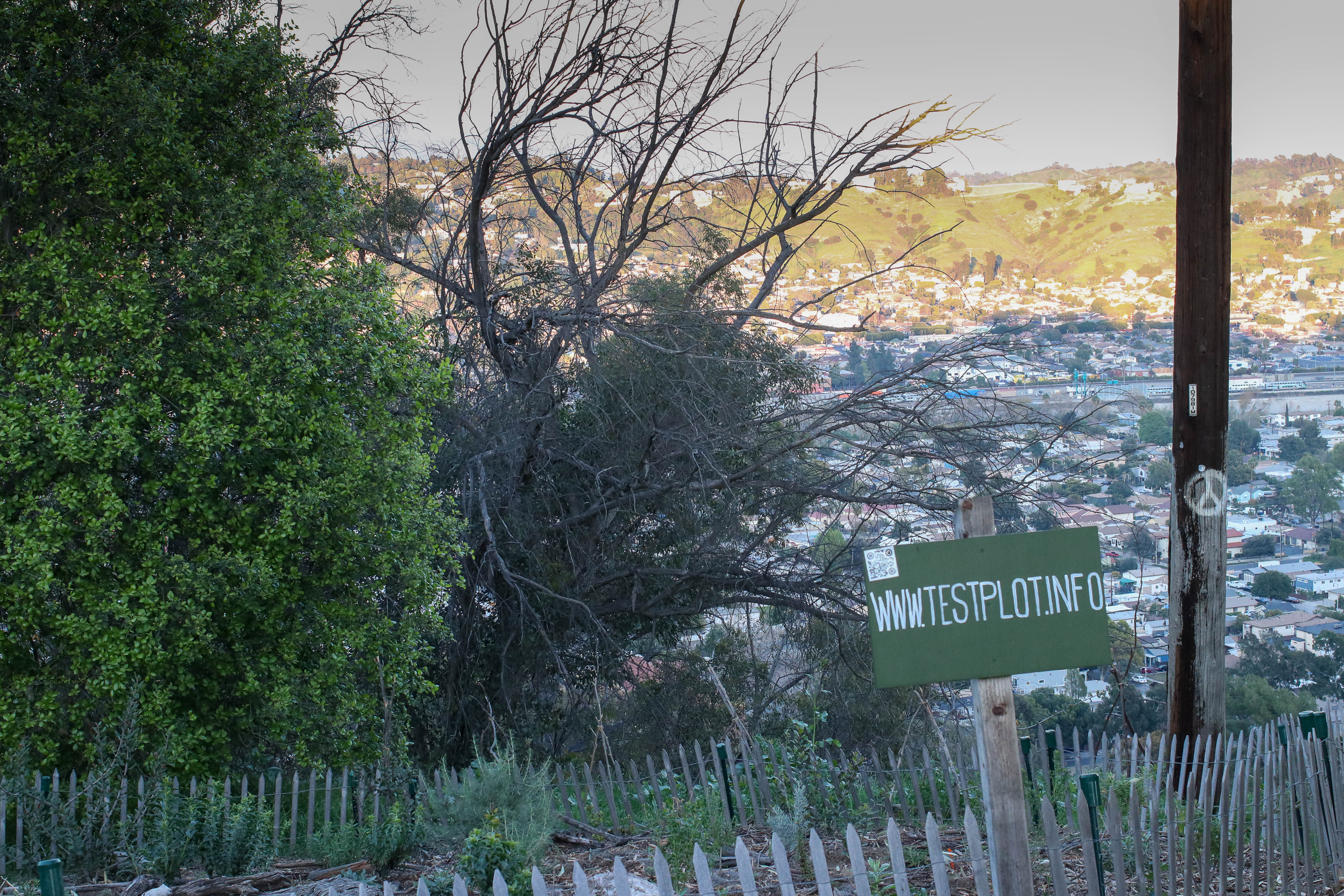
Dante and Anthony strongly believe exposure leads to understanding, which leads to an appreciation of ecological systems much larger than the Test Plots themselves: a greater understanding of how our gardens connect to the broader ecological context of the city, to “our food systems, the clothes we wear, and where [that all] is coming from.” An understanding that our plant palettes “can be aesthetic and still building an ecology.”
Who would benefit from this hands-on exposure? A lot of people are already showing their desire to work with plants, say Dante and Anthony, citing beautiful balcony gardens that they’ve noticed hanging down from apartment balconies throughout the city. If apartment gardeners had a plot to care for, they would bond to it, just like Dante and Anthony did. Neglected public spaces - like the mustard-filled spots at Elysian before the plots were established - are a “missed opportunity to give the land back to the people” so that they can get their hands dirty and build that connection, plant by plant.
 Thank you, Anthony and Dante
Thank you, Anthony and DantePhotos by Robert Flynn
LUIS RINCON, SUPER STEWARD
Rio de Los Angeles State Park
By Hannah Flynn & Dani Velazco
current and former Test Plot interns
Starting in early 2022, we conducted a series of seven interviews with “Super Stewards” - members of the Test Plot community who are stewards of community and of the environment. Our conversations covered personal histories, what it means to be a steward, and what the future of community-tended green space can be.
![]()
![Meet Luis Rincon, State Parks Community Engagement Coordinator]() Photos by Robert Flynn
Photos by Robert Flynn
Rio de Los Angeles State Park wasn’t always a park. For a long time, it was part of the Los Angeles River floodplain and agricultural fields. That is, until the massive Taylor Yard rail yard was constructed, roughly coinciding with the concretization of the Los Angeles River. It was operated as a rail yard until 1985, when it closed operations. To learn the story of how Rio became a park, we met with Luis Rincon, State Parks Community Engagement Coordinator, on an unusually warm and sunny winter day. We sat down together near the Test Plot, in the grass, soaking up the sun. According to Luis, the abuelas del Rio, longtime residents of the neighborhood and park volunteers, are to thank for their dedicated advocacy work to turn the brownfield into a park for their grandchildren to play.
The location was perfect: because of its proximity to the river, it could connect kids to the river, its ecology, and its part of the city’s history. The abuelas found an opportunity with California State Parks to turn this parcel of land into a park because of its significant natural value as a riparian zone. However, the abuelas and other community groups also wanted to have soccer fields and basketball courts, which State Parks does not administer, so the park is run as a partnership between the City of Los Angeles and State Parks.
Luis noted that on the administrative side, State Parks was keenly aware of a statewide relevancy problem: the people visiting their parks didn’t reflect the rich diversity of the state. The advocacy work of the abuelas aligned perfectly with State Parks’s own initiative to build more urban parks to “bring parks to the people.” As Luis started with State Parks, he was drawn to Rio because of the abuelas’ passion and vision of green space for their community. Getting to meet them and work with them was inspiring. “I remember when I first got here, everything in the landscape was small,” he recounted, underscored by the dappled shade provided by the now-mature toyon we sat beneath.
A native Angeleno himself, his connection to the outdoors began with family camping trips up near Yosemite. One of his earliest memories was jumping on a log and falling into a creek, a memory he associates with happy senses of freedom and being with family. Growing up in Northeast LA, Luis served as a community ambassador as part of a program called the Conservation Career Development Program (CCDP), a Student Conservation Association (SCA) program serving inner-city youth. Wanting to give back to his community, he switched to social work following college graduation. Eventually, he came to the realization that while social work was important and effective, community health is inextricably linked to open, green space, which brought him back to working with nature. And while situated in an urban setting, Rio’s 20 acres of nature is just enough to provide human health benefits and habitat benefits, such as creating habitat for an endangered bird, the Least Bell’s Vireo.
Working as an Community Engagement Coordinator for State Parks, Luis is able to build community and expand who gets to benefit from access to nature. He insists that he can’t do it alone, that it’s “always about finding the right partners who have aligned thinking.” Through partnerships with organizations such as the Audubon Society and Test Plot, he’s able to organize more resources for the community, in turn strengthening the community’s relationship with the park. “It’s not just about parks, it’s about the people. The abuelas didn’t know that they would set 100 acres [as in the 100 Acre Partnership] in motion in Los Angeles where real estate is at a premium…it is always about just taking that first step.” The abuelas could not have imagined the long-term impacts to the nation’s second-largest city that their green advocacy work catalyzed.
Rio de Los Angeles State Park
By Hannah Flynn & Dani Velazco
current and former Test Plot interns
Starting in early 2022, we conducted a series of seven interviews with “Super Stewards” - members of the Test Plot community who are stewards of community and of the environment. Our conversations covered personal histories, what it means to be a steward, and what the future of community-tended green space can be.

 Photos by Robert Flynn
Photos by Robert FlynnRio de Los Angeles State Park wasn’t always a park. For a long time, it was part of the Los Angeles River floodplain and agricultural fields. That is, until the massive Taylor Yard rail yard was constructed, roughly coinciding with the concretization of the Los Angeles River. It was operated as a rail yard until 1985, when it closed operations. To learn the story of how Rio became a park, we met with Luis Rincon, State Parks Community Engagement Coordinator, on an unusually warm and sunny winter day. We sat down together near the Test Plot, in the grass, soaking up the sun. According to Luis, the abuelas del Rio, longtime residents of the neighborhood and park volunteers, are to thank for their dedicated advocacy work to turn the brownfield into a park for their grandchildren to play.
The location was perfect: because of its proximity to the river, it could connect kids to the river, its ecology, and its part of the city’s history. The abuelas found an opportunity with California State Parks to turn this parcel of land into a park because of its significant natural value as a riparian zone. However, the abuelas and other community groups also wanted to have soccer fields and basketball courts, which State Parks does not administer, so the park is run as a partnership between the City of Los Angeles and State Parks.
Luis noted that on the administrative side, State Parks was keenly aware of a statewide relevancy problem: the people visiting their parks didn’t reflect the rich diversity of the state. The advocacy work of the abuelas aligned perfectly with State Parks’s own initiative to build more urban parks to “bring parks to the people.” As Luis started with State Parks, he was drawn to Rio because of the abuelas’ passion and vision of green space for their community. Getting to meet them and work with them was inspiring. “I remember when I first got here, everything in the landscape was small,” he recounted, underscored by the dappled shade provided by the now-mature toyon we sat beneath.
A native Angeleno himself, his connection to the outdoors began with family camping trips up near Yosemite. One of his earliest memories was jumping on a log and falling into a creek, a memory he associates with happy senses of freedom and being with family. Growing up in Northeast LA, Luis served as a community ambassador as part of a program called the Conservation Career Development Program (CCDP), a Student Conservation Association (SCA) program serving inner-city youth. Wanting to give back to his community, he switched to social work following college graduation. Eventually, he came to the realization that while social work was important and effective, community health is inextricably linked to open, green space, which brought him back to working with nature. And while situated in an urban setting, Rio’s 20 acres of nature is just enough to provide human health benefits and habitat benefits, such as creating habitat for an endangered bird, the Least Bell’s Vireo.
Working as an Community Engagement Coordinator for State Parks, Luis is able to build community and expand who gets to benefit from access to nature. He insists that he can’t do it alone, that it’s “always about finding the right partners who have aligned thinking.” Through partnerships with organizations such as the Audubon Society and Test Plot, he’s able to organize more resources for the community, in turn strengthening the community’s relationship with the park. “It’s not just about parks, it’s about the people. The abuelas didn’t know that they would set 100 acres [as in the 100 Acre Partnership] in motion in Los Angeles where real estate is at a premium…it is always about just taking that first step.” The abuelas could not have imagined the long-term impacts to the nation’s second-largest city that their green advocacy work catalyzed.



Thank you so much for sharing your time and experience with us, Luis!
MEET THE SUPER STEWARDS!
2022-2023
By Hannah Flynn & Dani Velazco
current and former Test Plot interns
We are Dani and Hannah, current and former Test Plot interns. Starting in early 2022, we conducted a series of seven interviews with “Super Stewards” - members of the Test Plot community who are stewards of community and of the environment. Our conversations covered personal histories, what it means to be a steward, and what the future of community-tended green space can be.
![]()
Once a month for the rest of the year, we are going to share write-ups, photos, and audio recordings of these conversations. This post will update whenever a new write-up is posted.
July 2023: Luis Rincon
August 2023: Dante Iniguez & Anthony Martin
![]()
![]()
![]()
![]()
Photos by Robert Flynn
2022-2023
By Hannah Flynn & Dani Velazco
current and former Test Plot interns
We are Dani and Hannah, current and former Test Plot interns. Starting in early 2022, we conducted a series of seven interviews with “Super Stewards” - members of the Test Plot community who are stewards of community and of the environment. Our conversations covered personal histories, what it means to be a steward, and what the future of community-tended green space can be.

Once a month for the rest of the year, we are going to share write-ups, photos, and audio recordings of these conversations. This post will update whenever a new write-up is posted.
July 2023: Luis Rincon
August 2023: Dante Iniguez & Anthony Martin
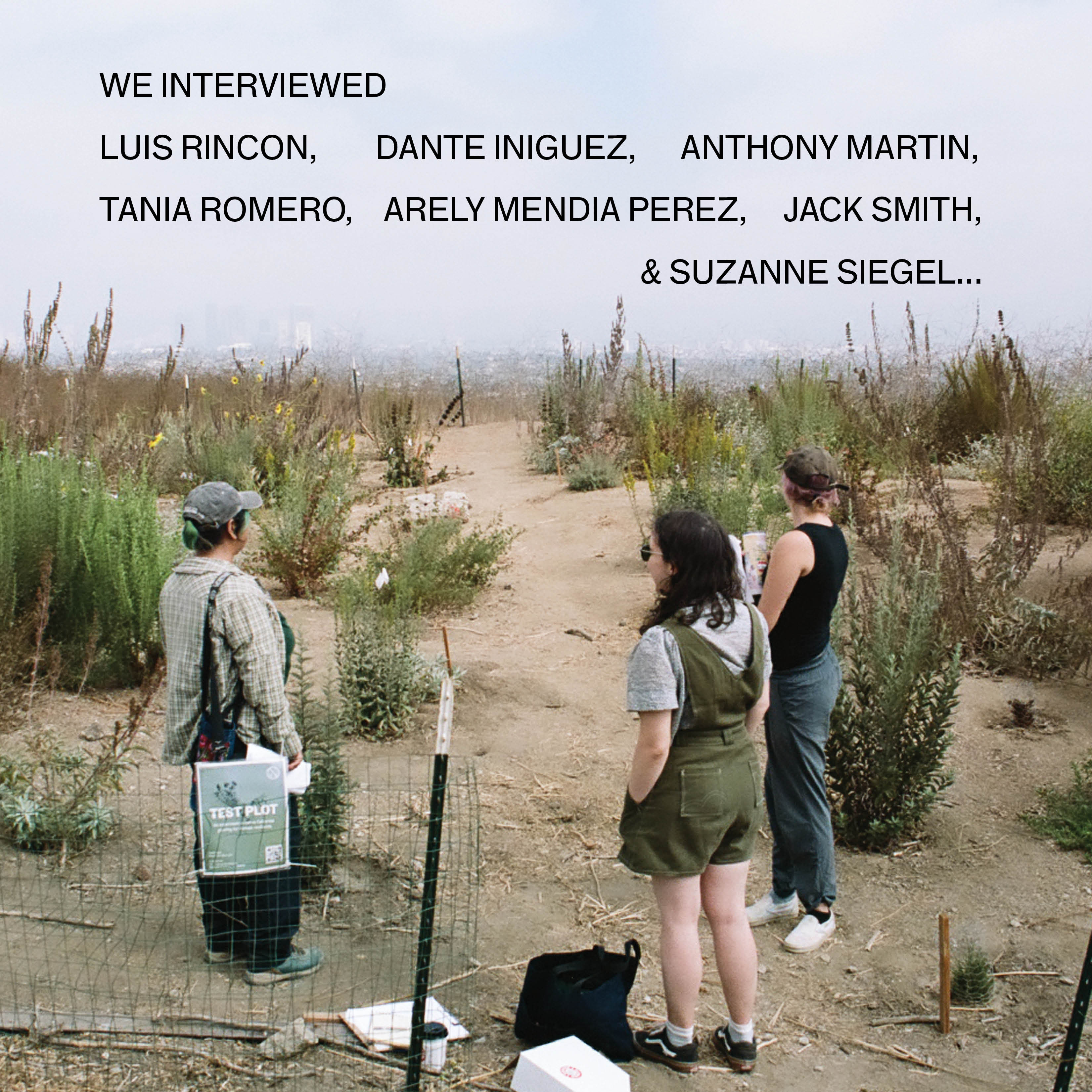


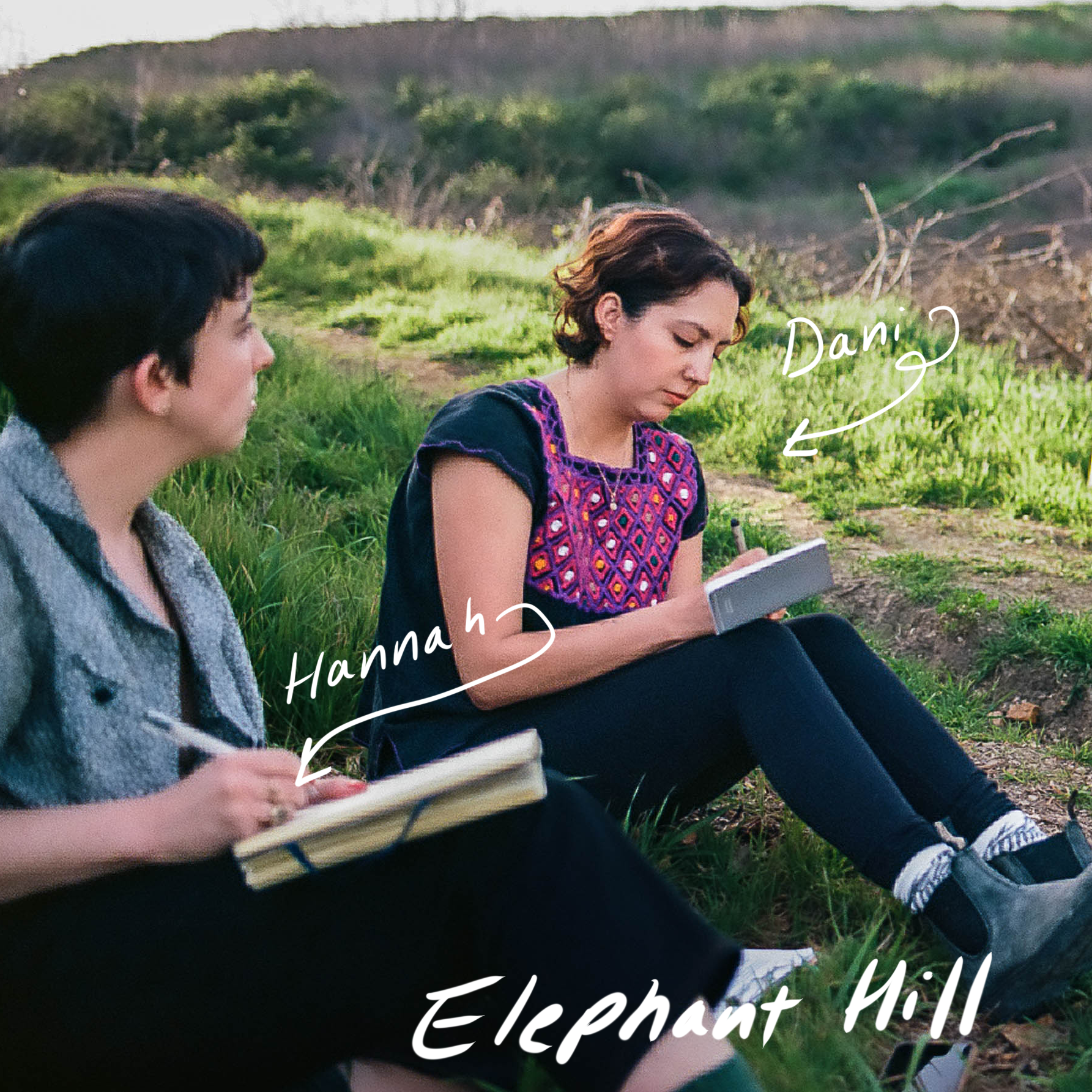
Photos by Robert Flynn
Visit 11/21/2024
San Francisco TEST PLOT/ November 2024
TERREMOTO SF
EF
San Francisco TEST PLOT/ November 2024
TERREMOTO SF
TIME: 11:00am
DATE: November 21, 2024
TEMP: 60 degrees
WEATHER: in between rains, windy
WIND (SPEED/DIRECTION): 15 mph wind from the SW
SOIL MOISTURE: wet thanks to the rain!
PLANTS SIGHTINGS: poppy, eriogonum nudum
WEED SIGHTINGS: clover is starting to come up with a vengence
WILDFLIFE SIGHTINGS: not much this week
HUMAN ACTIVITY: just me and Evita
GENERAL NOTES: the rains have flattened the grasses of last season, revealing rocky soils and new plant life. we planted 18 stipa pulchra plugs and with these rains hopefully they will take hold! only time will tell
DATE: November 21, 2024
TEMP: 60 degrees
WEATHER: in between rains, windy
WIND (SPEED/DIRECTION): 15 mph wind from the SW
SOIL MOISTURE: wet thanks to the rain!
PLANTS SIGHTINGS: poppy, eriogonum nudum
WEED SIGHTINGS: clover is starting to come up with a vengence
WILDFLIFE SIGHTINGS: not much this week
HUMAN ACTIVITY: just me and Evita
GENERAL NOTES: the rains have flattened the grasses of last season, revealing rocky soils and new plant life. we planted 18 stipa pulchra plugs and with these rains hopefully they will take hold! only time will tell
EF
South Hill Plot
Visit 7/09/24
San Francisco TEST PLOT/ June 2024
TERREMOTO SF
TR
San Francisco TEST PLOT/ June 2024
TERREMOTO SF
TIME: 4:12 pm
DATE: June 12, 2024
TEMP: 66 degrees
WEATHER: warm and windy. a few clouds
WIND (SPEED/DIRECTION): 12.3 mph wind from the SW
SOIL MOISTURE: dry :/
PLANTS SIGHTINGS: new buckwheat on the hill
WEED SIGHTINGS: lots of mustard it looks like?
WILDFLIFE SIGHTINGS: not much this week
HUMAN ACTIVITY: just me
GENERAL NOTES: dry and tawny, exciting to see new growth pop up
DATE: June 12, 2024
TEMP: 66 degrees
WEATHER: warm and windy. a few clouds
WIND (SPEED/DIRECTION): 12.3 mph wind from the SW
SOIL MOISTURE: dry :/
PLANTS SIGHTINGS: new buckwheat on the hill
WEED SIGHTINGS: lots of mustard it looks like?
WILDFLIFE SIGHTINGS: not much this week
HUMAN ACTIVITY: just me
GENERAL NOTES: dry and tawny, exciting to see new growth pop up
TR
South Hill Plot

Pine Plot

Bluff

Buckwheat

Visit 5/22/24
San Francisco TEST PLOT/ May 2024
TERREMOTO SF
![]()
ER + SS
San Francisco TEST PLOT/ May 2024
TERREMOTO SF

ER + SS
South Hill Plot
![Poppies!]()
![A new weed in the south plot? or is it native dandelion?]()
![North Pine Plot]()
![]()
![Yellow Mariposa Lilly, Calchortus luteus]()
![Big holes in Pine plot and East Bluff Plot]()
![East Bluff Plot]()
![Blue Dicks going to seed, Ladybugs pupating in the flower husks!]()
![]()
![]()
![Desert Parsley in the DeHaro Street area of Starr King]()
![Some kind of Clarkia, seen throughout Starr King]()








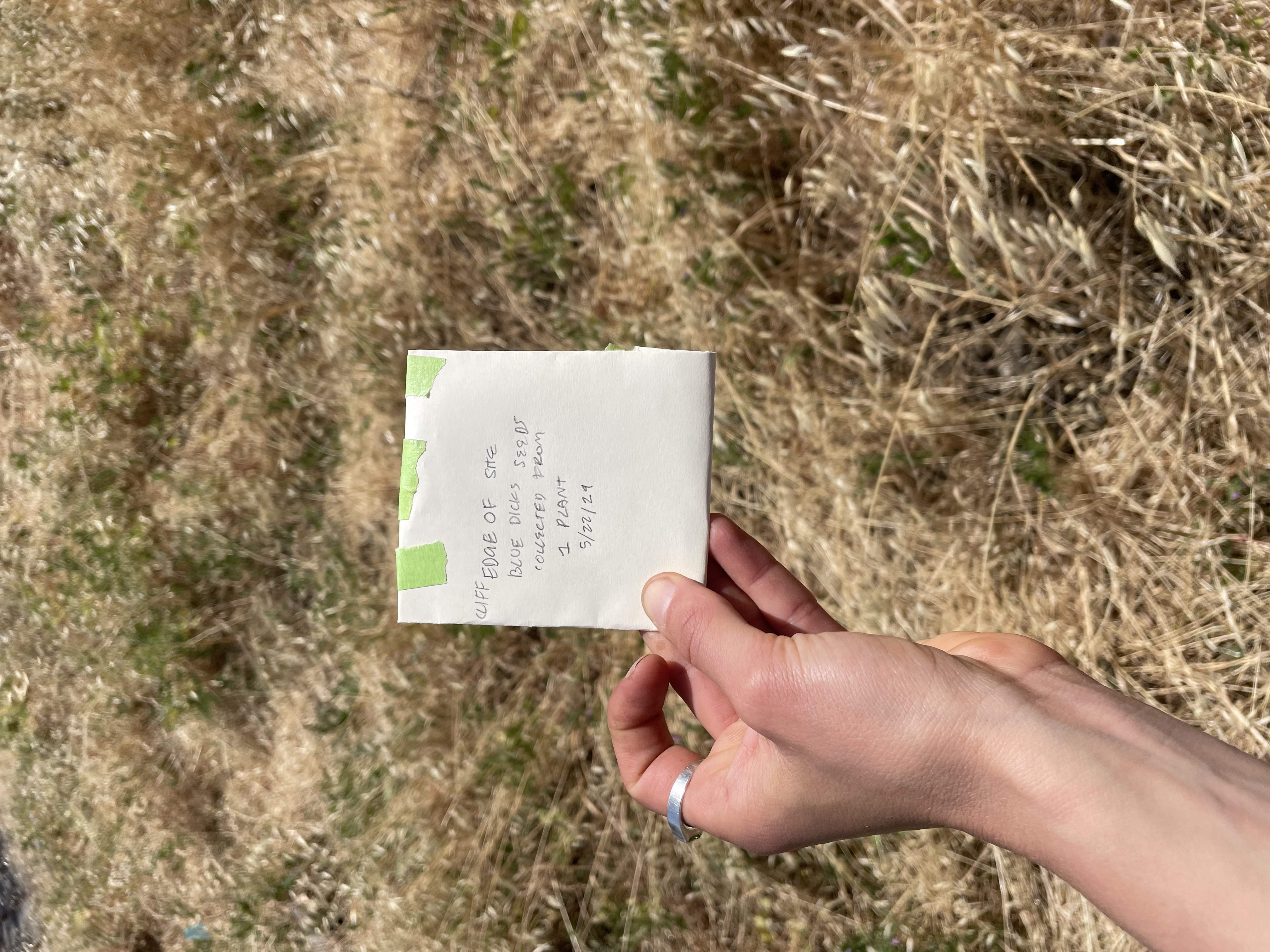



Visit 5/17/24
San Francisco TEST PLOT/ May 2024
TERREMOTO SF
TR + AP
San Francisco TEST PLOT/ May 2024
TERREMOTO SF
TIME: 11:30 am
DATE: May 17, 2024
TEMP: 58 degrees
WEATHER: feels much warmer than it is
WIND (SPEED/DIRECTION): 6.1 mph wind from the NE
SOIL MOISTURE: drydrydry
PLANTS SIGHTINGS: usual suspects and some new calochortus which is exciting
WEED SIGHTINGS: lots of vetch and mallow per usual. Do we keep noting Vetch as a weed?
WILDFLIFE SIGHTINGS: bees and a coyote
HUMAN ACTIVITY: just Alain and I
GENERAL NOTES: dry and tawny, exciting to see new growth pop up
DATE: May 17, 2024
TEMP: 58 degrees
WEATHER: feels much warmer than it is
WIND (SPEED/DIRECTION): 6.1 mph wind from the NE
SOIL MOISTURE: drydrydry
PLANTS SIGHTINGS: usual suspects and some new calochortus which is exciting
WEED SIGHTINGS: lots of vetch and mallow per usual. Do we keep noting Vetch as a weed?
WILDFLIFE SIGHTINGS: bees and a coyote
HUMAN ACTIVITY: just Alain and I
GENERAL NOTES: dry and tawny, exciting to see new growth pop up
TR + AP
South Hill Plot
![]()


East Bluff Plot

CALOCHORTUS

coyote friend with red eyes? we escaped unscathed

big ol mallow

Visit 4/19/24
San Francisco TEST PLOT/ April 2024
TERREMOTO SF
EF
San Francisco TEST PLOT/ April 2024
TERREMOTO SF
TIME: 4:30pm
DATE: May 8, 2024
TEMP: 77 degrees
WEATHER: humid heat, but not a cloud in the sky
WIND (SPEED/DIRECTION): breeze coming from NW, it is welcomed
SOIL MOISTURE: dry!
PLANTS SIGHTINGS: a couple of new lupine, dot plantain, poppies, artemisia californica, sticky monkey flower
WEED SIGHTINGS: all of the ones we’ve been seeing, plus dandelion
WILDFLIFE SIGHTINGS: scrub jays, bees on the clover, evidence of gophers from their holes, yellow swallowtail butterfly
HUMAN ACTIVITY: mainly the sounds of kids in the school yard, no one has passed through the annex except me
GENERAL NOTES: it is so dry all of a sudden! vetch appears to be making a come back in the east bluff plot after we gave the grasses a haircut last week. weeds have reappeared in the south hill plot. TALL grasses in the north pine plot. everything is tawny except for the vetch and the natives. it feels like summer already.
DATE: May 8, 2024
TEMP: 77 degrees
WEATHER: humid heat, but not a cloud in the sky
WIND (SPEED/DIRECTION): breeze coming from NW, it is welcomed
SOIL MOISTURE: dry!
PLANTS SIGHTINGS: a couple of new lupine, dot plantain, poppies, artemisia californica, sticky monkey flower
WEED SIGHTINGS: all of the ones we’ve been seeing, plus dandelion
WILDFLIFE SIGHTINGS: scrub jays, bees on the clover, evidence of gophers from their holes, yellow swallowtail butterfly
HUMAN ACTIVITY: mainly the sounds of kids in the school yard, no one has passed through the annex except me
GENERAL NOTES: it is so dry all of a sudden! vetch appears to be making a come back in the east bluff plot after we gave the grasses a haircut last week. weeds have reappeared in the south hill plot. TALL grasses in the north pine plot. everything is tawny except for the vetch and the natives. it feels like summer already.
EF
South Hill Plot
![]()
East Bluff Plot
gopher holes
coyotes???
LUPINUS SUCCULENTUS!
